- Discover Branson's Finest Hiking Trails
- 15 Offbeat Digital Nomad Destinations You Need to Visit Now
- Cancun vs. Tulum - Which Should You Visit Next?
- How to Play Video Games as You Travel the World
- 21 Unusual Places to Visit in Poland You Must See
- The Best Cenotes in the Riviera Maya
- Work With Us

Our Travelwifi Review (formerly Tep): Hello Travel WiFi, Goodbye Roaming Charges
This is our honest Travelwifi review , based on a few years of use.
Updated in 2023! Tep has rebranded to the Travelwifi brand, with a new website, and new pricing and plans. We’ve updated this post with the new info.
See prices here.
The Travelwifi dongle was originally called Tep Wireless, but they rebranded a couple of years ago. We refer to it as the Tep occasionally this review, but it’s officially called the Travelwifi pocket Wi-Fi.
We first tested the original Travelwifi device a few years ago, but have now switched to the faster new Travelwifi Sapphire 2. Everything we talk about in article is up to date and refers to the newest Travelwifi model – the sticker on the device says Tep, but the Wi-Fi device is the exact same Sapphire 2 device Travelwifi rents and sells right now..
Good Internet access is a necessity for us. We need it for online learning, for keeping our business running, and to keep us connected when we travel. Without the Internet, this blog would grind to a halt. Plus, we use WiFi to keep in touch with family and friends, and stream TV and movies in our downtime.
Getting good Internet is a constant struggle. Using data roaming can cost a fortune. Airport WiFi is often expensive, and slow with short time limits, restaurant WiFi is hit and miss at best, and hotel WiFi is weak and spotty. Buying a local SIM card requires an unlocked phone, and can be a hassle.
Looking for something a little different? Check out the other travel wifi hotspots that we’ve reviewed.
- GoLocal Me review
- Skyroam Solis Review
- Keepgo Review
Travewifi wireless review
How do you beat expensive data roaming charges, hassling with local SIM cards, or scrounging WiFi at airports and restaurants?
Wouldn’t it be nice to have a portable, reliable, Internet that travels wherever you do, at a reasonable cost?
Oh wait, that does exist. And it’s called Travelwifi wirelesss hotspot.
Travewifi is a small, portable WiFi device that lets you bring your own Internet access with you wherever you go.
Get prices here.
Will it work anywhere in the world?
Not everywhere, but darn close. Travelwifi wireless works in the UK, Spain, France and most European countries. It also works great in the US, Canada, Mexico, Asia, the Middle East, South America, Central America, Oceania, and more plus they’re adding more countries all the time.
How do I get a Travelwifi hotspot?
You just go online, order your wireless device, and it is shipped to you, along with a handy pre-paid envelope for shipping.
So how does it work?
We got our Wi-Fi devicejust before we took off on a three week long road trip across Western Canada, with a bonus flight and week in New Hampshire in the USA.
I didn’t have a chance to look at the Tep until the night before we left, and I unboxed it and got it up and running within five minutes (including the time it took to make a video).
What did we think?
During our road trip, I was slammed with work, and the Travelwifi device was a godsend. It kept me connected, meaning that I could write blog posts, send invoices, and catch up on my email all while on the road.
The little Tep even saved my bacon late one night after a few days at the lake, when seven year old Jordan could only be soothed by Netflix when she was covered in itchy mosquito bites and couldn’t sleep.
Thank you Tep for that one, especially.
We took the Travel wifi from the West Coast of Canada, all the way to the center of Canada in Manitoba, plus a road trip through most of New Hampshire and then back home again. All in all, it was well over 50 hours of total driving time.
Since the Tep works off cellular data, we only hit a couple of small dead spots on our trip where we couldn’t get a WiFi signal, and those were where there was no cell signal to be found. One was in the Rocky Mountains in British Columbia, and that lasted about 20 minutes of our drive, and the other was a zone of about 30 minutes where we had a spotty connection in Saskatchewan. Given that Western Canada, and especially the Rocky Mountains, are known for spotty cell service, that’s pretty impressive.
2021 Update: We’ve had a little travewifi for almost three years now! We’ve used our travelwifi on multiple trips to Mexico and the United States, and within Canada, and it’s worked well every time. We’re now using the newest model, the Sapphire 2 4G LTE.
I liked my Travelwifi Wireless so much that we bought our own wifi device (you can rent or buy online) for whenever we travel.
How fast is the Travelwifi pocket wifi, really?
We gave the hotspot a week long trial during our last trip to Puerto Vallarta, Mexico.
Over the course of a week, the hotspot clocked in consistently at a speed over 30 Mbps. That’s a pretty good speed, rivaling a lot of broadband at home internet connections.
30 Mbps is fast to stream video on multiple devices, and plenty fast for email, phone calls, social media, and streaming. Tep itself says that the 4G speed is likely to be around 18.6 Mbps, but we’ve found our Tep 4G to be faster almost everywhere we’ve tested.
Does Travelwifi throttle your speed?
Travelwifi says that speeds will slow after you use up your plan amount (1GB, 3 GB, or 5 GB) on 4G plans in a 24 hour period. We found that our data speeds were still strong after using up our plan limit, but yours may vary.
After you use up your data limit, Travelwifi says your connection speed is throttled to a maximum of 256 kbs. At that speed you can still do social media, email, and light browsing. Your connection speed will return to normal the next day.
What we didn’t like
We had our Tep shipped to Canada, and also returned it from Canada. The shipping cost was relatively expensive ($21.95), but that’s unfortunately pretty standard when shipping to or from Canada.
Other countries are much cheaper. Getting a Travelwifi shipped to the USA costs only $8.00 for standard shipping. You can even pick up and drop off your Tep Wireless at some airports in France, the UK, and Mexico for free.
Who would the Travelwifi be good for?
Honestly, anyone who wants a stable Internet connection that travels with them wherever they go.
The Tep would be great for:
- anyone who wants to be able to video chat or keep in touch with family or business partners
- people like us, who work online, and need to be connected to keep their business up and running
- anyone who’s traveling through multiple countries, and who doesn’t want to deal with multiple country SIMs or data roaming charges
- anyone who wants a fast, easy solution to having WiFi when they travel
Should you use data roaming, a local SIM or get a WiFi hotspot?
Using data roaming on a cell is an alternative to WiFi, but roaming costs are notoriously high and even then you’re often limited to only one provider in another country. If you haven’t personally been hit with a sky-high roaming bill after a trip, it’s almost guaranteed that a close friend or family member has.
We used to buy local SIM cards when we travel, but it’s a huge hassle to determine which SIM to buy, tracking down a place to pick one up and overcome the language barrier. Plus, data limits and extra data charges can be a problem.
Get the price here.
What is the Tep price?
This looks like a pretty useful addition to the travel gear list! I could have done with one of these when cycling through Europe recently. I was really shocked with how bad WiFi access still is when staying in budget accommodation in Northern Europe, and it looks like this would have been perfect!
It’s a really good device that covers many countries that is important for a multicountry travel. TEP Wireless keeps the network connection secure and stable with a good speed of 7,2mbps and it is featured in a global mobile guide Savvy.one
Why are the pictures showing Skyroam device? Is the Tep wireless device just a brand labeled Skyroam?
Tep Wireless was using the same device but had it’s own SIM card and system. They now have their own device (it’s called the Teppy) however we haven’t tried it yet since the old device still works fine for us.
Sounds a little expensive at $9.95/day. Is that US$? Maybe ok if have business and deductible but for the average traveler, it would be too much – $300/month.
Ron, I think the idea is that you can share it with your travel partners (up to 5 devices at once) so the cost becomes more negligible. The Tep Wireless is also great if you’re bouncing between countries without having to grab a new SIM card in each country.
Lots of higher end hotels charge $8 or more a day for the use of their WiFi. Sometimes that’s per guest and doesn’t work outside your room, so $8.95 a day to rent one (the price has dropped) or $8 if you own the device to take it with you doesn’t sound too unrealistic.
Here in Canada, most companies charge $10 a day for out of country data and they have very low limits on the amount you can use and only certain providers they work with. Tep deals with multiple providers and I love how if you own the device, like we do, you can use it for 24 hours and then stop using it.
When we’re traveling, we often use it here and there as we need it rather than the entire duration to save on costs. That said, if we’re somewhere and need or want internet, we pull it out of our bag and voila, instant WiFi.
Would this work for deployed military??
I can’t speak for rental – but I bought a Skyroam hotspot through TEP 18 months ago. It never really worked properly. Most recently I was in Denmark and the device just froze at 15%. Apparently, this can be a software or firmware problem – but the company wasn’t; able to solve it and told me my device was defective and out of warranty. Part of the problem appears to be that there are no emails about updating your device routinely that go out to customers. So, you don’t know that you have a problem until you are on a trip – need Wi-Fi and are screwed. There are no links on the company website to software of firmware updates – you have to contact customer support – which makes no sense. Plus – you need to have a computer (connect to Wi-Fi) with you to perform the update – so it’s like a catch 22. Overall the customer support responds quickly but can’t really help you. Also keep in mind that they ask you for your order number for any help provided – so I would write that sucker down and paste it to the back of your device since you won’t be able to access any old emails about the order easily if you have problems. I’m going to try Keepgo instead – I’ve heard they have less technical problems.
Hi there! Wondering what your view is around data privacy when using this travel pocket wifi? thank you
It’s not any different than using a cell device frankly. Always a slight danger that something is eavesdropping but much higher chances it’s an existing app on your phone, tablet or Windows device than something built into this. You can always go with a VPN to make things even more secure if you want but it’s not something that overly concerns me to be honest and is likely much safer than using free public WIFI. Check out our post on VPN’s to see if you want to go the VPN route. https://www.thebarefootnomad.com/travel-tips/should-you-use-a-vpn-for-travel/
Leave a Reply Cancel reply
Your email address will not be published. Required fields are marked *
This site uses Akismet to reduce spam. Learn how your comment data is processed .
- Search Please fill out this field.
- Manage Your Subscription
- Give a Gift Subscription
- Newsletters
- Sweepstakes
We independently evaluate all of our recommendations. If you click on links we provide, we may receive compensation.
- Travel Products
- Tech Essentials
The 6 Best Portable Wi-Fi Hotspots of 2024
These handy devices keep you connected with ease.
:max_bytes(150000):strip_icc():format(webp)/Stefanie-Waldek-7eed18a8c9734cb28c5d887eb583f816.jpg)
In This Article
- Our Top Picks
- Tips for Buying
Frequently Asked Questions
- Why Trust T+L
Travel + Leisure / Marcus Millan
We're fortunate to live in an era where cell coverage reaches 95 percent of the population, according to the International Telecommunications Union. And that makes staying connected while traveling to most on-the-grid destinations a breeze. Many cell phone carriers offer some level of international data plans, which allows you to use your devices abroad — for a fee, of course.
But if you're working on the go, traveling in a group, or attempting to preserve your phone's battery, you might want to look into getting a portable Wi-Fi hotspot, which often provides more data to more devices. "Portable hotspots will use data just like cell phones do, and coverage will really depend on the carrier and the coverage they offer in the area," Best Buy mobile supervisor Thomas Walker told Travel + Leisure. "Since hotspots require data, they also require a plan, something to remember as you consider buying a portable hotspot."
Best Overall
Skyroam solis lite.
The device comes with a free lifetime global data plan.
1GB of monthly data will go by very quickly; you'll have to pay up for more.
There are many things the Simo Solis Lite does well, but the real showstopper here is the company's lifetime global data plan that gives you 1GB of data each month for as long as your device functions. And this plan truly is global, as the device works in 135+ different countries . That said, 1GB isn't much data at all. Depending on your usage, you might need to upgrade to a more robust data package, which typically costs anywhere from $6 to $109, or potentially more, per month. On the plus side, you don't need to change SIM cards in this hotspot — you can add those plans via an app.
As for the other stats with this device, the 16-hour battery life is well above average. We love that you can charge other devices with this hotspot — although that will reduce its battery life, of course. Up to 10 devices can be connected to the Solis Lite, which is likely suitable for most users, but it's an unremarkable number compared to other products on the market. Similarly, 4G connectivity is serviceable but doesn't earn any special accolades. If you're traveling with a large group of people, you may want to consider other options depending on how connected you need to be.
One other standout feature of this Wi-Fi hotspot is true 24/7 customer support — this is especially valuable for travelers who need internet access at all hours across various time zones.
The Details: 16-hour battery life | 10 devices | 4G connectivity | 5.98 x 4.69 x 1.73 inches | 10.2 ounces
Best for SIM Cards
Netgear nighthawk m6 pro.
It has Wi-Fi 6E connectivity.
13 hours of battery life is good, but not great.
If you need a fast and reliable internet connection just about anywhere, Netgear's Nighthawk M6 Pro might be the solution. It's compatible with AT&T, T-Mobile, and Verizon in the U.S., and it works in more than 125 countries when swapping in a new SIM card, supporting both 5G and Wi-Fi 6E. You can connect up to 32 devices simultaneously, allowing an entire team of remote workers to stay connected. And if you're on the move, you'll enjoy a more secure connection with the Nighthawk than public Wi-Fi.
Beyond its uses for remote work around the world, the Nighthawk M6 Pro could even replace a standard internet connection at your home or office. Because it can function with both a wired and wireless connection, you won't lose connectivity due to internet or electricity outages. And with 13 hours of battery life, you'll have time to wait for the outage to end. That said, increased battery life would be ideal, especially for remote workers and travelers. But whether you're in a home office or off the grid, it's hard to beat this product's speed.
The Details: 13-hour battery life | 32 devices | Wi-Fi 6E connectivity | 4.1 x 4.14 x 0.85 inches | 0.56 pounds
Most Versatile
Glocalme numen air 5g.
There's no SIM card required.
The battery life and number of devices could be better, but are likely fine for most users.
The GlocalMe Numer Air 5G works in more than 140 countries on more than 100 operator networks — that means you'll be covered just about anywhere. It doesn't need a SIM card to work, thanks to its CloudSIM technology. Upon purchase, you'll automatically receive 1GB of global data for a 90-day period, and additional data can be added easily via the mobile app. There are thousands of flexible data plans from which to choose, including pay-as-you-go options with no contract. In other words, this is a convenient mobile hotspot to take with you while you travel, since it's designed to be useful in a wide variety of cellular settings and situations.
Stat-wise, we consider the 12-hour battery life to be good, but not especially impressive. That said, it may be plenty of time depending on how you intend to use the device. You can connect up to 16 devices, which is probably plenty for most users but may not be ideal for an office setup.
The Details: 12-hour battery life | 16 devices | 5G connectivity | 6.1 x 2.8 x 0.6 inches | 6.8 ounces
RoamWiFi Portable WiFi Device
It's not just the device that's a good value — some data plans are fairly low-price.
Only five devices can connect to the hotspot at a time.
This 4G LTE mobile hotspot router delivers a surprising amount of power and flexibility inside an affordable package. The device itself is priced under $200, and a variety of data plans are available at all price points, ranging from a $3 day pass to a $299 90-day pass. No SIM card is needed, and the device works in more than 160 countries (there's a complete list about halfway down the Amazon product page). The whopping 18 hours of battery life outperforms every other battery-powered hotspot on our list.
That said, there are some limitations that come with the lower cost. The device does not connect to 5G networks, so internet speeds won't necessarily be the fastest. Also, you can only connect five devices to this hotspot which is plenty for the average solo user, but may not be suitable for groups or families.
The Details: 18-hour battery life | 5 devices | 4G connectivity | 4.96 x 2.68 x 0.57 inches | 6.3 ounces
Best Unlocked
Netgear nighthawk m1.
It works on all major domestic carriers, including GoogleFi.
Netgear doesn't publish battery life.
Able to connect and share data with 20 devices at once, the Netgear Nighthawk M1 Mobile Hotspot can handle multiple tasks at once without sacrificing power or speed. It's an unlocked device that uses GSM SIM cards, compatible with AT&T, Verizon, T-Mobile, and GoogleFi in the United States, and can serve as a backup internet connection while not traveling. It's equipped with fast 4G LTE broadband and offers up to one gigabit per second (Gbps) of download speed. Worried about how much data you've used? Its LCD screen clearly displays how much data is remaining, calculates when it will run out, and keeps count of the devices connected.
While Netgear doesn't publish the battery life of the Nighthawk M1, it claims it can last "all day" — and you can even buy a battery booster pack for more juice. There is an upgraded version of this hotspot that is 5G-compatible, but it's nearly double the price. 5G connectivity may not be necessary for most travelers.
The Details: "All day" battery life | 20 devices | 4G connectivity | 4.15 x 4.15 x 0.8 inches | 8.5 ounces
Best Router
Gl.inet gl-mt3000 wireless travel router.
It creates a more secure internet connection for your devices.
Routers like this one are not capable of providing internet on their own.
Technically, a Wi-Fi router is not a portable Wi-Fi hotspot. But what it does do is allow you to take one internet connection with a tricky login situation — say, hotel Wi-Fi that asks you to input your room number every time you connect — and streamlines the process for connecting additional devices. In a nutshell, you connect to Wi-Fi via the router, which then creates a more secure network for you to connect to from other devices. This router can also boost Wi-Fi signals throughout a space, so if you're in a vacation rental where the Wi-Fi is strong in one room but not another, a router can help.
This portable router is compatible with more than 30 VPN service providers and can accommodate up to 70 different devices, making it one of the best devices for securely accessing high-speed internet while traveling or on the move. The AdGuard feature helps to protect your devices from malware, phishing, ads, and online trackers. This is an especially important safety feature for using unfamiliar WiFi connections.
The Details: 70 devices | Wi-Fi 6 connectivity | 4.53 x 3.15 x 1.18 inches | 6.9 ounces
Tips for Buying a Portable Wi-Fi Hotspot
Consider where and when you'll use it.
Not all portable Wi-Fi hotspots can be used everywhere. If yours is tied to a U.S.–based carrier (like AT&T, T-Mobile, and Verizon), and you're planning on going abroad, you need to make sure you've paid for a data plan that includes international use. If you're only traveling for a short period of time, this might be the most convenient option.
But if you're planning on traveling internationally for an extended period of time, you might want to opt for an unlocked portable Wi-Fi hotspot — that is, one that isn't tied to a specific carrier. You can then buy a data plan from a company based in your destination, which usually is a more economical decision. "SIM cards are cheap and easy to get in lots of countries worldwide, and going this route ensures you get the strongest signal possible for the lowest price," Peter Holslin, senior staff writer at internet comparison site HighSpeedInternet.com, told T+L.
The duration of your trip should also inform whether you want to purchase an as-you-go data plan (better for shorter tips) or a monthly one (better for longer trips).
Check with your phone carrier
"When you use a portable hotspot, you can choose the carrier it's connected to. So if you want to maximize your coverage, you can use one carrier for your phone and a different carrier for the hotspot," Walker said. It's often cheaper to buy a Wi-Fi hotspot to hook up to a local network while traveling versus paying for an international phone plan with your current carrier as well.
Think about voltage and battery life
For the most part, portable Wi-Fi hotspots use a relatively low amounts of power (about five to seven volts, depending on the size and strength of the device). However, you should still utilize a power converter when plugging your hotspot in during international travels. Not all outlets around the world support the same power output, so using an adapter can prevent blowing a fuse or sparking your devices. If you want a more portable Wi-Fi hotspot that doesn't need to be plugged in, be sure to check its expected battery life to know exactly how long you can use it on the go.
"Wi-Fi hotspots work similar to phones, tapping into your cellular network to provide high-speed data for use with laptops, tablets, gaming systems, etc.," Verizon spokesperson George Koroneos told T+L. "What's more? You can give access to your travel companions, so they can use your dedicated hotspot, similar to a Wi-Fi network."
Yes, it does. "Mobile hotspots connect to cellular networks to provide internet connection allowing customers to connect anywhere," Jeff Howard, AT&T's vice president of hardware and partner solutions, told T+L.
It depends on what type of portable hotspot you have and what type of plan you have. If your hotspot plan is locked to a specific carrier, you'll need to make sure your carrier has an international plan. (Spoiler alert: most do.) It might be as simple as turning your device on and letting it automatically connect to a local cell network. But if your portable hotspot requires a local SIM card to work, you'll have to pick one up at the airport or at a store and insert it into your hotspot to connect to a local cell network.
Many cell phone providers have international plan options for travelers, and you can turn most smartphones into a mobile hotspot under that plan. Then you can connect devices to your cell phone for internet services. But that's not always the best solution. "One thing to consider is carriers may limit the hotspot data amount on your phone, so you may see slower speeds at a certain point," Walker said. "You also don't have to run your cell phone battery when you use a standalone hotspot." On the other hand, portable Wi-Fi hotspots require their own data plans, which costs additional money.
Why Trust Travel + Leisure
Stefanie Waldek is a freelance travel writer who has tested cell coverage on all seven continents. (Antarctica is by far the worst.) For this article, she poured over cell service coverage maps and read dozens of customer reviews.
In compiling this list, she also interviewed telecommunications experts to discuss what to look for in a mobile hotspot. Experts she spoke to included:
- Thomas Walker , Best Buy mobile supervisor
- Peter Holslin , senior staff writer at internet comparison site HighSpeedInternet.com
- George Koroneos , Verizon spokesperson
- Jeff Howard , AT&T's vice president of hardware and partner solutions
Love a great deal? Sign up for our T+L Recommends newsletter and we'll send you our favorite travel products each week.
:max_bytes(150000):strip_icc():format(webp)/JasmineGrant-c7aebf391faf4c1c8767a407a955548a.jpg)
Related Articles

Thorough & Honest Travelwifi Review

My Travelwifi review covers all the places I used this device and what my experience was like!
I started using the Travelwifi (formerly Tep Wireless) device back in France (in July 2019). Soon after, I used this international portable wifi device again in:
- Vietnam (August 2019),
- Canada (October 2019),
- Aruba (November 2019),
- and even in New York (January 2020).
Having used this portable wifi device in Europe and North America, I thought it was about time to write an honest Travelwifi review for travelers!
TL:DR; Besides the rare instance when the Tep takes a few minutes to connect to a local network, I love having the Tep with me since I travel so much to such a large variety of countries. I recommend buying or renting one depending on your travel needs!
Buy or rent a Travelwifi device here.
What is Travelwifi?
The Travelwifi is a portable internet provider that used to be formerly known as Tep Wireless. Now Tep Wireless and Sapphire, another related company, are now under one roof, Travelwifi.
Their mission is to help reduce the cost of crazy roaming charges that your cell phone provider might charge you and give you high-speed internet while traveling abroad.
They do this by either selling you or renting you their Teppy.
What is a Teppy?
The Teppy is the name of the pocket wifi device that Travelwifi sells. It is essentially a small device that gives you wifi signal at high speeds around the world.
You can either buy or rent a Teppy depending on how often you travel aka how much money you want to save.
How does the Teppy work?

You know the wireless router in your home that provides password-protected wifi to you and your family? The Teppy is quite similar to that except that it’s portable!
Wherever you are in the world, the Teppy provides you a secure, private network for you and up to four other family members or friends to connect to.
Basically it does this by using its patented SIM technology to automatically connect to a local network, which is why you get fast, reliable data from the local region.
To use the Teppy, all you need to do is:
- Charge it (if you haven’t),
- Turn it on when you arrive at your foreign destination, and
- Go to the wi-fi settings on your phone, select the Teppy’s network and input the given password.
That’s all! Once you put the password in once, you don’t have to do it again.
Does this international wifi hotspot device work everywhere?

The Travelwifi device works in all these countries listed below so if you are traveling to multiple countries, you don’t need to buy multiple sim cards and switch them out from country to country. Since this portable wifi device finds the best local network to piggy back off of, it works seamlessly across these countries:
- Europe: Albania, Austria, Belgium, Bulgaria, Croatia, Cyprus, Czech Republic, Denmark, Estonia, Finland, France, Germany, Greece, Hungary, Iceland, Ireland, Italy, Latvia, Liechtenstein, Lithuania, Luxembourg, Malta, Monaco, Netherlands, Norway, Poland, Portugal, Romania, Serbia, Slovakia, Slovenia, Spain, Sweden, Switzerland, Turkey, Ukraine, United Kingdom, and Vatican.
- Central America: Costa Rica, Ecuador, El Salvador, Guatemala, Guyana, Nicaragua, Panama, and Puerto Rico.
- North America: Canada, Mexico, and United States.
- Asia: Bangladesh, Cambodia, China, Hong Kong, India, Indonesia, Japan, Kazakhstan, Laos, Macao, Malaysia, Mongolia, Myanmar, Nepal, Pakistan, Philippines, Russia, Singapore, South Korea, Taiwan, Thailand, and Vietnam.
- Oceania: Australia, Fiji, Guam, New Zealand, and Saipan.
- Africa: Algeria, Angola, Ghana, Kenya, Mauritius, Morocco, Nigeria, South Africa, Tanzania, Tunisia, and Zambia.
- Caribbean Islands: Anguilla, Antigua and Barbuda, Aruba, Barbados, Bonaire, British Virgin Islands, Cayman Islands, Curacao, Dominica, Guadeloupe, Haiti, Jamaica, Martinique, Saint Kitts and Nevis, Saint Lucia, Saint Vincent and the Grenadines, Trinidad and Tobago, and Turks and Caicos Islands.
- South America: Argentina, Bolivia, Brazil, Chile, Colombia, Peru, Suriname, Uruguay, and Venezuela.
- Middle East: Bahrain, Egypt, Iraq, Israel, Jordan, Kuwait, Qatar, Saudi Arabia, and United Arab Emirates.
For example, if you were flying from Australia to Vietnam in one trip, you could use the Travelwifi device in both countries without a hitch!

Note that this wifi device will not work in places where a cell phone would not theoretically work. For example, if you’re on a cruise in the middle of the ocean, this (along with your cell phone) will not work in the ocean.
It did not work when I was out on Halong Bay, which is when I realized it’ll only work in places where your cell phone would theoretically work. I loved it though because Mike and I had a lot of quality time.
What are the benefits of Travelwifi?
There are so many benefits of getting a Teppy portable wifi device. I love it because:
- I don’t think about how I can get wifi in a new country anymore. I simply reply on the Teppy to get me wifi wherever I go by reupping data through the app.
- Up to five devices can connect to the device, which includes smartphones, laptops, tablets and even gaming consoles. When my husband travels with me, he hops on the Tep too.
- The internet is 4G speed meaning it’s really fast.
- There’s free voice calling included if you use the Tep+ app.
- For personal safety, Kitestring is included and free. It helps make sure that you’re safe while traveling!
What are the cons of the Travelwifi?

There’s only one con of the Teppy device and that sometimes (not all the time), the device is a bit slow to start up. I’ve had two instances where it took about 10 minutes for it to find a local data network to connect to.
That being said, to be safe, I now start the Tep as soon as I land or just keep it on instead of turning it on and off like I did to save battery.
Note: You actually don’t need to save battery because it lasts for 13 hours, but if you want to be safe, you can carry around this small portable charger, which I always have on me for my phone, Sony A6000 (if that’s the camera I’m bringing out for the day) or the Teppy.
Should I buy or rent a Teppy?
After talking with someone at Travelwifi to learn more about this wifi device for you, I found out that most people buy a Teppy for the convenience if they’re frequent travelers. That way they don’t need to keep renting a Teppy device and always have one on them.
Basically, you should buy one if you travel frequently or your trip has an indefinite end date.
You should rent one if you don’t travel frequently and have a finite number of travel days!
See the cost of buying a Teppy vs. renting one here. It’s definitely cheaper than the data charges that your mobile provider charges you while you’re abroad!
What’s your final Travelwifi review of this portable hot spot device?

Besides the fact that this portable hot spot device is a bit slow to start up sometimes, it’s solid about 95% of the time, and overall, super handy to have traveling from country to country.
I love that I don’t have to Google how to get data in the next country I’m going to and simply re-up the data on their handy app.
It’s also great for my husband since up to five devices can be connected on the device. If he needs to stay in touch with work, he’ll connect with either his phone or laptop and check his e-mail through this secure network (instead of an open network at the airport that’s not secure).
My overall conclusion from this Travelwifi review is that I recommend you to buy or rent the device if you’re a frequent traveler, plan on going to multiple countries and/or going to have multiple people use one device to save money. So many ways to use this handy portable wifi device for international travel!
Buy or rent a Travelwifi device for your next trip here!
Thanks for making it all the way down to the end of the post. I’d love to connect. Come say hi to me my Instagram @sarchetrit, especially if you found any part of this post to be helpful. Till then, thanks for stopping by, and have a great day! xo, Sarah
PIN THIS TRAVELWIFI REVIEW POST FOR LATER

Travelwifi Review
Travelnomad
Thursday 22nd of July 2021
Do you recommend Travel WiFi over skyroam ?
Friday 23rd of July 2021
@Travelnomad, hey! it's been awhile since I used skyroam so since I used Travel Wifi more recently and in more countries, I know it works really well. Tbh, they are both quality companies.
You cannot copy content of this page
Save this post for later!
Thank you so much for your awesome support.

TravelWifi Review (TEP Wireless): The Best Wi-Fi Hotspot for International Travel

We updated our TravelWifi review as it was rebranded from TEP Wireless a few years ago to TravelWifi, so our post refers to the rebranded TEP Wireless as the TravelWifi Portable Hotspot.
If you are planning a trip abroad and want to stay connected to your friends, family, and even your job back home, then you’re probably wondering what’s the best solution for Wi-Fi for international travel. And as much as we love to use our time traveling as an opportunity to disconnect and relax, the truth is that many situations you’ll face on the road are made easier by having fast, reliable internet.
These days it’s relatively easy to get reliable Wi-Fi in coffee shops and hotels no matter where you are in the world. But what about when you’re out exploring a new city? Or if you’re going to be traveling around a country in a rental car?
We’ve been living and traveling abroad for the past three years, and while working on the road, we’ve experienced our fair share of internet challenges. We recently had the opportunity to try out the TravelWifi Portable Hotspot by TravelWifi during a 3-month trip to Iceland , Portugal , and the UK.
We hope that this review of TravelWifi helps you decide if this is the right internet solution for your next trip abroad.
Disclaimer: This post may contain affiliate links. If you make a purchase or booking through one of our links we may earn a small commission (don’t worry, it’s at no extra cost to you).
Wi-Fi Options While Traveling Abroad

Option 1: Purchase a SIM Card in the Country You’re Visiting
Some countries like Vietnam and Thailand have incredibly cheap SIM cards that you can slip into your phone (as long as it’s unlocked). For example, in Vietnam, you can get 30 days of data for as little as $10 USD. If we’re going to be spending several weeks or months in a country, this often works out to be the best option for us.
Data prices, however, aren’t as cheap outside of SE Asia. For example, in Iceland, you’ll pay about $25 for 10GB of data.
There are a few downsides to changing out your SIM card every time you arrive in a new country. The most obvious challenge is that your phone number will be constantly changing.
Many apps and services use 2-factor authentication to verify your identity as a part of the login process. You may need to receive an authentication code via SMS to be able to log into your bank’s website or maybe even just to access your e-mail account. If your phone number is changing very often, you’ll constantly be updating your contact info for all your online accounts.
A second drawback to using a local SIM card is that if you’re on a short holiday you probably don’t want to use your precious vacation time finding a local cell phone shop and purchasing a SIM card.
And finally, if you’re phone is not unlocked for international use this won’t even be an option for you. Many new phones are “locked” to a specific mobile carrier such as AT&T or Verizon. You’ll need to contact your mobile phone company before your trip and ask about having your phone unlocked if you plan on using a different SIM card while traveling.
Option 2: Add an International Phone Plan
Adding an international plan to your regular cell phone plan can be quite expensive, and it’s never been an option that we have chosen for ourselves. But it certainly may be an option for you, especially if you are only going on a short trip and want to keep things simple.
International phone plans can be confusing because you probably won’t be sure how well your data and phone plan will work in the country that you are visiting. And whether or not you’ll incur roaming charges for various actions – such as texting and making or receiving phone calls – can be unclear. Plus, you’ll need to upgrade your phone plan for the entire month, even if you’re only away for a few days.
Option 3: Tep Global Travel Adapter
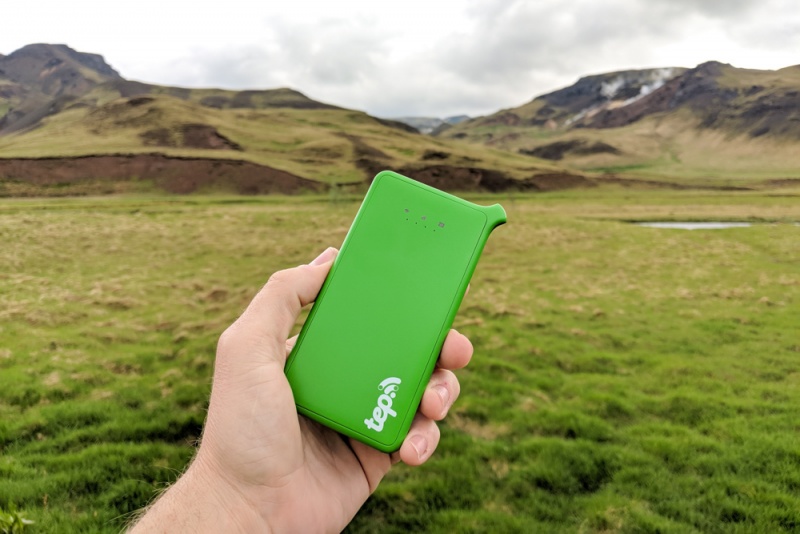
On our most recent trip to Europe , we needed to find a new solution. We were working on a two-week project in Iceland and having reliable internet was going to be key to keeping our blog up-to-date during our trip. But we were going to be camping in a motorhome on this trip so we wouldn’t have access to any free hotel or restaurant internet.
Luckily, we found the TravelWifi Portable Hotspot . These pocket-sized, personal Wi-Fi devices are available in over 100 countries and provide unlimited on-the-go internet.
Our TravelWifis allowed us to stay connected in Iceland and throughout the rest of our time in Europe. Even when we were holed up in our campervan in the most remote parts of Iceland, we were able to continue working thanks to our TravelWifi devices.
TravelWifi Review: Is it the Best Wi-Fi Hotspot for Travelers?
Travelwifi – usability overview.

The TravelWifi offers a compact Wi-Fi device that is super easy to set up and even easier to use. The TravelWifi Portable Hotspot has just a single power button on one side. Once you hit the power button, the TravelWifi automatically connects to the internet and you can connect up to 5 devices so your phone, laptop, and iPad can all seamlessly connect at once. You’ll find your network name and password on the back of your TravelWifi device.
The front of the TravelWifi Portable Hotspot has three indicator lights above a row of four dots. The first indicator light shows where your Wi-Fi is currently enabled and the other two show your signal strength and battery level.
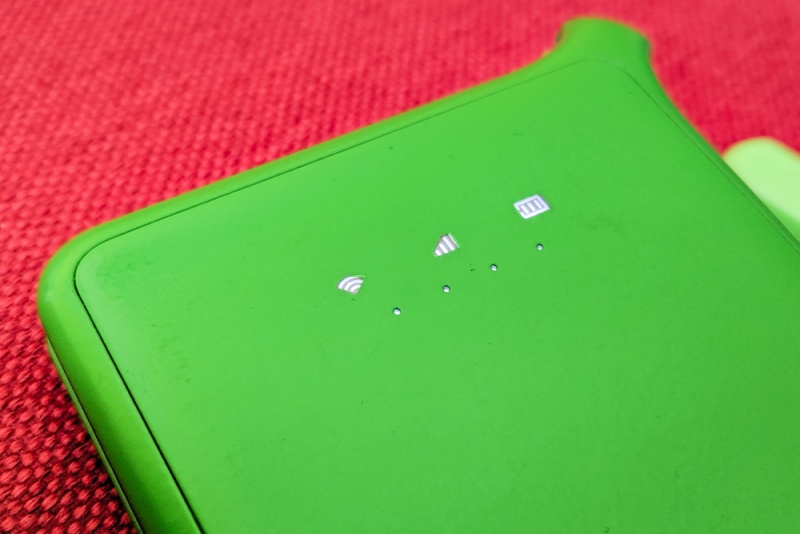
Once you have powered up your TravelWifi Portable Hotspot, just tap the power button once to see your battery level. Each of the four dots represents 25% strength. Tap the power button again to see your signal strength.
The TravelWifi Portable Hotspot battery lasts for about 13 hours. We would actually leave them on all day, and we were often surprised at how long they lasted on a single charge. Recharging a TravelWifi Portable Hotspot device takes about 3.5 hours. Your device will also come with a micro USB connector and a universal travel adapter so no matter where you’re headed in the world, you won’t need to purchase any extras to charge your device.
What Comes with the TravelWifi Portable Hotspot
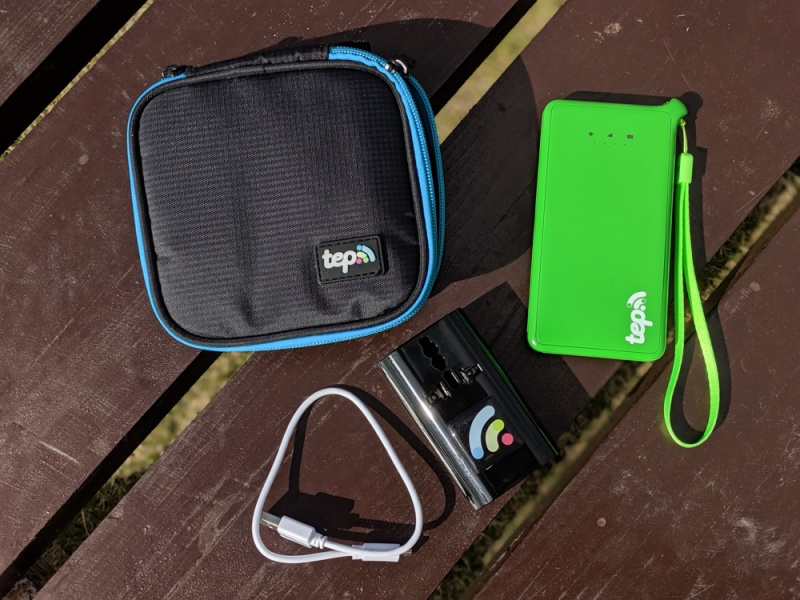
Your TravelWifi Portable Hotspot device will include the following:
- TravelWifi Portable Hotspot
- Travel pouch
- Universal adapter
- Micro USB charging cable
- User guides
- 24/7 customer support
TravelWifi Pricing Plans

All of TEP’s plans include unlimited internet so once you’ve consumed all of the data from your high-speed plan, your connection speed slows down to 256KBPS. So you can still browse the internet and social media, as well as send and receive emails.
Pricing plans for travel to European countries are as follows:
Rent: Adventure: 1 GB/day for: $7.95/day Escape 5 GB/day for: $8.95/day Voyage 10 GB/day for: $11.95/day
Buy: $149 for their Sapphire 3 Portable Hotspot
Should You Rent or Buy your TravelWifi Device?
Whether you should buy or rent your TravelWifi Portable Hotspot device depends on how long you plan on traveling. If you travel quite a bit and want to stay connected wherever you go, you’re better off buying a device and then using the pay-as-you-go service to activate while you’re away.
And if you purchase your TravelWifi Portable Hotspot, it will be super easy to re-activate it for future trips abroad. Even if it’s just for a couple of days outside of your home country!
TravelWifi Internet Coverage
One of the best parts about owning a TravelWifi Portable Hotspot is just how many countries it will work in. TravelWifi has coverage in over 100 countries, including locations like Latvia, Morocco , Egypt, Bolivia, Myanmar, Vietnam , The Philippines , and even Kazakhstan! You can see their coverage map here .
Other Cool Services from TravelWifi
TravelWifi also offers a couple of other cool services that you’ll likely want to take advantage of if you’re going to be traveling abroad:
- Call and Text Abroad : Download the TravelWifi mobile app to get great rates on international calls and texts. Their VoIP technology uses 9x less data than other mobile VoIP technologies.
- TravelWifi Membership : Your TravelWifi Membership allows you to unlock exclusive deals and up to 60% savings for hotels, car rentals, and flights.
TravelWifi is always rolling out new services. Make sure you check their extras page to see their latest service offerings.
Our Experience with TravelWifi

We’ve loved having our TravelWifi devices during our time in Iceland, the United Kingdom, and Portugal! They allowed us to stay connected while wandering around big cities or hiking out in the middle of nowhere. And since they’re small enough to keep in our pocket or throw in our purse, we always kept them with us.
There were even a few times when the Wi-Fi in our hotel rooms was terrible. So, we relied on our TravelWifi devices to keep us online and working hard. The best part is we now have our TravelWifi Portable Hotspot devices. On our next trip, we’ll just have to purchase a data plan on our TravelWifi account.
We hope this TravelWifi Review helps you stay connected while traveling the world! Use the coupon code “WHEATLEY10” to get 10% off your order.
Share this on pinterest.

Val grew up in Portland, Oregon but moved to Oahu on a whim back in 2013. She sold her house and all of her belongings and bought a one-way ticket. Since then she’s taken two around-the-world trips and has visited 60-ish countries while living out of a duffel bag. Val started documenting the Wandering Wheatleys travels back in 2013 as a way to update friends and family about her whereabouts and to relay humorous daily interactions. The only readers were her mom and her mother-in-law but that didn’t stop her! These days you’ll find Val dreaming up future trips, creating new travel content, managing a team of amazing travel enthusiasts, and chasing around her two adorable but naughty kids.
Related Posts

The Best Stylish Bags for Travelers

14 Romantic Valentine’s Day Gifts for World Travelers

The Perfect Philippines Packing List!
2 thoughts on “travelwifi review (tep wireless): the best wi-fi hotspot for international travel”.
ABSOLUTELY DO NOT RENT FROM TRAVELWIFI
SHORT VERSION: Rented a unit in March 2022. Returned the unit after a week stay to the same location I rented from. Arbitrarily charged my credit card $150.00 despite having photographic evidence that I dropped it off at the same location. Please whatever you do, DO NOT rent one of their units!!!
LONG VERSION: I knew from the beginning this company was not going to provide great service. Upon landing in CDG airport, I followed the instructions that Travelwifi provided. They specifically write to pick up from Terminal 2A. There is no such kiosk in terminal 2A. I attempted to find help and upon finding a security officer called the phone number with no response. Finally picked up the unit from a Tourism Information desk. Initially the staff person did not know what I was talking about. The staff had to set up the unit which took an additional 15 minutes. After having the unit, I learned within the next 15 minutes that there was a hard data cap on the unit. I called an Uber to get to our hotel and lost service for the rest of the day midway through the car ride. During our vacation we relied on Starbucks and Cafe Wifi. This service was awful. At the end of our trip, I dropped off the unit at the same Tourism Information and took a photograph just in case. Got home and 6 months later get notified that I did not return the unit??? Why would I want to keep a unit that barely offers any type of signal? I told the customer service team that I returned the unit and sent them the picture I took as proof. Instead they charged my credit card for $150.00 without my authorization. Brings the total that they STOLE from me to $206.29 Not worth the headache whatsoever.
What European countries does this device work in? Also, is it good in Thailand, Vietnam, Cambodia?
Leave a Comment Cancel Reply
Your email address will not be published. Required fields are marked *
- Irresistible Tech Gifts for That Special Dad
- Killer Smartphone Deals We Love
The Best Wireless Travel Routers of 2024
Pocket routers for Wi-Fi networking on the road
:max_bytes(150000):strip_icc():format(webp)/JesseHollington1-2063ccd484294f1b9fa6a70aad8f925b.jpg)
We independently evaluate all recommended products and services. If you click on links we provide, we may receive compensation. Learn more .
Frequent travelers battling poor cell service, dubious security, and excessive hotel and airport Wi-Fi fees can benefit from a good travel router when working away from home.
The best wireless travel routers avoid these hassles by letting you set up a private bubble of Wi-Fi anywhere you happen to land, whether in a conference center, hotel room, or airport lounge.
Most people should buy the TP-Link TL-WR902AC - it's small enough to chuck in a backpack and can even double as a Wi-Fi range extender. If you also want a cellular connection as backup, the Netgear Nighthawk M1 is for you, as it doubles as a mobile hotspot for your hotel room or car.
What to Look For in a Travel Router
Best overall, tp-link tl-wr902ac travel router.
Amazon
Compact size is ideal for frequent travelers
Doubles as a Wi-Fi extender
Included cables are short
TP-Link's TL-WR902AC is one of the fastest travel routers we've seen, which is especially impressive at this size and price. Measuring 2.64 x 2.91 x 0.9 inches and weighing in at only 8 ounces, it's small enough to carry in a pocket, briefcase, or backpack, so you'll be ready to set up your own Wi-Fi bubble anywhere.
For such a small device, the TL-WR902AC offers impressive dual-band Wi-Fi performance. It's also really versatile since it can be not only be used as a router or access point to create a wireless network but also as a range extender, private Wi-Fi hotspot, or even as a bridge to connect a wired device to a Wi-Fi network by using its built-in Ethernet port in the opposite direction.
A built-in USB port lets you share files and media from a removable USB storage device, and it can also provide up to 2A of passthrough power to charge your smartphone or tablet. The only real downside is that the port layout can be awkward since the USB and micro USB power ports are on the opposite side of the Ethernet port.
Wireless Spec: 802.11ac | Security: WPA2 | Standard/Speed: AC750 | Bands: Dual-band | MU-MIMO: No | Beamforming: No | Wired Ports: 1
Best Splurge
Netgear nighthawk m1.
Great choice for heavy internet users
Supports up to 20 Wi-Fi devices at once
Long battery life
Doubles as a mobile hotspot
Very expensive
Can occasionally overheat
While it's not the most affordable option on our list, it's well worth the splurge if you need to get several devices onto the internet anywhere at blazing-fast speeds.
With support for up to 20 simultaneous devices, Netgear's Nighthawk MR1100 can quickly handle your whole family or project team, and unlike most travel routers on this list, the one works as a 4G LTE mobile hotspot too. This means you'll be able to connect to its Wi-Fi network and get online even when there's no other Wi-Fi or Ethernet connection. It's also the first mobile hotspot to support Gigabit LTE , with 4X4 MIMO and four-band Carrier Aggregation. Hence, it can provide internet speeds rivaling your home broadband connection.
It's not just about LTE, though—the MR1100 also works as a traditional portable router. Just plug a standard internet connection into the Ethernet port to share access to your Wi-Fi devices. A large 2.4-inch color LCD screen also ensures that you can keep track of the router's status and how much data you're using. The rechargeable battery can keep you going for up to 24 hours before you need to charge it, and in a pinch, you can also use some of that capacity to charge your smartphone or other mobile devices.
Wireless Spec: 802.11ac / 4G LTE | Security: WPA2 | Standard/Speed: AC750 | Bands: Dual-band | MU-MIMO: No | Beamforming: No | Wired Ports: 1
TP-Link TL-WR802N N300 Wireless Portable Nano Travel Router
Fast single-band Wi-Fi performance
No USB port
Not the fastest internet speeds when connected to multiple devices
TP-Link’s TL-WR802N is an older single-band router that offers a surprisingly great range in its small package. While the single-band N300 rating won’t break any speed records, it still provides enough performance for lag-free 4K Netflix streaming and uninterrupted video conferences on Zoom.
Like most travel routers, the TL-WR802N is designed for use by one or two users when you’re on the go, and the 300Mbps 802.11n speeds will likely be faster than the internet connection at most hotels and conference centers you find yourself in. This little pocket-sized router offers exceptional coverage, so you won’t need to worry about staying connected while roaming the boardroom.
The N300 draws its power via a micro USB port that can connect directly to a wall charger or laptop, so you won’t have to worry about how to power it. It can also function as a repeater, Wi-Fi client, or extender for a public WISP hotspot. The only downside is that, unlike its dual-band sibling, the TL-WR902AC, it lacks a USB port, so you won’t be able to use it for sharing files.
Wireless Spec: 802.11n | Security: WPA2 | Standard/Speed: N300 | Bands: Single-band | MU-MIMO: No | Beamforming: No | Wired Ports: 1
Best for Road Warriors
Gl.inet mudi gl-e750.
Works as a 4G LTE mobile hotspot
Open source
Excellent VPN support
No external antenna
The GL.iNet GL-E750 router is an excellent choice for road warriors who must stay connected securely and reliably anywhere they land.
With WireGuard encryption, support for multiple Open Source VPN protocols, and even Tor anonymous network routing, this router ensures that you can always have a secure and private connection to the internet if you're a relatively advanced user. Whether that's over your hotel's shared network or your carrier's LTE network, all your traffic will be encrypted, and you can even have an always-on tunnel back into your home or office network.
It's not just for mobile LTE access, however; it's also a capable Wi-Fi access point, with dual-band 2.4GHz and 5GHz support with 733Mbps throughput across both bands, along with a built-in battery that offers up to eight hours of use and a USB port and microSD card slots that can be used for sharing files with your connected devices. Since it's designed to be used from anywhere, it also features a built-in rechargeable battery that promises up to eight hours of use on a single charge.
Lifewire / Andy Zahn
Most of the routers on the market are big and bulky devices. If you're parking them in a corner at home, this is a manageable problem, but they're not suited for taking the road with you.
This has given rise to a whole new category of travel routers: devices that are specifically designed to be highly portable—often small enough to be carried in a pocket—and run from internal batteries or a simple USB-powered connection that lets you plug them into a laptop or portable battery pack to create your own personal Wi-Fi network.
Most importantly, since public Wi-Fi hotspots are usually insecure, a good travel router can also offer additional peace of mind by providing a private, encrypted Wi-Fi network for your traffic, securing the connections not only between your devices and the router but also making sure the traffic leaving the router is also encrypted.
This means that you can take them just about anywhere you happen to land, whether it's between your home and the office, to a coffee shop where you might want to have more secure Wi-Fi, or on the road with you to use in hotels, conference centers, and airport lounges.
Bandwidth and Performance
When shopping for a router for your home, you're looking for enough range to blanket your home with the strong Wi-Fi signal you need to support streaming and gaming from multiple devices.
Travel routers are different. You may find that even an entry level router—one that offers 802.11n support at 150Mbps speeds—is more than enough.
Wireless Frequencies: Single-Band vs Dual-Band
Like other wireless routers, travel routers come in single or multi-band versions, which refers to their frequencies. A single-band router works only on the 2.4GHz frequency, while a dual-band router offers both 2.4GHz and 5GHz frequencies on two separate bands.
Security and Privacy
As a bare minimum, every modern wireless travel router should include support for the Wireless Protected Access 2 (WPA2) encryption standard. This is even more important in a travel router you'll use in more public spaces.
While this probably isn't such a big deal if all you want to do is stream movies from Netflix, if confidentiality is essential, we strongly recommend using a Virtual Private Network (VPN) when connecting through a travel router. While you can do this directly from your devices, you'll probably find it even simpler to pick up a travel router with built-in VPN support so that your connection is automatically encrypted as soon as you plug it in.
Connectivity
Almost all travel routers offer the same connectivity as your home router—turning a wired connection into a Wi-Fi network. However, as more hotels offer guest Wi-Fi networks instead of Ethernet jacks, you'll probably find getting a travel router that can also connect to a public Wi-Fi network is more beneficial.
There's also a category of travel routers that can act as mobile hotspots to offer internet access for your mobile devices over an LTE cellular network.
Even though most hotels already offer free Wi-Fi, it’s often struggling under the load of many people using it, so having a travel router can provide better performance, especially if you can plug it into a wired connection in your room. Plus, most public Wi-Fi hotspots are completely insecure, allowing your traffic to be easily intercepted by anybody else on the same Wi-Fi network. Using a router plugged into ethernet will also often save you money as you won't have to pay for the usable 'premium' internet package.
The best travel routers offer industry-standard WPA2 encryption—the same type of security used by your home router—which means that all of your wireless traffic is safe from prying eyes. Public Wi-Fi hotspots are open networks that use no encryption at all but keep in mind that if you’re using a travel router as a wireless extender for a public Wi-Fi hotspot, your traffic will still be unencrypted between your travel router and the hotspot. For the best security, use a wired connection or a VPN wherever possible.
Even if you use your travel router in your hotel room, internet traffic still travels over the hotel’s network. While most sensitive sites and services like email and online banking use SSL encryption, this won’t prevent the hotel or other public hotspot provider from seeing where you’re going; they just won’t be able to know what you’re doing. If you want to ensure your connection is as private and secure as possible, we recommend using a travel router with built-in VPN support.
Get the Latest Tech News Delivered Every Day
- The Best Wi-Fi Range Extenders of 2024
- The Best Mesh Wi-Fi Network Systems of 2024
- The Best Long-Range Routers of 2024
- TP-Link TL-WR902AC AC750 Travel Router Review
- The Best Netgear Routers of 2024
- The Best Cable Modem/Router Combos of 2024
- The Best Parental Control Routers of 2024
- The Best USB Wi-Fi Adapters of 2024
- 5 Things to Consider Before Buying a Wireless Router
- How to Set up a Home Wi-Fi Network
- The Best Asus Routers of 2024
- How to Connect Two Routers on a Home Network
- Can Two Routers Be Used on the Same Home Network?
- How to Get Wireless Internet Access in a Hotel
- The Best Cable Modems of 2024
- How to Share Your Laptop's Internet With Your Phone
Advertiser Disclosure
Many of the credit card offers that appear on this site are from credit card companies from which we receive financial compensation. This compensation may impact how and where products appear on this site (including, for example, the order in which they appear). However, the credit card information that we publish has been written and evaluated by experts who know these products inside out. We only recommend products we either use ourselves or endorse. This site does not include all credit card companies or all available credit card offers that are on the market. See our advertising policy here where we list advertisers that we work with, and how we make money. You can also review our credit card rating methodology .
The 7 Best Portable and Mobile Wi-Fi Hotspots for Travel in 2024
Amar Hussain
Senior Content Contributor
797 Published Articles
Countries Visited: 63 U.S. States Visited: 9
Keri Stooksbury
Editor-in-Chief
35 Published Articles 3260 Edited Articles
Countries Visited: 47 U.S. States Visited: 28
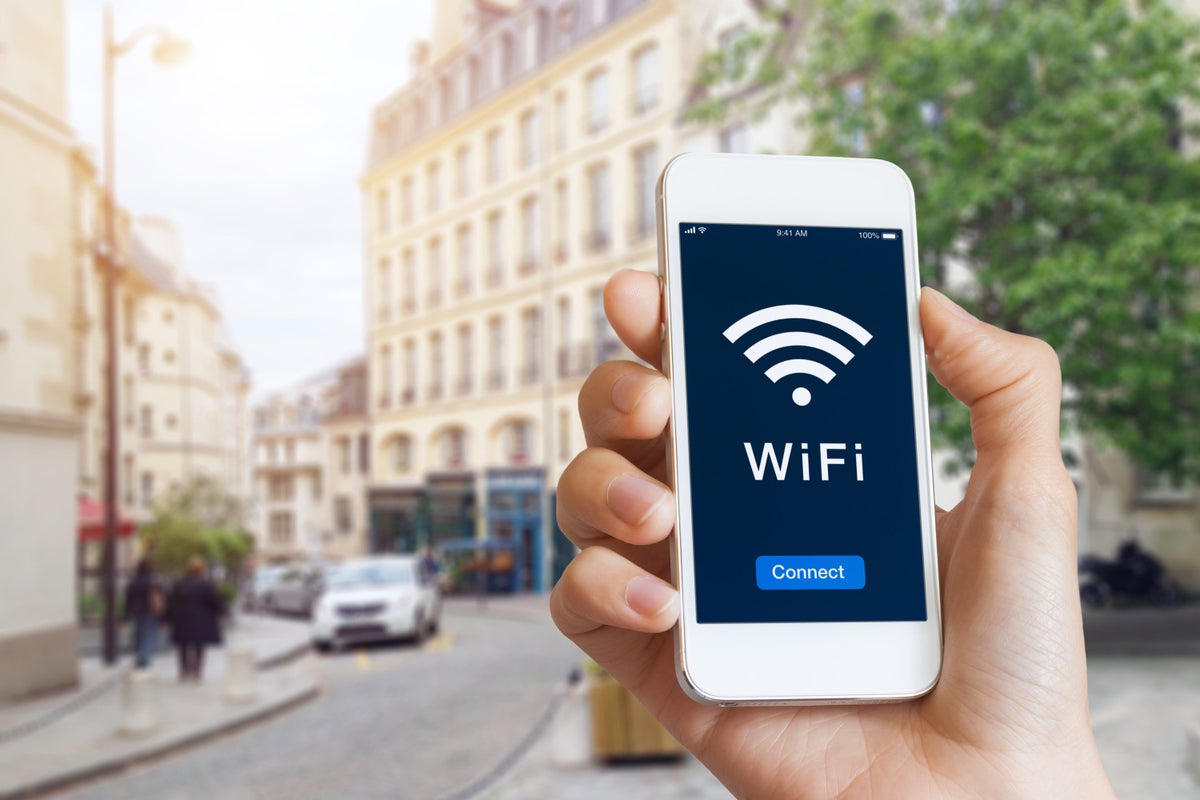
Table of Contents
What is a mobile wi-fi hotspot, things to look for in a mobile wi-fi hotspot, frequencies explained: the difference between gsm and cdma, the 7 best mobile wi-fi hotspots for travel, final thoughts.
We may be compensated when you click on product links, such as credit cards, from one or more of our advertising partners. Terms apply to the offers below. See our Advertising Policy for more about our partners, how we make money, and our rating methodology. Opinions and recommendations are ours alone.
Whether you want to update your Insta on the go or need to keep in touch with the office, losing your internet signal can be very frustrating.
But it’s annoying (and can be unsafe) to rely on public Wi-Fi signals in every coffee shop you visit, and sometimes when traveling to remote locations, public connections are just not available.
Instead, you can invest in a mobile Wi-Fi hotspot to ensure safe, secure, and reliable internet access anywhere you go. Here’s what you need to consider when choosing the best one for you.
A Wi-Fi hotspot is a battery-powered wireless router that travels with you. Designed to be compact and lightweight enough to slip into your purse or pocket, a mobile Wi-Fi hotspot device brings the internet to your phone, tablet, or laptop, no matter where in the world it finds you.
These gadgets are a big bonus for anyone traveling away from public Wi-Fi or those looking for a secure connection. A bit like a cellular device, your Wi-Fi hotspot provides access to invisible signals in the sky, all of which can help you to upload pics or receive your emails on the move.
You will need to pay for the data you use, which can be done in the form of packages or day passes that offer unlimited access for a set period of time.
Bottom Line: Using 3G or 4G (and maybe even 5G in the coming months), these smart little devices emit a reliable and incredibly useful Wi-Fi signal that you can hook your favorite gadgets and devices to while away from home.
Battery Life
Most batteries will run happily for between 5-6 hours at a time. If you are traveling somewhere with easy access to electricity, you should be able to charge overnight to ensure your hotspot works when you need it for your daily adventures. If you spend a disproportionately large amount of time online, you may want to look at a device that offers a longer battery life.
Size and Weight
Your Wi-Fi hotspot should be small enough to be carried everywhere with you. After all, if it’s not entirely portable, what exactly is the point? Slimline, lightweight, and often smaller than the smartphone you are trying to connect to, these devices are compact and clever.
Wi-Fi Support
Because some mobile internet providers are better than others, the coverage you receive from any Wi-Fi hotspot can also vary. For example, 2.4GHz gives coverage at a more extended range but will transmit the data at a much slower speed. A 5GHz band, on the other hand, will provide less range with data transmitted at a much faster speed.
Though they may be small, they are still mighty, and most hotspot devices will have a built-in display. At the very least, the display should indicate remaining battery life and current Wi-Fi signal strength. Others may offer bonus features like SMS messages or touch screen modes.
Card Reader
Some portable Wi-Fi hotspots come with the capability to read MicroSD memory cards, which can be used to store and access files from your laptop or home computer. You can also share your stored files with the people who use your network when you want them to have access.
MicroSD memory cards are not typically included with the purchase of a Wi-Fi hotspot, but they are a useful addition that allows you to send and receive SMS messages and save images, music, and other data-heavy files.
Mobile data is delivered using 1 of 2 types of cellular signals in different countries and regions around the world. These cellular standards allow for communication between individuals; without them, we would not be able to keep in touch on such a global scale.
Known as GSM and CDMA, each standard converts both incoming and outgoing radio waves in entirely different ways. Before you buy a hotspot, you need to understand its function and where you’ll be able to use it.
Global System for Mobile Communication is used in most countries around the world. In the U.S., only AT&T and T-Mobile use GSM. GSM uses Time Division Multiple Access (or TDMA), which allocates time slots to multiple conversation streams and alters how phones transmit their information. Doing this requires a SIM card (or “subscriber identification module” card).
It is the SIM card that holds all the information you need to make calls, use mobile internet, and store your contacts. The SIM card tells the device what services you have access to and is vital for GSM communications on the go.
CDMA is used in countries including Russia and the U.S. ( Sprint , Verizon , and US Cellular), and it grants users full access to a wide spectrum of bandwidth, meaning more users can connect at any one time. It also encodes each signal, meaning that every conversation remains protected and filtered.
CDMA does not rely on SIM cards as the device has the technology built into it from the carriers’ networks. This once meant that if you wanted to change carriers, you would need to buy a new device altogether. These days though, many CDMA devices offer the capability to use a SIM card too, especially for those on LTE networks.
Bottom Line: Different countries (and different carriers) use different technologies. In the U.S., Sprint, Verizon, and US Cellular use CDMA, while AT&T and T-Mobile use GSM. When it comes to purchasing a hotspot, make sure you understand what type you’re buying, what countries it will work in, and what providers it will function with.
1. Keep in Touch Wherever You Are Using the GlocalMe 4G LTE Network

GlocalMe DuoTurbo 4G LTE Mobile Hotspot
With a global SIM-free connection, you can quickly and easily access the internet without worrying about a local SIM card or roaming charges. The 4G LTE high-speed network connects up to 10 devices at a time. Enjoy an innovative GlocalMe app that uses a dedicated security protocol to ensure your Wi-Fi connection is always safe.
You can also easily manage your data usage from anywhere in the world. With an initial 1.1 GB of global data and 8 GB U.S. data included to see you on your way, you can easily top up your data using the GlocalMe app, which is specifically designed to work in a variety of different countries and regions.
Bottom Line: With 1 Nano SIM card slot and the ability to connect to unlocked Wi-Fi hotspots wherever you are, the G4 will provide you with up to 12 hours of nonstop usage from a single charge.
2. Rapid Download Speeds and Superfast Internet on the Go

Huawei E5577Cs-321 4G LTE Mobile Wi-Fi Hotspot
Huawei’s Wi-FI hotspot is both affordable and reliable — and it’s good enough to give some of the more prominent brand alternatives a real run for their money.
This hotspot offers rapid download speeds of up to 150 Mbps 4G LTE and 43.2 Mbps 3G download , connection for up to 10 Wi-Fi enabled devices, 6 hours of working time, and a whopping 300 hours of standby time.
Bottom Line: The TFT-LCD screen with 2D Barcode secure connection is easy to use, and the device itself is unlocked for all networks — you can even choose your SIM card if you want to.
3. Best for Professionals Who Need To Keep Connected

Huawei E5576-320 4G LTE Mobile Wi-Fi Router
This high-speed mobile router and multi-mode wireless terminal is for use in Europe, Asia, the Middle East, and Africa.
The hotspot offers 16 Wi-Fi connections at a time, and the unlocked carrier connection means you can use 3G signals from any provider. Controllable via the innovative Huawei Mobile Wi-Fi app, you can enjoy uploads and connectivity for up to 6 hours using the 1500 mAh battery.
Bottom Line: While this device model will not work in the Americas or the United States, it is an affordable solution for those traveling to other parts of the world.
4. A Powerful Global WI-Fi Hotspot for Use in Over 160 Countries
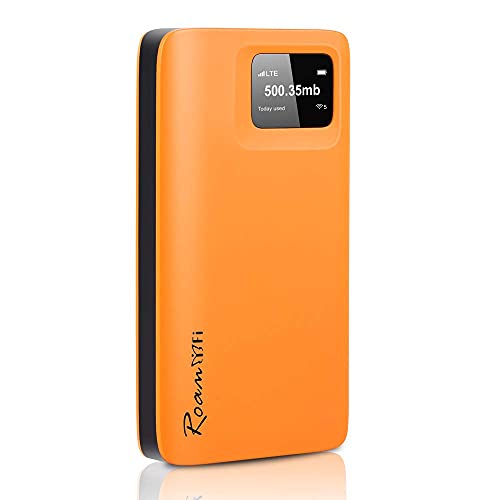
RoamWiFi 4G LTE WiFi Mobile Hotspot Router
The RoamWiFi Mobile Router is a powerful global Wi-Fi hotspot with super-fast 4G LTE speeds that can be used in over 160 different countries and shared to 5 connections. Sleek and stylish, the simple orange hotspot can be stored in your carry-on luggage and will be easy to find when you get there.
By far, the most impressive feature of this particular model is the whopping 18 hours of battery life . 500MB of data can be purchased for as little as $2.90 per day.
Bottom Line: All-in-all, this is a tremendous little Wi-Fi hotspot for your next adventure.
5. Compact and Capable Offering 18 Hours of Battery Life

Netgear Unite Explore AC815S Mobile Wi-Fi Hotspot
This slim 4G LTE-capable device provides super-fast internet and as much as 18 hours of battery life on a single charge to as many as 15 Wi-Fi devices on the go.
Super easy to use, the color LCD screen shows you all the network info you need, as well as displaying battery life and connectivity levels.
Bottom Line: Made by one of the most trusted names in communications, the Unite Explore is a reliable Wi-Fi hotspot for travelers looking for longer battery life.
6. Superfast Connectivity in Over 135 Countries

SIMO Solis Lite 4G LTE WiFi Mobile Hotspot
With no contract or SIM card required, this convenient little device will ensure you’re always connected on the go. The virtual SIM technology is compatible with most major carriers, and you can control everything through the handy Solis WiFi app.
You can connect up to 10 different devices with up to 16 hours of battery life on a single charge. As well as keeping you connected, this mobile hotspot doubles up as a power bank, so you’ll never run out of charge.
Bottom Line: With SIMO Solis, users can enjoy day pass Wi-Fi, pay as you go access by gigabyte, or monthly and yearly subscriptions.
7. Connect 10 Wi-Fi Enabled Devices With This Verizon Jetpack

Verizon MiFi Jetpack 4620L
Brought to you by the communication experts at Verizon, this MiFi Jetpack offers superior connectivity and speedy internet access virtually anywhere in the world. With the ability to connect up to 10 Wi-Fi-enabled devices in 4G and up to 5 devices in 3G, this is one of the most effective LTE hotspot devices on the market.
Compatible with all major operating systems including Windows, Mac OSX, Android, and iOS, you can quickly and easily connect your phone, tablet, or laptop. The interactive OLED display shows you when you are connected, as well as the connection status and how many users are connected. It can even alert you when you receive a new SMS message.
Bottom Line: With up to 5 hours of usage available from a single charge, this impressive MiFi mobile Wi-Fi device is one of the most effective LTE hotspot devices on the market.
With a mobile Wi-Fi hotspot, you are no longer at the mercy of unsecured, cumbersome, and often super-slow public Wi-Fi signals when you take to the road. Your very own Wi-Fi allows you to download data, upload images, and keep in touch with civilization, no matter how far away you go.
Before you commit to a connection, look for a mobile Wi-Fi device that is compact and portable with a large enough battery to last you all day. Your new Wi-Fi hotspot should also be simple to use, easy to connect to, and ideally able to offer a connection to several different devices (especially if you’re traveling with friends).
Lastly, don’t miss these other tech-related product reviews to level up your travel game!
- The Best Portable Bluetooth Speakers for Travel
- What are the Best GoPro Alternatives? [10+ Options]
- The Best Portable Power Bank Chargers for Travel
- Travel Product Reviews – Tech & Photography Focus
Frequently Asked Questions
What is the best mobile wi-fi hotspot for travelers.
Our vote is for the GlocalMe G4 4G LTE Mobile Hotspot.
With a global SIM-free connection, you can quickly and easily access the internet without worrying about a local SIM card or roaming charges. The 4G LTE high-speed network connects up to 10 devices at a time. Enjoy 50Mbps upload speeds and an innovative GlocalMe app that uses a dedicated security protocol to ensure your Wi-Fi connection is always safe.
Do mobile hotspots work internationally?
Many mobile hotspots do work internationally, but this would depend on what plan your device is on. Many plans include a set amount of international data, while others offer unlimited usage for a set fee.
Can mobile hotspot replace home Wi-Fi?
Although mobile hotspots can be used in place of home Wi-Fi, it usually carries higher usage costs. If you are a heavy downloader or video streamer, you would likely be better off registering for a home Wi-Fi service.
Which is better Wi-Fi or hotspot?
Hotspots usually offer slower speeds and less security than Wi-Fi; however, it is convenient if you’re on the move, and there are no guarantees that you will be able to access a Wi-Fi connection.
Was this page helpful?
About Amar Hussain
Amar is an avid traveler and tester of products. He has spent the last 13 years traveling all 7 continents and has put the products to the test on each of them. He has contributed to publications including Forbes, the Huffington Post, and more.
INSIDERS ONLY: UP PULSE ™

Get the latest travel tips, crucial news, flight & hotel deal alerts...
Plus — expert strategies to maximize your points & miles by joining our (free) newsletter.
We respect your privacy . This site is protected by reCAPTCHA. Google's privacy policy and terms of service apply.
Related Posts
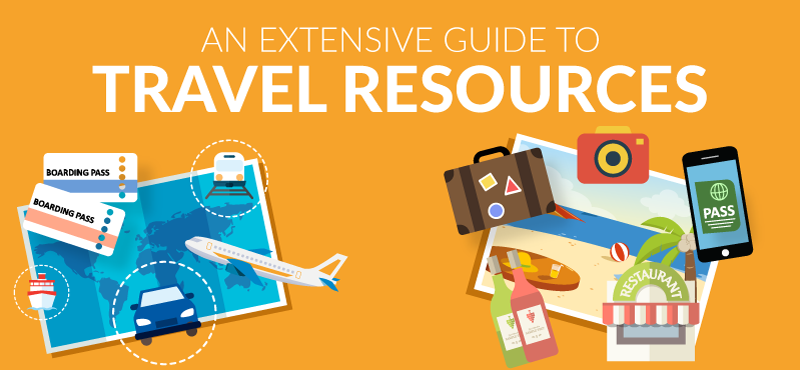
UP's Bonus Valuation
This bonus value is an estimated valuation calculated by UP after analyzing redemption options, transfer partners, award availability and how much UP would pay to buy these points.

Portable Travel Wifi Device: Review for Digital Nomads
Below is our review of Travel Wifi portable wifi device. We have used the Travelwifi hot spot during our travels as digital nomads, before and after their rebrand from TEP to TravelWifi.
Read on to learn the pros and cons of using this wifi dongle for short-term and long-term world travelers.
Disclosure: This free article contains affiliate links. If you make a purchase after clicking one of these links, we may earn a small commission at no additional cost to you. Your support helps us continue to provide helpful, free content for you. We received a complimentary Teppy pocket wifi device and updated Sapphire 2 wifi travel device to test during our travels. All views in this post are our own.
Updated: November 2022. Originally published: Fall 2017.
Table of Contents
What is Travel Wifi (formerly TEP Wireless)?
Travel Wifi (formerly TEP Wireless) is a global company with a simple mission: to keep you connected to the internet while traveling.
They do this by providing wifi hotspot devices (for rent or purchase), previously called the Teppy, that can be used on 6 different continents as well as islands throughout the Caribbean and beyond.
With the use of the Travelwifi hotspot device, you can purchase data plans and day passes to access data wherever there is coverage.
International Pocket Wifi or SIM Card: Get a wifi hotspot for your trip > **Save 10% on TravelWifi with our coupon code: INTENTIONAL

How the Travel Pocket Wifi Device works
We hope to answer any questions you may have about Travel Wifi in the following video and detailed product review.
Check out the new Travel Wifi device here >
About the wifi devices
The Travelwifi pocket wifi devices are small, portable devices. The standard Portable Hotspot Rental and the Sapphire 2 (for purchase) have one button and one mini-USB charging port.
The Sapphire T2 , another option for purchase, has its own 5-inch touchscreen and built-in apps, like Google Maps.
All the devices are the size and shape of a small smartphone with a hard shell exterior.
It’s important to note that the device is not waterproof or water resistant. If you’re really worried about that, you can easily stick it in a ziplock bag or small waterproof sack if needed.
For the purposes of this review, we’ll focus on the Sapphire 2 . That is what we have been using and what we recommend for most travelers.
The one and only button on the device does what you’d expect it to do. It turns the device on and off after pressing and holding for three seconds.
The Sapphire 2 should last 12 hours on a full charge. We tested the battery life with fairly regular wifi use all day. After almost 9 hours, the battery light started blinking and showed one of four bars of charge left.
To charge the device, simply plug the mini-USB cord into the Teppy and charge from a USB port . Wall charging is recommended over charging through a computer.
The front of the Sapphire 2 device has indicator lights for Wi-Fi, signal, and battery. Clicking the side power button quickly illuminates the battery life and then then signal strength.
Everything else is managed through the Sapphire app.
How to connect to wireless internet abroad
There is a short set up process in the Sapphire app or the website to create an account, link your device to your account, and manage data plans. This initial set up is best done before you need to use the device, while on another wifi source.
Once abroad, here’s how to connect to the Travel Wifi: 1. Power up the device 2. Select the device’s wifi network on your phone, tablet, or computer
You’ll enter the wifi password, which is printed on the device, just one time for each phone or laptop. After that, you’ll only need to charge the battery and repeat the two steps to reconnect.
Travel Wifi will support up to 5 devices at a time. However, similar to other wifi products, the more devices connected and using data, the slower the performance and data transfer rates will be.
International Pocket Wifi or SIM Card Get a wifi hotspot for your trip > **Save 10% on TravelWifi with our coupon code: INTENTIONAL
Travel Wifi Performance
The Sapphire connects on 4G. According to the website, it can reach speeds up to 150 mgps download and 50 mbps upload.
But how fast is this travel pocket wifi in real life?
Teppy Wifi Speeds: Italy, Europe
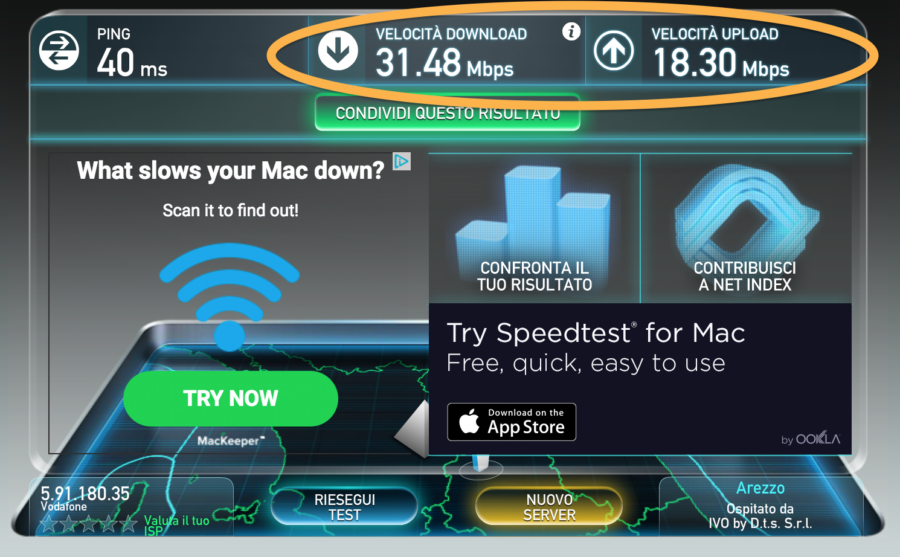
We tested the older version of the Teppy while in Florence, Italy and were impressed by the download and upload speeds. (Wifi can be notoriously slow in Italy.)
In the most optimal conditions, outside and in an urban city, we were able to see 31 mbps down and 18 mbps.
Comparatively, our Airbnb’s internet was 5 mbps down and .05 mbps up. It was also a glitchy connection that kicked us off every now and then.
The Travel Wifi device was a great back up for us when we returned to Italy in 2022.
Tip: If you’re inside where walls are thick, the signal may not get through very well. We had best results placing the pocket wifi device on a window sill. This allows for a stronger signal from outside while still using a laptop or phone indoors.
Pocket Travel Wifi Speeds: Ecuador, South America
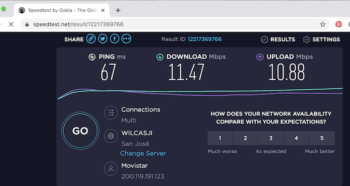
We tested the new Sapphire 2 wifi speeds in Ecuador. Outside in the city, we were able to see 14.8 mbps download and 3.88 mbps upload on our phones.
In our apartment, speeds were 11.47 down and 10.88 up on the laptop. Uploading a 390MB, 2 minute 30 second video to Youtube took about 25 minutes on the hotspot.
For comparison, our Ecuador Airbnb internet in 2021 was among the best in the city: 48 down and 46 up.
Notes About Wifi Hotspot Coverage While Traveling
Because Travel Wifi works using local data networks , you’ll often find that coverage and speeds can be better in more urban areas.
Also, if you’re wondering if they have cruise ship coverage? Only in port and near a major city. You cannot get coverage out at sea or on a plane.
It should also be noted that being inside a building with thick stone walls can also affect coverage. We tested our Teppy inside our Airbnb on the second level of a stone building. The speed was significantly slower inside than putting the device outside on the window ledge or using it outdoors in a clear area of the city.
Does TravelWifi throttle your wifi speed?
Once you use up your daily data amount for the plan you’re on, the device will no longer use 4G . For the rest of the 24 hour period, you’ll connect with speeds up to 256 kbs.
For example, if you’re on the Adventure Plan with 1G per day, your speed will be throttled once you use more than a gig of data within 24 hours of activating the plan. The next day, you’ll go back to 4G speeds.
For the Portable Hotspot Rental, each day resets at midnight GMT . You have until that time to use your daily data amount before speeds are throttled.
Save money, work smarter, travel deeper with our free Resource Guide for Digital Nomads .
Does the TravelWifi device work everywhere?
Service is provided in over 130 countries . They cover pretty much all of North America, South America, Europe, and Oceana. A large part of Africa, Asia, and the Middle East are covered, with a few more exceptions (see below).
Your pocket TravelWifi will find the best local network in each country. Because it does use local cell phone networks, you won’t be able to get wifi in locations where there is zero cell phone coverage.
If you are traveling to multiple countries, the device works seamlessly within the Global Freedom plan countries.
Countries covered by the Global Freedom plan include:
Algeria, Afghanistan, Antigua & Barbuda, Anguilla, Argentina, Austria, Australia, Aruba, Aland Islands, Barbados, Belgium, Bulgaria, Bahrain, Bermuda, Cambodia, Caribbean Netherlands, Brazil, Canada, Switzerland, Chile, Cameroon, Cayman Islands, Mainland China, Colombia, Croatia, Curacao, Cyprus, Czech Republic, Denmark, Dominica, Estonia, Egypt, Finland, Fiji, France, Germany, Grenada, French Guiana, Ghana, Guadeloupe, Greece, Guam, Guyana, Hong Kong, Haiti, Hungary, Indonesia, Ireland, Israel, India, Iraq, Iceland, Italy, Jamaica, Jordan, Japan, Kenya, Saint Kitts and Nevis, Kuwait, Kazakhstan, Laos, Saint Lucia, Liechtenstein, Lithuania, Luxembourg, Latvia, Morocco, Monaco, Myanmar, Mongolia, Macao(China), Northern Mariana Islands (Saipan), Martinique, Malta, Mexico, Malaysia, Niger, Netherlands, Norway, Nepal, New Zealand, Panama, Peru, Philippines, Pakistan, Poland, Puerto Rico, Portugal, Qatar, Romania, Russia, Saudi Arabia, Sweden, Singapore, Slovenia, Slovakia, South Africa, South Korea, Spain, Sri Lanka, Suriname, El Salvador, Turks & Caicos Islands, Thailand, Turkey, Trinidad and Tobago, Taiwan, Ukraine, United Arab Emirates, United Kingdom, United States, Uruguay, Vatican City, Saint Vincent & the Grenadines, Venezuela, British Virgin Islands, Vietnam
A few countries, like Ecuador, are not available on the Global Freedom plan. However, you can purchase country-specific plans for these instead.
At the time of this writing, some notable countries not covered at all by TravelWifi are: Russia, India, Botswana, Tanzania, Bhutan, Kosovo, Antarctica, Andorra, Israel, Syria, Iran, Armenia, Azerbaijan, Kyrgyzstan, and a few others.
Room for improvement: TEP Coverage and Speed Information
Though I think this is a solid device and service, TravelWifi could still improve on communicating more detailed information about coverage within a given country.
For example, if you go their website and click on “Coverage” in the footer area, it takes you to a page that shows you all the countries that they have coverage. You can click to see the starting rates for data plans in each country, which is an improvement from before.
However, it doesn’t tell you if the country is included in the Global Freedom plans, or if you will need to purchase country-specific data plans.
Another important aspect for digital nomads to realize is that the 4G internet speed is not unlimited . For the average user who is just checking e-mail and looking up things on Trip Advisor, the daily plan limits probably aren’t an issue.
For a pair of digital nomads like us who might need to upload images, do Zoom calls, and work with larger files of content, it is definitely possible to hit the daily data limit. At that point, internet speeds are throttled and heavy online work becomes tedious, if not impossible, for the rest of the day.
For this reason, we tend to use the pocket wifi plans as a back up for working online. It’s handy in case we’re not able to get wifi in our accommodations or a network suddenly drops.
Renting vs. Buying the TravelWifi device
The cost of purchasing a Travel Wifi device is $149-$199 , and then you pay on top of that for data packages .
Update: There is now a 5G device with touchscreen as well, which is $399. Sim cards start around $40.
Most frequent travelers buy their own device for convenience.
The rental price is based on the total number of days that you’ll keep the device and how much data you want to use each day. Daily rates start at $6.95.
If you have just one specific trip in mind that’s a week or less, you might as well rent a portable hotspot. However, you may save money by purchasing a device if: – Your trip is longer than a week or two, OR – You plan to use more than 2 or 3 GB of data each day, OR – You’re going to a country with expensive high data, OR – You could use it on multiple trips
For example, data in Ecuador is unusually high. On a three week trip at 1 GB per day, or a two week trip at 3 GB per day, it starts to be more cost effective to buy your own device.
Best Travel Wifi Review: Final Thoughts
The main things to ask yourself before buying or renting a TravelWifi hotspot are: – How often do you need to be connected to the internet? – When and where would you use it?
This is a great device for those that need peace of mind that they can get connected to the internet while traveling.
It’s ideal for urban and semi-rural areas around the world without the hassle of dealing with roaming charges and super expensive international data service plans for phones.
Once you own it, you pay only as needed , and we think that’s an important feature that makes this one of the best travel wifi devices.
This is for you if you’re searching for secure travelers wifi, a portable travel wifi router, a travel wifi sim card or hotspot, or travel wifi rental so you can easily travel with wifi around the world.
Because of the coverage and ease of crossing borders to multiple countries, this works especially great as pocket wifi for Europe . (Plus, if you choose the Europe wifi rental option, you can pick up a device from 50 locations in Western Europe and avoid shipping costs.)
Pros of Travel Wifi
- Better than expected performance in optimal conditions
- Easy to set up
- Pay as you go service
- Convenience when visiting multiple countries
Cons of Travel Wifi
- Coverage information isn’t totally clear for some destinations
- Can get pricy quickly if you need to use the device often
By the way, Travel Wifi has regional SIM cards, too. Their current offering seems specifically designed for use in Europe. In addition to 20 GB of data throughout 30 European countries, you also get unlimited calls and texts in Europe for 14 days.
Is the TravelWifi Pocket Wifi Device a good digital nomad wifi solution?
The daily rate can seem expensive for some, but you have to remember that this isn’t necessarily a solution for daily wifi all month long.
In many cases, you will have access to regular wifi from a hotel, apartment, or cafe – the pocket hotspot device would simply fill in the gaps when wifi is not available or when it’s not as strong as you need it to be.
In comparison, T-mobile gave us 2G, or 128 kbps, unlimited data in countries they have partnerships with. That speed is ok for usage on your phone to check email, maybe look at a webpage, etc. However, it’s not great to get any real work done. We could also pay $20 for a 1GB/week pass, but there’s a lot of restrictions there.
The other common alternative is to purchase local SIM cards with a data plan in each country you visit.
This option will often be more affordable, but it does require more effort to set up in each new location. Often you’ll need to bring your passport to a store or kiosk, which takes time. And it may require some foreign language skills.
If you’re moving from country to country frequently and want to avoid the hassle of navigating foreign SIM card situations, the global TravelWifi device would help.
Consider your internet needs as you travel. Do your research and double check TravelWifi’s coverage (as mentioned before). Contact them if needed. You can easily chat with a rep through the website. Compare your own phone service’s rates and plans. You might find this portable device to be just what you need.
You might also like these travel gear posts:
– 12 Items We Take With Us on Every Trip – Digital Nomad Tech Gear Essentials – My Portable Ergonomic Workstation Set Up for Digital Nomads
Like this post? Pin it for later or share with friends!
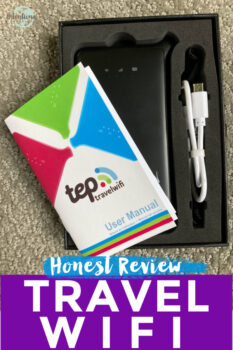
Similar Posts

Amaru Bioparque Zoo: A Must See in Cuenca, Ecuador
“Imagine if Swiss Family Robinson built a zoo on the side of a hill.” That’s how our friend described the Amaru Bioparque Zoo in Cuenca, Ecuador. As you might suspect, it is unlike most zoos you’ve probably visited. While staying in Cuenca, we kept hearing about the zoo. Once we had seen it for ourselves,…
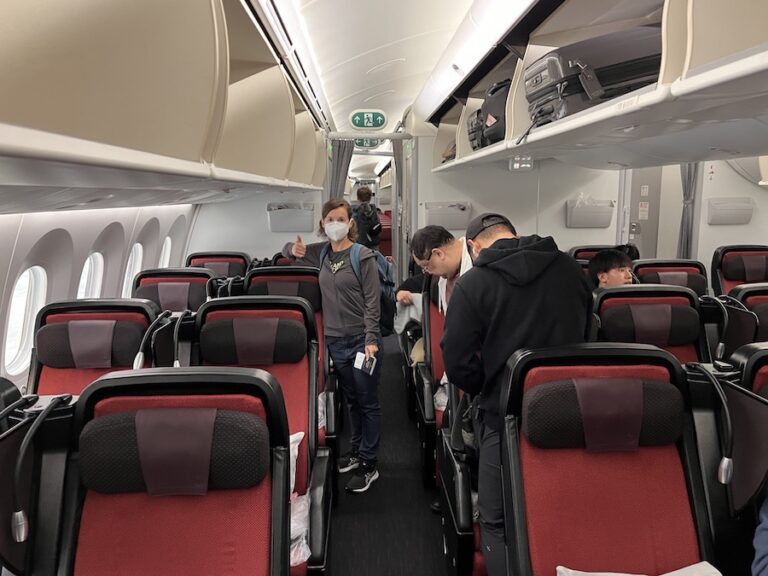
Is JAL Premium Economy Worth It? Japan Airlines 787-9 Premium Economy Review Haneda to San Francisco
We recently flew on JAL’s premium economy for the first time. In those post we’ll share our full review of the flight on the 787-9 from Haneda, Tokyo to San Francisco (HND-SFO) and our thoughts on whether or not Japan Airlines premium economy is worth it. Whatever you might hear, premium economy is not the…

Important Cultural Things to Learn About A Country Before Visiting
We all know cultures are different from each other. But what are those differences? The first time we travel to a new country, we don’t always know what we don’t know. What we may consider “common sense” may not be common – or make much sense – in another culture. By simply acting “naturally,” we…

Ultimate Cuenca Transportation Guide 2024: Public Transit and more
Are you wondering how to get around Cuenca Ecuador? In this post, we answer important questions about Cuenca public transportation, bus system, metro line, taxis, bike rentals, car rentals, and other travel tips for Cuenca. Getting around Cuenca is fairly cheap and convenient. In fact, Cuenca’s walkability is one of our favorite things about the…

6 Beautiful Places to Visit in the Ecuadorian Andes
While the Galapagos and the Amazon might have the best name recognition in Ecuador, the most visited area of the country is actually the Andes Mountain region – and we’ve seen why! The mountains, volcanoes, and valleys are stunning. We found travel through the Andes to be relatively easy and affordable, and we highly recommend it….

Culinary Backstreets Lisbon Food Tour: Song of the Seas Review
Do you love food and exploring local culture? Today we want to tell you about a top notch Culinary Backstreets food tour in Lisbon, Portugal. About Culinary Backstreets Culinary Backstreets is an organization passionate about telling the stories behind a city’s foodways. They promote and protect traditional culinary culture, highlighting masters of their craft and…
One Comment
Hi Michelle and Jedd! This gadget sounds very useful. I will have to do more research to see if it is the best solution for our coming travels. Thanks! ~Kathy
Leave a Reply Cancel reply
Your email address will not be published. Required fields are marked *
This site uses Akismet to reduce spam. Learn how your comment data is processed .

Borders Of Adventure
Leading Culture and Adventure Travel Blog by Becki Enright. Looking at the world with a different angle to change perceptions of misunderstood places, for the best in travel.
Travel Planning
Travel Wifi Review – The Portable Constant Connection You Need
Disclaimer: This post contains affiliate links to handpicked partners, including tours, gear and booking sites. If you click through or buy something via one of them, I may receive a small commission. This is at no extra cost to you and allows this site to keep running.
High roaming charges abroad? Is decent wifi hard to come by? This TravelWifi review shows how portable wifi keeps you connected.
With a monthly mobile phone plan, it’s easy to take WiFi for granted. But when you travel, things get tricky. Either your high roaming charges break a small part of your soul (alongside the realisation that you are addicted to the internet) or WiFi is hard to come by when you need it most – like when you are lost trying to find your guesthouse after your bus drops you off in the arse end of nowhere.
So when wifi providers, TravelWifi (formally known as TEP wireless) approached me about trying their portable WiFi for travel device, I wasn’t going to turn it down. Not only am I an internet browsing addict (reading news, looking at pictures of cats and Facebook stalking), but also I need reliable, consistent WiFi for work. ALWAYS. My sourcing of the internet comes from a steady flow of switching sim cards and saying “Do you have WiFi?” almost daily.

Travel WiFi Review – The Benefits of Portable WiFi
Is there a catch, what happens when your contract ends, portable pocket wifi for travel. recommended, more travel gear.
To a blogger, WiFi is like oxygen and TravelWifi supplied me with a healthy dose. This pocket-sized handheld device now forms part of my staple travel kit and my only girlie gripe being I want a white one to match my iPhone.
However, colour is irrelevant to the connection. Now I can get 3G wireless internet in Europe, Africa, Asia, the Middle East and Oceania. It works in the same way as any other wifi hotspot, except it’s all mine, although I can connect up to five devices to it if I am feeling generous and if you ask nicely.
Other than that, I can’t complain. It’s not bulky (the full kit including charges and a spare battery even comes in a cute and compact pouch), and it connects quickly and easily. All you have to do is turn the device on, find the connection on your laptop or phone and enter the password. It’s as simple as any standard wifi connection.
Any little glitches I’ve had with it have been quickly resolved via Skype or e-mails with the TravelWifi support team. I once had an issue connecting (and I’m sure my e-mails sounded as though I was dying because of it) but it was solved within a day or two with a couple of resets of the device.
Being in random and obscure countries, I’ve been saved by the VPN access of this device too, which meant in Turkey I could access Youtube and Twitter when it was blocked on local connections for example. VPN in general also means better online security, especially in areas where local connections can be a little sketchy.
The main thing I would highlight here is that the cost of €5 per day (for a daily allowance of 150MB) can be a hefty expense if you are on a long holiday. However, if you use wifi regularly, or need it for work as I do, then this is a cost-effective option for long-distance roaming charges – TravelWifi claims to be cheaper than 95% of most carriers.
Find out about costs and Wifi coverage here .
When you need to send back your device or switch it for a new contract in a different country, you can drop it off or pick it up at the airport or pop it straight in the post with supplied pre-paid envelope (or a pre-paid stamp can be sent to you to post from the country you are in if you are not going home). Or, if you inform TravelWifi upfront that you are going to say, three countries, then you can work out your long-term pricing plan and let the wifi coverage roll.
So overall, would I recommend portable wifi for travel? Yes, if you absolutely need WiFi on the road. If you hardly need it and are happy to wait for sporadic wifi connections with your coffee and cake or accommodation check-in, then this option will burn a little hole in your holiday pocket. But if you do decide to connect yourself with the world 24/7, then this nifty little box is easy to use and takes up hardly any space at all.
Now you are sorted for wifi, here’s more product reviews and guides , alongside a tried and tested adventure gear list to ensure you have the right (and not too much!) equipment to capture your travels and make use of the wifi on the go to share it all.
About Becki
Becki Enright is a British Travel Press Award-winning writer whose work focuses on changing perceptions about misunderstood aspects of destinations. Her writing combines storytelling with insight into the social, historical, political and economic factors that shape the country or place in relation to tourism. Becki has appeared live on Sky News and CNN and has contributed to high profile media including National Geographic, Time.com, Guardian online, New York Times, Grazia and Buzzfeed.
Tep Wireless says
28 July 2014 at 3:13 pm
Hi Becki & Taavi,
Thank you for mentioning your case. Taavi, we apologize for the misunderstanding, if you would please let us explain, we would like to do so:
On our website we make it very clear that our unlimited plan comes with a data policy imposed by the network. Taavi unfortunately used an extreme amount of data in 10 days, and was emailed by Tep that she was approaching fair usage limits, at which point we sent her instructions on how to limit data usage. After continual high usage, we then had to ask her to either pay for more data or suspend the service so that she was not charged by the network. Tavi, it is worth noting that you used about 5-6x the average data usage.
We mention our data policy in multiple places when customers place an order:
1) On our cart page when customers select the unlimited package 2) Before customers place an order in our checkout page 3) In our rental agreement that customers sign before placing an order 4) In our order confirmation email immediately after a customer places an order
This information is clearly highlighted on our site regarding the unlimited package. I know that a fair usage policy is not ideal, however our service (and all roaming service) is design for international travelers; people who are on holiday or a business trip abroad. As a data roaming service it is inherently different than domestic country network services, and is not meant as a substitute to residential internet.
I hope that helps to clarify.
Taavi, for the inconvenience we would be happy to provide you with a 50% off voucher for any upcoming trips in the future.
Tep Wireless
Taavi Davies says
28 July 2014 at 12:07 pm
I rented a pocket wifi from Tep after reading your review. Unfortunately, their service is terrible for people who are not reviewing them. I bought a 32-day “unlimited” plan (the unlimited part cost EUR 3.95 a day more than the 150MB/day plan) to use in France. Tep cut me off after 10 days, saying I had reached my data limit – which for an “unlimited” plan, seemed like a mistake. After several emails and calls (wow, it’s difficult to get through to them on the phone) they explained that “unlimited” means “5GB” and I had the option of not using data for the next 22 days, or paying them for more data. And then they hung up.
I hope the pocket wifi continues to work out for you as you travel. But seriously, you shouldn’t recommend it to others.
Best, Taavi
ChinaMatt says
11 July 2014 at 5:22 am
Sounds cool, but might be a bit out of my price range for my purposes. Definitely less expensive than short term plans for portable wifi in Japan though. In Taiwan I broke down and bought a cheap phone that allows me to just switch SIM cards, which makes more sense when staying in each place for a month or more.
11 July 2014 at 12:49 pm
I agree. Long term it’s better, short term, you might find better deals within the country or be able to find local connections sporadically.
Leave a Reply Cancel reply
Your email address will not be published. Required fields are marked *
- Article Archives
- Work with me
- Privacy Policy


The 8 Best WiFi Hotspots for International Travelers 2020
by Paul @ Travel is Life | Feb 25, 2020 | Nomad Life , Tech , Travel Buyer Guides | 62 comments

Hey traveler, while you’re here join my friends list to get all the perks I offer at Travel is Life.
Are you looking for the best unlocked mobile Wifi hotspot for your next international trip? I've got you covered in this international Wifi hotspot guide! For the past three years, our Best WiFi Hotspots for International Travelers guide has been the #1 wifi hotspot resource online connecting travelers with Internet data all over the globe.

Introduction to International Wifi Hotspot Devices 2020
During your adventures around the world, you may have seen other travelers with WiFi hotspots seamlessly accessing the Internet while you struggled with connecting to free public WiFi signals. If you felt a bit envious of their newage digital connectivity, your tech envy days are over, because I've put together a list of the Best International 4G WiFi Hotspots & SIM Cards for Travelers and compared their pricing, coverage, and features, to help you determine the best service for your needs. I've also reached out to each company to negotiate a discount on your behalf so that you can spend your hard earned travel budget on fun activities instead of Internet data.
Table of Contents
- How do WiFi hotspots work?
#1) Skyroam Review 2020
- #2) TEP Wireless Review 2020
- #3) Keepgo Review 2020
#4) Travel WiFi Review 2020
#5) roaming man review 2020.
- #6) Google Fi Review 2020
#7) Always Online Wireless Review 2020
#8) coming soon.
- What's the best Wifi hotspot 2020?
- What's the cheapest Wifi hotspot 2020?
How International 4G Hotspots & SIM Cards Work
The way these international hotspot companies operate is that they've licensed deals with 4G wireless carriers around the world to allow you to transition from one carrier's network to another without having to switch SIM cards and purchase a new local cell phone plan in each country you visit. With some services, you pay a flat fee for wireless access in every area they service, and other services have separate rates for each country. In some cases, you may end up paying more than you would if you bought a local SIM card, but you're paying for the convenience of having a seamless transition between carriers and service wherever you go, as well as Internet access as soon as you step off the plane.
If you're taking a short trip or you're heavily dependent on Internet to run your business like I am, then you may be willing to pay for the convenience. You might also choose to carry one of these hotspots with you as you travel and only activate it for 24 hour periods at a time when you need it, and then switch to a cheaper local plan after you get acquainted in the new country.
Best 4G International WiFi Hotspots for Travelers & Digital Nomads
I've researched your best available options for 4G WiFi Hotspots and World SIM Cards and narrowed them down to these top picks, which I'll compare below. I've also attempted to negotiate a discount for you with each carrier because I love when I can save my readers money on travel technology.
UPDATE Aug 2019: Introducing Skyroam's new Skyroam Solis X . More info about the device in my updated Skyroam review below.
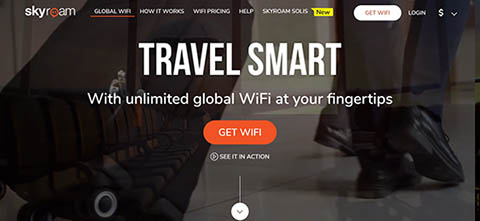
Their new Solis X device ($179.99) doubles as a 4200mAh power bank that can recharge your wireless devices via USB-C and power them with Internet at the same time. The Solis X can last more than 16 hours on a single charge (if not used as a power bank) and connect up to 10 devices at once. The device size is 3.5″ x 0.9″. It includes an 8MP remote operated camera and 4GB of storage, which you can upgrade by connecting to your Dropbox account. The new Solis X also includes an App with Skyroam's new Smart Assistant builtin. The Smart Assistant is basically a connection to IFTTT (If This Then That) service, which then allows you to make connections to other services you use like Twitter, Dropbox, Evernote, Nest, Fitbit, Amazon Alexa, Google Assistant, etc.
They also offer a Solis X Lite device ($119.99) which is the same size, can also connect up to 10 devices, but doesn't offer the camera, speakerphone, or Smart Assistant feature like the Solis X. The power bank is also optional with the Solis X Lite.
These two devices replaced their old Solis device, which you can still use for service if you already have one, but can no longer purchase the device new.
COST: How much does Skyroam cost?
1) UNLIMITED: You can BUY the new Solis X device for $179.99 or the Solis X Lite for $119.99 + shipping (calculated at checkout based on your location) and pay $9/day or $99/month for unlimited Internet. Purchasing the device also includes 1 Free Day Pass.
2) PAY PER GB: You can BUY the new Solis X device for $179.99 or the Solis X Lite for $119.99 + shipping and then pay $6/month for their pay-as-you-go GOData subscription + $6/GB (USA/Europe) or $9/GB (Worldwide). This plan requires that you own the Solis device. So to explain that in a different way for clarification, you pay $6/month for the service no matter what, then you just buy the gigabytes as you use them.
3) You can RENT the Solis X device for $8.99/day + shipping. If you choose to rent, you prepay for shipping both ways, and they include in the package a box with shipping label to return the device from whichever country you choose, or you can drop it off at one of their 150+ worldwide dropoff points.
COVERAGE: What countries does Skyroam offer coverage?
Skyroam provides Internet service in 190+ countries and growing. (It was 130 countries when I originally published this article, so they are definitely expanding.) Keep in mind that their local coverage is only as strong as the local towers they are renting from, so your service with Skyroam will only be as good as the towers around you. Skyroam offers service in a lot of countries, but they don't magically provide Internet where towers don't exist!
Speed Throttles: If you use over 500mb in one day on the $9/day or $99/month plan, they switch you from 4G speed to 2G/3G for the remainder of the day and then set you back to 4G speeds the next day. If you pay the $6/GB (USA/Europe) or $9/GB (Worldwide), you will always have 4G speed.
URL: Skyroam.com
Best Skyroam Alternatives: TEP Wireless
Skyroam Cons: 4G speed is limited to 500mbs/day on their unlimited plans.
Skyroam Discount Codes: Use this link and promo code “ TRAVELISLIFE ” at checkout for 10% off your entire purchase or rental.
#2) TEP Wireless / Travel Wifi / Sapphire Review 2020

TEP Wireless stands out amongst the crowd of hotspot providers because they offer a lot of valuable extras with their subscription including the following.
1) Prime WiFi – Free WiFi hotspot access at over 60+ million hotspots worldwide + free in-flight WiFi service on American Airlines, Lufthansa, Etihad and Air Lingus fleets equipped with WiFi. This is a HUGE perk because it'll allow you easy Internet access even in places with poor cell phone coverage.
2) Kitestring – an SMS based emergency service that checks in on you while you travel via scheduled text messages that you sent the frequency of. If you don't reply to the text, Kitestring sends your emergency contacts an alert message.
3) TEP Guru – a free local concierge service that privately connects you with locals via their TEP+ App who you can ask for recommendations on things to do, places to eat/drink, and where to stay from 9am to 8pm every day.
4) VOIP Phone & SMS Service – built-in to your service via their app with international calling prices that cost about $0.01/minute.
COSTS: How much does Travel Wifi / TEP Wireless “Teppy” cost?
1) You can RENT a Teppy starting at:
- $8.95/day for 5GB of 4G service (includes travel adapter)
- $11.95/day for UNLIMITED 4G service (includes travel adapter)
The actual prices listed above vary by country, and there are too many to list. However the more expensive countries only add about $1-3/day to the numbers above.
Shipping to you is free for a few countries but ranges in price for the rest of the world. You can then either return the device to one of their drop off points for free or pay to ship it back to one of their warehouse locations.
2) You can BUY a Teppy for $149 + $9.95 shipping (or higher depending on the country) which includes 1GB, and then Pay As You Go. There are too many pay-as-you-go options to list them all, but they've got plans through Sapphire ranging from Pay-Per-MB/GB all the way to Unlimited Daily plans like when you rent. You have a lot more options when you Buy the Teppy vs Rent the Teppy. With Daily Unlimited Pay-As-You Go plans, you can start and stop service anytime for 24 hour coverage windows. Purchasing the device comes with 1 Free Day Pass.
2) You can Subscribe to a monthly plan. Update Jan 2020: Monthly plans are no longer offered.
3) You can BUY a Travelwifi SIM Card for $34.95 with 20GB included and use it in your unlocked phone, then use your phone as a hotspot to connect other devices. This is currently offered in 85 countries. After you use up the initial 20GB, you can re-up your data with similar data packages as offered above.
Coverage: TEP Wireless works in 130+ countries. Now before you go thinking, “But Skyroam works in 190+ countries!” , keep in mind that you probably won't be visiting that many countries on your next trip. So you only need to make sure that these devices work in the countries that YOU are going to. You'll want to consult both of their websites to check your specific travel destinations for coverage before purchasing or renting.
Speed Throttles: After you've used 1GB/5GB per day (depending on your plan), your connection speed gets slowed to 256kbs until the end of the day and then the speed resets the next day.
URL: TEPWireless.com
Best TEP Wireless / Travel Wifi / Sapphire Alternatives: Skyroam
Full Review: For more info, read my full TEP Wireless Review & Comparison .
TEP Wireless / Travel Wifi Cons: Throttled 4G beyond 1GB. • Shorter battery life.
TEP Wireless / Travel Wifi Discounts: Use this link to TEPWireless.com and discount code 0TEPTILORG10 for 10% off your purchase or rental.
#3) KeepGo Review 2020

COST: How much does Keepgo cost?
UPDATE February 2020: Keepgo significantly reduced the cost of their data last year. This month they introduced a new GoFi Europe USA Plan for cheaper data in those countries. More info below.
Their SIM Cards cost $49 and their WiFi Hotspots cost $99 with free shipping to 38 countries. Their hotspots weight 75 grams and can power up to 16 devices for up to 11 hours per charge. Worldwide Data is priced in bundles at $14 for 500MB, $26 for 1GB, $61 for 3GB, $88 for 5GB, and $165 for 10GB. Their new GoFi Europe USA Plan offers data at a flat rate of $8/GB in those regions. You can switch between the plans anytime. They do not offer device rentals or unlimited plans.
Coverage: Keepgo offers service in 100+ countries.
Speed Throttles: Keepgo does not throttle your 4G speeds since you are paying per gigabyte. This is a huge perk of their service. If you're willing to pay for the data you consume without worry of being slowed down, then Keepgo is a good option for this reason.
URL: Keepgo.com
Best Keepgo Alternatives: Skyroam – specifically their new GoData Plan
KeepGo Cons: No unlimited data plans (yet).
KeepGo Discounts: Use this link to Keepgo and promo code TRAVELISLIFE for 10% off your purchase.
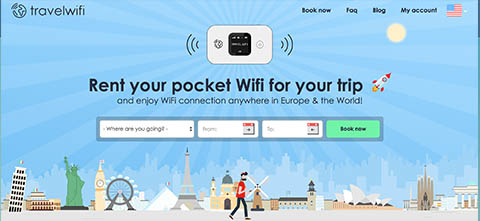
COST: How much does Travel Wifi cost?
Travel WiFi is now part of the TEP Wireless / Sapphire family of services. See my review of TEP Wireless above for their updated pricing.
Coverage: Previously Travel Wifi catered to France and Europe and offered limited Worldwide coverage, but now that they merged with TEP Wireless and Sapphire, they are able to offer worldwide coverage in 130+ countries.
URL: TravelWifi.com
Best Travel WiFi Alternatives: Skyroam
Travel WiFi Cons: No option to purchase device. • Shipping rates increase outside of France.
Travel WiFi Discounts: Use this link to Travel Wifi and the promo code “ 0TEPTILORG10 ” for 10% off your purchase.
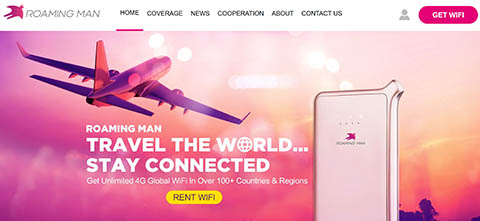
COSTS: How much does Roaming Man cost?
Roaming Man ‘s rental service starts at $7.99/day in North America, Asia, and Europe and $9.99/day in the rest of the world + shipping in both directions and they require a minimum of 5 days rental period. As of Dec 2018, they now offer an option to purchase a device for $149.99 which you can activate with service as needed.
Coverage: 130+ countries and regions. .
Speed Throttles: If you use over 500mb in one day, they switch you from 4G speed to 2G/3G (or around 256kbs).
URL: RoamingMan.com
Best Roaming Man Alternatives: Skyroam or TEP Wireless
Roaming Man Cons: 4G speed is limited to 500mbs/day on Basic and 1GB/day on Premium with no option to add more.
#6) Google Project Fi Review 2020

Currently through Google, you can purchase the Pixel 4 & 4XL, Pixel 3a & Pixel 3a XL, Pixel 3 XL, and Moto G7. However you can also check their compatibility list to see if the service will work with our existing phone. (For example, it'll work with my Verizon unlocked Samsung 9.) Their service lets you seamlessly shift from their cellular coverage partners to over four million WiFi hotspots around the world. You are only charged for data received over their cellular network and not when on WiFi networks. You can port your existing phone number over to Project Fi from your existing carrier or get a new number. In the USA, they partner with Sprint, T-Mobile, and U.S. Cellular to provide coverage.
Cost: Project Fi offers worldwide flat rate service fees w/ free calls to 50+ countries and rates starting at 1¢/min to other countries. They offer a combination of Pay-Per-GB and Unlimited Plans for individuals and families including:
- Individual: $70/month for unlimited calls, texts, and data (High-speed data up to 22 GB/person & slower after)
- Family: $16-$18/month for unlimited calls & texts + $10/GB for data
- Family: $45-$60/month per line for unlimited calls, texts, and data (High-speed data up to 22 GB/person & slower after)
For the Pay-Per-GB plans above, you only pay that amount you use at exactly $10/GB. So for example, if you used 1.226GB you'd pay $12.26 (not $20 for 2GB like some companies who charge for the next tier up).
Each plan also includes a free Google One membership ($19.99/year).
You can add as many tablets to your plan as you'd like for free and just pay for the data they use. While traveling outside of US, a flat $0.20/minute applies. While calling from within the US, international rates apply and vary by country. International data is the same flat rate of $10/GB in every country.
Coverage: 200+ countries and territories .
Speed Throttles: The unlimited plans throttle your speed after 22GB per month, however you can then switch to $10/GB if you need more 4G speed that month. The Pay-Per-GB plans throttle you after 15GB.
URL: Fi.Google.com
Best Google Fi Alternatives: Keepgo or Skyroam
Google Fi Cons: Only works on certain devices. • No hotspot devices. • No discount offered to Travel is Life readers.

Cost: Their SIM Card costs $14.95 + $5 shipping. Data rates start at $2.99/day, $0.11/hour, and $0.01/mb but vary per country. Their international rates average about $1.99/hour for 20mb, $9.99/day for 200mb, and $49/GB.
Coverage: 90 countries.
Speed Throttles: They do not throttle your speeds since they are essentially charging you per megabyte to be used within a window of time.
URL: AlwaysOnlineWireless.com
Best Always Online Wireless Alternatives: Keepgo
Always Online Wireless Cons: Data fees vary by country (sometimes substantially). • Separate data plan for each country. • No discount offered to Travel is Life readers.
I'm currently looking for a new service to replace them on my top 8 list since I had to remove one of them from the list. I've spent months and a lot testing / research with hotspot companies, and I'm narrowing in on one to add to the list soon. Rest assured, the wheels are in motion, but for now, I'd rather have a GREAT list of seven options than just add an eighth for the sake of having 8 options. In the meantime, stick to one of the other options mentioned on this list.
Which is the best mobile hotspot 2020?
If unlimited data is important to you then Skyroam or TEP Wireless will be a good choice because of their unlimited data options, flat rate pricing, and affordable devices. (Note: If you do go with Skyroam, be sure to use our promo code TRAVELISLIFE at checkout to save 15% off your entire purchase or rental. And if you go with TEP Wireless be sure to use our promo code 0TEPTILORG10 for 10% off.)
If you'd rather pay per gigabyte and have unthrottled 4G speed no matter how much you use, give either Skyroam or Keepgo a try and use our link for 10% off your purchase. If you have any questions about which service will fit your needs best, drop me a comment below and I'll do my best to help you out.
What's the cheapest WiFi hotspot service?
The least expensive hotspot for daily use is Skyroam with their $99/month unlimited plan which come out to $3.30/day for Internet access.
Keepgo doesn't offer an unlimited plan – but their data does not expire. So if you're only looking for occasional or emergency use Internet abroad, you can purchase 1GB from KeepGo and only use it when you need it. For minimal usage, this can be a savings because you're not paying for unlimited data that you don't need. Use this link to Keepgo and promo code TRAVELISLIE for 10% off your purchase.
See Also: Best International Data and Cell Phone Plans from USA Carriers
Travelers found this article by searching:
• International Portable Wifi Hotspot Reviews • What is the best portable WiFi hotspot for international travelers? • Unlimited Worldwide 4G Wireless Plans for Traveling • Best data plans that work in every country • Best international wifi hotspot devices for travel • Best mobile hotspot unlimited plans • How do I get Internet anywhere in the world?
If you like it then you should've put a Pin on it!


International Wifi Hotspot Frequently Asked Questions (FAQs)
Since publishing this article, I've received hundreds of e-mails from travelers asking my advice about their particular situation and which hotspot service I'd recommend. I've responded to all of them privately, however, the questions they ask could benefit other readers. So moving forward, I'll be publishing some of the questions below as FAQs (however removing any personally identifiable information from the question). If you've got a question, feel free to contact me as well.
Why is Glocalme not in your review, as their devices seem pretty convenient and affordable?
I'm familiar with GlocalMe. They're actually owned by the same company who own Roaming Man who I do include on the list.
Can I use a Skyroam plan with a different hotspot device?
As far as I know, you cannot use a Skyroam plan with a 3rd party device. If you're interested in using your own device, look into purchasing a SIM card from Keepgo or TravelWifi .
To help soothe my 93 year old mother’s worry when I travel to KSA and countries in Eastern Europe, I am thinking about purchasing (not renting) a portable wifi hotspot and have read your recent reviews. The Roaming Man purchase device highly rated by you is out of stock and I have heard some recent concerns about Solis regarding connectivity/dropped signals. Any advice?
Reviews about these kinds of devices are tough because they're so anecdotal. So someone in a rural part of France could have a negative experience with Skyroam/ TEP / Roaming Man (or whichever) while someone else in Paris could have zero issues. The variance is that any of these devices are connecting to local towers, which play a big role in how people perceive the device itself.
I personally use Skyroam and TEP Wireless — which are also the two highest picked choices by my readers. However I'm mostly in South America (although was in Georgia for two months this year and it worked fine there). Those would provide you with the most options if you own the device itself. You could also just pick up a cheap unlocked second phone as a device and use Keepgo for emergencies only (because the data lasts a year and doesn't expire if you up it a little each year). For example, you can get new unlocked phones for like $100-200 and use them as a hotspot with an International SIM like Keepgo and have the best of both worlds.
Sorry it's hard to give specific advice. So much is country / regional specific as to how well your devices will connect. You might want to make a list of each country you'll be going to and cross reference the coverage of the specific companies you're interested in to see which would provide the best coverage overall. I think you'll find that those three companies will be pretty similar though coverage-wise.
Happy to help if I can offer further assistance. The advice above is what I use / what I would do in your shoes.
I am considering being a digital nomad and traveling extensively. In the past, I just got a SIM card that included tons of data (EE, Vodafone). Your article on The 8 Best WiFi Hotspots for International Travelers is informative but can't help with my needs, as the options have data/ speed thresholds/ limitations. Am I already doing the best bet by simply tethering my cell phone's wifi to my computer? Know of anything else?
I mostly use the hotspots for convenience purposes, but like you, when I stay long periods of time places, I just buy local SIM cards from local carriers. That's always been the cheapest option for me. FYI though – not all of the options I profiled in that article you found me on have data caps. Keepgo for example doesn't throttle your speeds.
The only other suggestion I have for you is to look into subscriptions for WiFi hotspots around the world like Skype Wifi (formerly Skype Access) or Boingo. But it might be hit or miss with whether they offer wifi near where you're traveling. Sounds to me like you're on the right track with what you've got now.
Question / Suggestions
If you've got a question or suggestion, feel free to contact me or leave a comment below.
62 Comments
Looking for something while on a cruise ship. Ship charges a fortune for one device. Any recommendations?
Cruise ships really are expensive for Internet! Unfortunately, the hotspots on this list won’t be much better for you because they connect to local towers. And none of the options on this list that I know of offer service in open water. I had written another article about the Best International Data and Cell Phone Plans from USA Carriers – but unfortunately they don’t offer great options either. Cruises are a tough one as you know. Sorry I can’t be more helpful to you.
What about countries in the Middle East, such as Kuwait, Saudi Arabia, Iraq, and Turkey? Which would be best?
Hi Matt – Looks like many of them including Skyroam and TEPWireless (which have been the two most popular so far with my readers) offer the coverage you’re looking for. TEP’s got the ability to upgrade the amount of 4G data in your package for an extra couple bucks a day but Skyroam has the new unlimited monthly plan for $99/month – so depending on how long you’ll be traveling, that might be a good fit.
Do you know if any of these (or any others) will offer wifi while on a plane? I’m traveling from JFK to South Africa on South African Airways, and the plane does not have in-flight wifi.
Hey Cammi – At the moment I don’t know of any. TEP Wireless advertises on their website that their In Flight WiFi feature is coming soon and will be included with their plans, but a date has not been announced for when that’s going to happen. Sorry that doesn’t do much to help you on your upcoming trip. If you happen to find something that works for you, please pop back in and let me know and I’ll update the post to help others as well.
looks like the inflight is up
Thanks Dahlia – good find. I just confirmed with TEP Wireless too. (Not that I don’t trust you haha I just always confirm every update.) They just wrote, “Tep’s in-flight service covers American Airlines, Lufthansa, Etihad and Air Lingus fleets equipped with WiFi.”
I’ll update my post accordingly. Thank you again for the heads up.
Thanks for this helpful article! I am planning for our Summer trip to Europe and I am still searching and comparing the options for wifi rental. Would like to add a few things:
– Skyroam monthly rental of $99 is only available to existing customers who have already bought their device. And the rental renews automatically until cancelled. I have confirmed these after calling the company
– There are many negative reviews about Tep Wireless on Tripadvisor.com, mostly are from a few years back
Since Skeyroam service is so new, how can we get reliable review on their services?
bWise – You’re the best. Thank you for discovering that info about Skyroam and coming back here to share it with me and everyone reading this. I will update this post later about the $99/month only being available to customers who own the device and about it auto-renewing. Thanks again and enjoy your summer trip to Europe!
Thanks for the comprehensive article. We are Canadians going on a 21 day trip in France, and will not need any special wi-fi device after that. For that reason, rental is the best for us, I think, but I can’t find many options. What do you recommend?
Hey Mina – Your trip around France sounds like a blast. Perhaps Skyroam would be the most ideal and economical option for you if you need a lot of data since they offer the 30 Day Unlimited Package for $99. The caveat to that is you have to BUY the device itself for $149 so it’d come out to about $248 for the 30 days and you’ll have the device forever after that to activate when you please. Alternatively, Keepgo can sell you a SIM Card that you just pay for however much data you think you’ll need over the 3 weeks (or can always add more along the way). That method is economical if you won’t require unlimited data. You can just buy 2 GBs for the trip. Lastly, if you’ve got an unlocked phone, you can always just buy a local prepaid SIM Card in France. 3 weeks is enough time that it may be worth it for you to dedicate an hour when you first arrive into finding a local prepaid plan. The downside of that avenue is that you won’t have Internet the moment you get off the plane (which you might need) and you have to deal with local companies, but it’d probably be the least expensive option of the three I outlined above. If you have any specific questions though, feel free to ask here or e-mail me at [email protected] and I’ll do my best to steer you in the right direction. If you end up going with a different option all together not mentioned on this page, please pop back in and let me know. I want to keep this page updated with the best options.
Which device do you recommend for doing a live Instagram video abroad?
Hi Manuel – Technically any device that connects to 4G could handle that job, but perhaps consider either Keepgo (who don’t throttle 4G speeds at all) or TEP Wireless (who allow you to upgrade to 1GB of 4G speed per day). Because if you’ll be live streaming a lot, I’m thinking that paying for access to 4G speed would be in your best interest versus getting throttled mid-way through a live stream.
i highly recommend google fi 😀
works like a charm
I think it is worth pointing out that Skyroam has a more limited world coverage than TEP does – including pretty popular countries like Japan. This was definitely the most important factor in making my choice.
Hi. Thanks for the comprehensive survey. Kindly advise – I travel several times a year each trip 7 to 10 days, worldwide. I’d like to purchase a device and activate it for each trip separately. My data demands are not specially large. What would you recommend? Thanks in advance for your kind assistance.
Hi Udi – If you’re looking for a device (and not a SIM card), consider Skyroam . They’ve been my most popular choice amongst readers. You can purchase one of their devices and then activated it as needed before your trips. Please note their coverage area though. While their service may be great in the areas they cover, you’ll want to double check that they cover the areas that you specifically will be traveling. Good luck!
Hej, Both Skyroam and Ted don’t cover Montenegro and some other countries in Europe. And Roaming Man device sell them ONLY inside US. I live in Sweden and traveling to Montenegro, need a large data and 4 G speed. What kind of device could you recommend for me? I want to buy one…😊 Best regards/Anna
Hi Anna – Sorry to say but it doesn’t look like any of the foreign hotspot companies cover Montenegro. I’m thinking it’s because of the telecommunication companies in Montenegro not offering roaming agreements. That’s usually the case when NONE of the companies offer it. Even Travel-Wifi which specializes in Europe can’t offer service in Montenegro. Sorry to disappoint! Sounds like the best and only option for you would be to just pick up a local SIM card after you arrive. If possible, don’t do it at the airport though because they are usually heavily inflated prices. If you end up finding a better solution, please pop back in and let me know so that other people reading this can benefit from your research. Have a great time on your trip!
Hi Paul – Loved your info here! I’m doing a one time 10 day trip to Spain by myself and have an Iphone 8 w/Verizon service, I don’t want to buy a device (wouldn’t use it enough) and will need to use mapping, texting, and internet. I will be driving around the country and need reliability. I also have an older Ipad I’m taking that has AT&T wifi…Not sure if that can be connected too? EEEk I’m not tech savvy and need a little guidance on what would be the easiest way to be connected and stay connected while I’m there.
Many Thanks! Susan
Hi Susan – Thanks for stopping by before your trip. In a nutshell you’ve got three options:
1) You can buy a roaming package with Verizon Wireless for your trip and use your existing device and SIM card. I have more info about that in my article Best International Data and Cell Phone Plans from USA Carriers or just give Verizon a call to inquire. This is the most expensive option.
2) If you want to use your existing device (and not buy a separate hotspot like Skyroam or TEP Wireless ), you can get an international SIM card from a company like Keepgo to replace the Verizon SIM in your iPhone while you’re away. A service like Keepgo will connect your existing phone to 4G towers across Europe. You pre-purchase the data in GB packages and use it as you need it. This is significantly less expensive than option 1, but not as cheap as the next option.
3) You can show up in Spain, find out who their local cell phone carriers are, and buy a SIM card and prepaid plan for 10 days. A quick Google search showed me that they have four carriers: Orange, Movistar, Vodafone, and Yoigo. So you could find a store on your first day in town and purchase a prepaid plan. This would most likely be your least expensive option. Just don’t buy anything at the airport even if you see those companies with a booth setup because they often charge you 10x the price that you’d receive at a local store. Make sure to bring your passport too because they will most likely ask.
Options 1 and 2 would be your most convenient because you’d have Internet from the second you stepped off the plane without any logistics of finding a local store and getting setup with a prepaid plan, however option 3 is the least expensive. Good luck! Holler if you have anymore questions.
Looking for low-cost long-term emergency access both at home and abroad with a lot of data available when I do need it (up to ~5GB/day)
I would imagine that Keepgo would be your best bet from this list because you can top up the data once a year so that none of it expires, and there is no data capping so you’d have a lot of data when you need it.
Thanks so much for your help with this….much appreciated! Happy Travels 🙂
Well this is frustrating. I tried a Sprint hotspot about ten years ago. It was expensive ($150/mo) and provided very little data (6GB/mo). Speed and price have gone way up, but actual amount of data is still pretty much the same…
Think so? Skyroam is at $9/day or $99/mo for unlimited data or $9/GB for pay as you go. Far cry from the $25/GB you were paying with Sprint.
Have you researched Glocalme with the G3 hotspot and new S1 world phone? I’m trying to decide between getting a new device with google fi and/or a hotspot/phone with Glocalme. I go to Japan yearly and for two months at a time. I’ve rented hotspots in the past but I think owning my own or having a better longer term options makes more sense as time goes on. I like keepgo and have researched all of the other options in your list. My two main goals are that whatever I can get can work simply between us, croatia, slovenia, turkey, and japan. And my other goal is that is get get fast, unthrottled speeds in Japan for video work. Google fi throttles but at a higher point than most others.
Hi Javon – GlocalMe is the same company as Roaming Man which is why I did not include it on the list twice for hotspots. I’ve got another resource coming out about International SIM Cards (versus hotspots) and was considering bringing attention to that S1 world phone on there or making a separate article about world phones. There’s a bit of an overlap between these companies when it comes to hotspots, SIMs, world phones, but some companies only provide one or the other. It’d be a tough call if I were in your shoes too as to what to do. I personally like being able to use my same device everywhere, versus having to have a separate international phone just for traveling, which is why I’d probably do Google Fi if I were in your shoes, so that I could use a Pixel 3 the rest of the year in USA too. Sorry I’m more than a week late replying to your comment. Just curious, had you made a decision since then? And if so, what’d you decide to do?
Hi Paul, Have you heard about Sapphire Hotspot. My friends are using it and I wonder how well it works compare to Skyroam. Thanks
Hi Eric – No I have not. I added it to my list of hotspots to check out in the future though. Thanks for bringing it to my attention. What do your friends think of it?
Hey Paul, I liked your write up on TEP Wireless & was going to go with it. All though I read a horror story on them elsewhere. But it was dated in 2014 & yours was more current. I tried your code “A7YKMS7Z10 – 10% discount”. & it didn’t work. Do you have a new code for them? Fingers crossed to use them. I need a Wifi Hotspot connection in Mexico next month…
HI Louie – Thanks for letting me know that the code expired. It’s for a limited number of uses and unfortunately the only way for me to find out it’s run out is when someone lets me know. I reached out to my rep at TEP Wireless and will have the code updated on this page as soon as I have it. I also made note to e-mail you directly with the code when I have it so that you don’t have to check back. Normally they set me up with a new code within a few days, so if you can’t find another one before then, I should have a working one again by end of the week. Thanks again.
All set – same code is active again for another 200 uses. Thanks again for letting me know it had reached its limit.
Hi Paul -Great reviews and advise. Looks like the TEP code is no longer active. Any chance you can renew for another 200 uses? Thanks!
Hey Cliff – You rock! Thanks for letting me know. I just e-mailed TEP Wireless to have it renewed. I’ll post an update when it’s ready, but I also made a note to e-mail you directly when I hear back from them. Thanks again.
Cliff – New code is now active and updated on the site. Thanks again for letting me know.
Loved your thorough article! I’m another cruise traveler but am fine with coverage while in port. We’re traveling from the US to Morocco (one week at sea) then hitting many of the small islands (Canary, Funchal, Azores) on our way around western Europe (Portugal, Spain, France, Northern Italy). I tried chatting with TEP Wireless and the agent mentioned very spotty service in the island areas and they didn’t answer the question about whether or not I need to pay for service for the week we’re at sea. (In their defence, I was in a hurry and didn’t re-ask the question) What is your opinion regarding paying for the TEP Wireless daily use plan vs daily ATT phone charges while in Africa and switching to a European SIM plan once in mainland Portugal? Or did I miss the boat completely and you’ve the perfect solution (apologies for the pun).
Hi Jodi – Unfortunately if you rent a Teppy, I believe you’d have to pay for the service the entire time you rent it (which means the week you’re at sea). However, it’s worth a follow-up call to ask again. Maybe they’d send you the device early but only activate it and have you pay for the service after the cruise. It’s worth a shot asking.
You might want to consider Keepgo and buying one of their international SIM cards and just using it in your existing phone when you need it. Then you’re only paying per GB instead of per day, which might be a better fit for you for this trip.
Regarding TEP vs ATT… definitely not ATT. Their international plans are crazy expensive. I don’t mean to single out ATT either because in general, utilizing the international roaming with your US cellular plan is never usually a great choice. It’d be cheaper to buy a gig or two from Keepgo like I mentioned earlier. However, I do support getting a local SIM in Europe once you arrive in Portugal if you’ll be there a while because that would be your most affordable option. Just don’t buy it at the airport because they’re always like 10x the price. Wait until you go to a local store outside of the airport.
Does that advice help at all? Feel feel to reply back with additional questions if not.
Google Fi throttles data at 15GB. It seems to be 256kb. So, it is free data after paying $10/GB for the first 6GB, but any use over 15GB is throttled until the start of the next billing cycle.
Thanks for the info David. Do they give you the option of paying $10/GB beyond the first 6GB and NOT throttling?
Hi Paul, I travel and live in India (Kashmir) and Nepal for 3-6 mos. a year. I work for most of that time and need the internet to connect with the program I use as well as clients. I can work up to 3+ hours a day but less at times…I have an indian sim but wifi is iffy in Kashmir particularly and my plan doesn’t provide much time on the hotspot. I am “older” and not incredibly tech savvy and there are so many programs/devices out there it is confusing as to which would be best for me? Can you help me out? it would be much appreciated. thanks in advance! robin
Hi Robin – One thing to keep in mind is that these international hotspots are going to connect to the same towers that your local carriers are using. The international providers are merely renting their usage through roaming agreements. So if the areas you are traveling don’t offer a high enough quality connection, chances are that the international hotspots listed on this page are going to offer similar connection speed. The caveat to that statement is that there are often multiple sets of towers from different local providers in each area, so the international hotspots could potentially use the competitor towers which might be better. I don’t have a way of knowing though, so I wanted to provide realistic expectations.
The other bad news is that none of the carriers listed above offer service in Nepal, so you’d still be limited to working with whatever local carrier you use now. There is often overlap because the geographic coverage of these international hotspot companies because their coverage relate directly to roaming agreements. If for some reason, Nepal doesn’t offer international roaming availability at this time, then none of the major providers are going to offer service there. If anyone does first, it’ll be one of the companies on this list.
I think your best option is to continue with local carriers and go with an unlocked hotspot that you can use in any general hotspot device, which I’m unfortunately not familiar with enough to recommend one in particular. They’re pretty simple devices so most would do the trick – as long as they’re unlocked and not specific to a carrier. Please let me know if you have any more questions, or alternatively what solution ended up being best for you so that others reading this can benefit from your research. Thank you!
Hi, I am planning a year long family trip ‘around the world.’ We will spend quite a bit of time across Europe, the Middle East, Asia & Australia as well as some time in the US and Haiti. During this time, my children will be attending school via distance learning – they need approximately 4 – 6 hours per day (3 – 4 days per week) of live video conferencing via Adobe Connect. Is there any service that can handle this without a bill the size of a mortgage?
Thanks so much for your help!
Hi Mike – Your year long trip sounds amazing. I love hearing about families having experiences like that.
Regarding your question about Adobe Connect video conferencing… I did some research on Adobe’s website and found this PDF where they breakdown bandwidth requirements for web video, but they don’t easily translate that into actual MB usage.
From case studies I’ve seen in the past, it takes about 150MB / hour for video conferencing, but that differs on the video resolution you’re using and on the service itself. So for you that’d be about 600-900 MB per day, which technically would keep you under the typical 1GB daily data cap on 4G data that most of these services have to employ because of their Fair Use Policies and roaming agreements. So perhaps something like the unlimited monthly plans with Skyroam and TEP Wireless would serve you best, assuming they cover the areas you’ll be traveling which you’ll want to check ahead of time.
If any of the video conferencing is being streamed on your phones, you might also look into a service like Speedify which bridges Wifi and Cellular connections together, but prioritizes Wifi. So that way you can connect to Wifi whenever possible, but if it’s not strong enough, the Cellular 4G signal will fill in the gaps so you don’t lose connection. But remember that’s only for when streaming on your cell or tablet that has both a Wifi receiver and a SIM card.
Just throwing some ideas out here because you’ll be consuming a lot of data, so a happy balance between Wifi and 4G might be best whenever possible. Please follow up if your research takes you in a different direction. I’d love to know what works best for your world schooling scenario so I can share the solution with other families in your shoes. Good luck!
Hi. I will be travelling the length of Japan, camping along the way for 3 months. I need a reliable internet connection for daily use of email/Skype and Google maps. Can you advise which option would be most suitable? Thanks!
Hi Ronny – That sounds like an amazing trip. I hope you have a great time! 3 months is a healthy amount of time to be in one country. Aside from my suggestions of hotspots, you may also want to consider a local prepaid plan (ie: buy a prepaid SIM from a local carrier after you arrive in Japan). That would typically be your least expensive option. These hotspots I mention are great and very convenient, but you pay a premium for the convenience. For a three month trip, it might be worth the time to buy a local SIM (whereas you wouldn’t want to take the time to do that on a short trip). Alternatively, I recommend going with either Skyroam or TEP Wireless and subscribing to their $99/month unlimited plans because that would be your least expensive route versus paying for a daily rate. (Look in the article above for my current discount codes.) However keep in mind that both of those services use hotspot devices. If you’d like to just replace your SIM card with an international one and use your phone for Internet in Japan, consider Keepgo . You pay per GB with Keepgo so you’d have to be mindful of your usage (especially with Skype) as opposed to Skyroam or TEP Wireless which offer the unlimited plans. All three of those services I just mentioned work in Japan. Good luck! Happy to answer any additional question if I can help.
Recommendations for Costa Rica? We are going for a week in May and need something to keep connected (mostly posting to Facebook, Instagram and playing movies, games and apps for my son’s Kindle during down time). The Air BnB has free Wifi but I am hoping for something for the travel to and from (about and hour and a half drive from airport). Also looking for Wifi calling and texting (iPhone messages) to check on the dogs back home.
Hi Michelle – If you’re looking to add Wifi Calling & Texting into the mix, sounds like TEP Wireless would be your best bet. Alternatively, you could use any hotspot on the list above (or connect to Wifi at your Airbnb) and use a Wifi phone/text service like Google Voice. Last option, Verizon Wireless and AT&T also have Wifi Calling/Texting as a free service with your plan, so if you use either of them, that may be worthwhile. If you’re not familiar with the feature, it basically means that you can call and text when you don’t have service from any device connected to Wifi. If you did that route, you’d want to turn off Mobile Data on your phone and just connect via Wifi. Then your calls and texts would still work. Just be sure to contact either company ahead of time incase they need to activate the feature on your account and/or phone. If hypothetically you had TEP Wireless or any of those other hotspot devices, you’d be connecting to them via Wifi, so the Verizon Wireless or AT&T Wifi Calling/Texting would work the same. Just throwing that out there because maybe you don’t actually need the “Wifi Texting / Calling” that TEP Wireless offers if you use AT&T or Verizon. Have a great time on your trip!
Hi, Do you have a TEP Wireless discount code that works? When I enter: A7YKMS7Z10 it says it’s an invalid code. Thanks!
Hey Julie – Thanks for bringing it to my attention that the code is no longer active. I messaged TEP Wireless to renew it. I’ll update this post at the time, but also made note to e-mail you directly. Thanks again.
Julie – New code is now active and updated on the site. Thanks again for letting me know.
Thanks for this super helpful Article! My gf and I are both designers and are planning to travel in our SUV and freelance on the go. Therefore wifi is one of the main things that we need to figure out. At the moment it does seem like Skyroam or TEP are the best options since they have a flat rate for unlimited. I can def do more research into this but any more information or personal preferences/reasons that you can provide may help us make a decision too. Maybe you know of other freelance designers whoa re in the same position? What are they using? We will be in South America to start (probs for the first year) then may end up somewhere else. Nothing is planned that far ahead but we do know for sure that we will be traveling and designing so wifi is crucial. Looking forward to your response and insight!
Thanks MJ – glad the article was helpful. Your travel plans sound awesome, but I’ve got a soft spot for Central and South America. I’ve spent most of the last 5 years there, minus a few months in the Philippines. Don’t skip Ecuador! Regarding hotspots, I think that you’re spot on that TEP Wireless or Skyroam would be good options because of their unlimited plans. Sounds like you’d be using a lot of data like me. Keep in mind too that if you were to buy a device with Skyroam, you don’t have to do the unlimited plan forever. You could certainly do that when you need it, and then just activate it for daily usage other times. If you’re going to be spending a lot of time in Central/South America than you may also find it best to use a combination of these devices for convenience, and then local SIM cards other times if you’re going to be spending a significant amount of time in one country. That’s what I do. Good luck with your trip! Keep in touch on my Facebook .
Interested in a mobile hotspot (MiFi/WiFi) but concerned about the locations I visit such as the Philippines and Thailand. What type of coverage can one get being the network so slow there? I need to be able to access or have the ability to stream either music or movies.
Good question. The Philippines was harder for me in some areas. The thing is with these international hotspots is that your coverage with them will only be as good as your coverage with local carriers, because they’re roaming off the local towers. So many areas of the Philippines and Thailand are great, other smaller islands aren’t as good. It’s too hard to generalize an entire country when it really comes down to the specific areas you’ll be using the device. Wish I could offer more guidance here, but predicting coverage is nearly impossible. The countries you mentioned are covered by most of the hotspots on my list, but individual results may vary depending on how rural you’ll be traveling. Good luck and enjoy your trip!
So I’m headed to Iceland next week and will need to be doing some work while I’m there. We’ll be caravanning and camping around the island and as a designer, I’ll be designing posts, editing images and other products and will need a solid connection to my google drive as that’s my server. What would you recommend for the week that can help me stay connected and productive while out in the middle of nowhere. I’m open to either renting or buying as I do have an agency and this hotspot could come in handy for future trips.
Thanks, Rob
Hi Rob – I hope I’m catching you in time before your trip, or if not, that you found a great solution from the info in my post. Skyroam and TEP Wireless have been my two most popular options, and both work in Iceland. The concerning part is when you say “while out in the middle of nowhere.” Any of the hotspot companies, including those two, share towers via roaming agreements with the local Iceland wireless provides. So they will work where there is service provided by the local companies, but can’t magically make a signal appear otherwise. Your best bet would be to look up the coverage maps of Iceland wireless providers and see if they offer 4G or 3G coverage where you’re going to be. If so, there’s a good chance that one of the bigger hotspot providers will work there too. However, at that point, you could just buy a prepaid SIM from one of the local Iceland wireless providers and use your phone as a hotspot. “Middle of nowhere” is hard. Hopefully in the future Elon Musk will put all those satellite dishes in the sky and provide worldwide global satellite access, but until then my friend… we’re stuck with the coverage we’ve got in the middle of nowhere. Have a great trip!
Hello! I am currently planning a trip to Nigeria (Africa) for 2- 3 months and I am in need of a good wifi. While in Nigeria, I need to be able to work remotely, Skype calling and school work. Between TEP Wireless and Skyroam, which of the 2 would you suggest and what plan do you feel with it’s best for my need.
Hey Jill – Sorry I’m seeing your comment so late. I think that either would be fine for your needs. Both offer similar service areas in Nigeria and pricing structure. Perhaps if any of TEP’s features standout for you, they might be the way to go. Or if Skyroam’s new Solis X is attractive for it’s camera, then that. But if just for Internet service, either should do the trick. Have you already chosen one? And if so, just out of curiosity, which did you end up going with? I hope you enjoy your trip to Nigeria!
Hi Paul – Thanks for the helpful article. Quick question, I will be in Paris and Amsterdam for a total of about 6 days and was exploring renting a hotspot to use for wifi, directions, texting etc. It seems as though the Skyroam rental hotspot is the best option especially since you can connect multiple devices. What do you think? Thanks in advance!
Hi MD – I think that Skyroam would work just fine for you especially if you’re looking at connecting multiple devices. Perhaps their unlimited daily for the week would serve you well. I hope you have an amazing trip!
Submit a Comment Cancel reply
Your email address will not be published. Required fields are marked *
Submit Comment
Paul @ Travel is Life

Savvy Travel Advice
Best Travel Routers for Internet while Traveling
Last updated: June 1, 2024 - Written by Jessica Norah 229 Comments
These days most travelers want to be able to get online regularly while traveling to check email, get directions, check hotel and restaurant reviews, upload photos, update social media, and stay in touch with those back home. Travel routers can help with this.
It is definitely easier to stay connected as wireless Internet is now widely available in most parts of the world but there are still a number of situations when it can be tricky (or expensive) to connect.
As travel bloggers who regularly have to manage our business on the go, it is often really important for us to be able to get online on a regular basis while traveling and it can be very frustrating when we are in a hotel with weak Wi-Fi, we are being restricted from using multiple devices on one Internet connection, or we would like more security when using an unsecured public hotspot.
A travel router is a compact little device which solves these common Internet issues and offers a number of features to the on-the-go traveler who wants to stay connected. In this post we’re going to go through some of the best travel router options available on the market today based on real-world testing and personal experiences, so you can pick the right option for you.
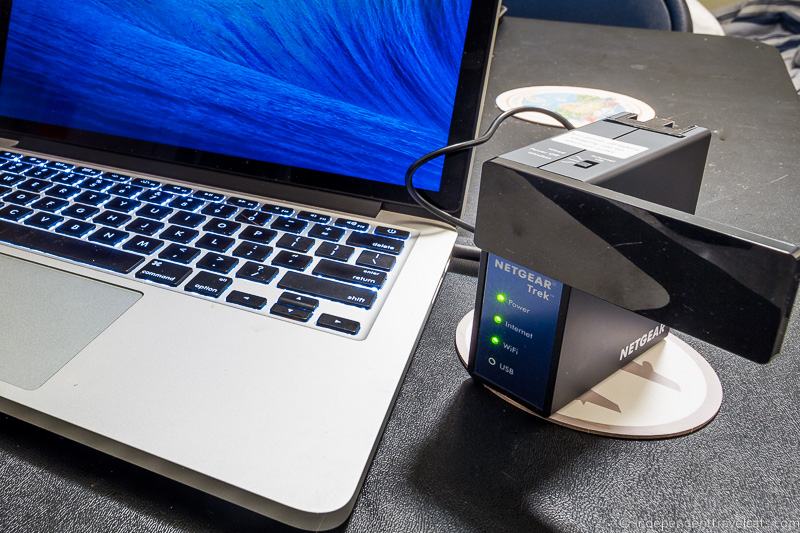
Table of Contents:
Basic Information on what a Travel Router Does
If you are new to travel routers, also known as portable WIFI routers, this section will help you understand what they do and whether they might be a good fit for your travels or not.
We understand that a lot of the terminology can be somewhat opaque, so Laurence has put his years of experience as a software engineer to use to help explain everything you need to know.
What is a Travel Router?
A travel router is a wireless range extender designed for people who are on the go and need to connect to the Internet when they are away from home. It also performs the functions of a wireless access point.
Just like you would use a home WiFi router to connect your devices to the Internet at home, you may also want to consider having a portable router to use when traveling.
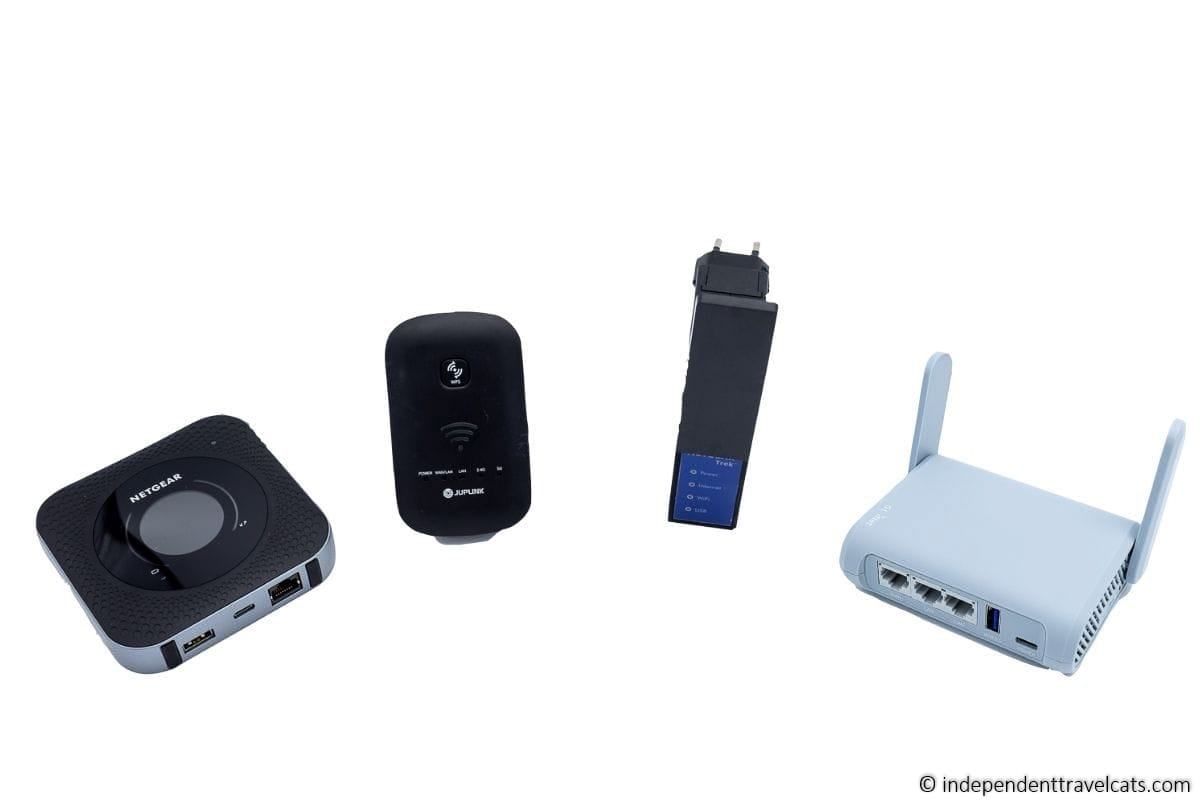
What does a Travel Router do?
Different wireless travel routers have different features, but the main feature is that they increase the range of existing wireless Internet networks. So for example, if you are in a hotel with a weak wireless signal that you are having difficulty connecting to with your laptop or phone, the travel router will amplify the signal so you can connect more easily.
Here is an overview of the main features of a travel router:
- A travel router can extend the range of wireless networks , meaning you can connect to a network somewhere that you might not have been able to connect to with your device because the signal is too weak. The powerful antenna of a travel router can pick up this weak signal and amplify it so your devices can connect to it.
- The travel router also creates a secure wireless network at a public hotspot to better protect your devices . Often when traveling the networks we connect to are unsecured and unencrypted, which means anyone could in theory grab hold of passwords or other data that we send to and from the internet. Travel routers feature a firewall which protects your personal devices from known DoS attacks and port scans from the Internet, giving you a more secure internet connection. However, it is still not recommended that you share sensitive information over a public connection.
- A travel router allows you to connect multiple devices to a network , even with a single login. The travel router is seen by networks as a single device, so if you are only given one login, you can still use multiple devices. You just login once from the travel router via a web browser (or in some cases a provided smartphone app), and then all your devices can be connected to the network created by the travel router.
- Some travel routers can also be used as a WiFi bridge . These have Ethernet ports so you can connect Ethernet-enabled devices wirelessly to an existing WiFi network. These can include Internet-ready TVs, Blu-ray players, and gaming consoles.
- Other features of travel routers may include the ability to connect to a wired network and turn that into a wireless network, to provide USB charging power to devices such as phones. to work without power, and even to act as an SD Card reader or media hub.
- Some travel routers (including one on our list) can also act as mobile hotspots, but this is not common. See our guide to mobile hotspots for more options in this area.
How much do travel routers cost?
Travel routers range in price from about $20 to $130, although more expensive models with more features are available. We’d recommend that most people look at ones in the $30 to $70 range, as these will work for most users.
If you have a small budget, you can get a decent travel router for around $30. See our recommended travel router list later in the article; they are listed in order by retail price. But beware of ones that are really cheap as they may not work well as advertised.
If you need a travel router that also acts as a mobile hotspot or has other specialized features, then you will pay extra. Some of these can be upwards of $200.

The Best Travel Routers 2024
There are a number of travel routers on the market today, which range in price and features. All the below models would make for a good choice, and the model you choose will depend on your budget and required features.
We currently use a GL.iNet GL-MT1300 which replaces our previous and now discontinued Netgear Trek N300 (PR2000).
We also use the Netgear Nighthawk M1 on some trips when we need access to the Internet as this functions primarily as a mobile hotspot, but it can also be used as a travel router.
Below are our current favorite recommendations:
1. GL.iNET GL-MT300N-V2 (Mango) Mini Travel Router
This is the first of a few GL.iNet routers that we recommend in this post. We like them for a number of reasons. First, they’re based on the OpenWRT software, which is a Linux based operating system that receives regular updates. GL.iNet keep on top of regular firmware updates, so the routers stay secure and get new features. This is unfortunately not as common as you might think, but it is super important to keep your devices safe.
As an example, the GL.iNet routers we list have all been upgraded to include support for WPA3, the latest wireless security standard. Regular updates and support for new features is definitely a benefit when it comes to a travel router, and means it will likely be more future proof.
Whilst this may all sound quite technical, the good news is that you don’t need to really worry about it if you’re not an advanced user. The devices have a simple interface and are easy to setup, and upgrades are just a single click option. If you want to dive into more advanced options you can, but the device works great out of the box, with setup via a simple web interface.
All the GL.iNet routers in our list also all support VPN credentials (see why you need a VPN for travel here ). This means that if you have a VPN account for more secure browsing like NordVPN , all your devices will connect through that when using this device.

The MT300N-V2 model, also known as Mango, is one of the more entry level options in terms of price and features, but if you’re looking for a small device that will do pretty much everything you are likely to need from a travel router, it’s a great option.
You get 300Mbps 2.4Ghz WiFi support, WPA2 and WPA3 support, and two 100 Mbps Ethernet ports for sharing a wired network. It’s also very privacy-focused. As well as the aforementioned VPN support, it also comes with built-in support for Cloudflare’s DNS over TLS. This basically means your internet connection is going to be pretty secure and hard for anyone to snoop on.
Another great feature is that if you have a smartphone with tethering support, or a 3G/4G data dongle, you can plug this smartphone into the USB 2 port on this router, and share the phone’s data over the router’s WiFi network.
The device is powered by USB, so any USB power source can power it, including a power bank or smartphone charger.
The reviews are positive and it’s available at a great price for a travel router that supports 300Mbps and only weighs 1.41oz. It is not as fully featured as some of the other options, in particular it only operates on the 2.4GHz band and the ethernet ports are 100Mbit rather than gigabit. However for most users this likely won’t make a significant difference.
If you are after a lightweight great value travel router with VPN support, this is a solid option.
Price: Check latest price on Amazon here
2. TP-Link TL-WR1502X Router
Released in 2024, the TP-Link TL-WR1502X wireless travel router offers impressive specifications in a small and relatively affordable package.

This weighs just 5.4oz, is powered by USB and supports up to the Wi-Fi 6 802.11ax standard. On the 2.4GHz channel you get up to 300Mbps, whilst the 5Ghz channel offers speeds up to 1200 Mbps.
These network speeds are more than enough for your travel needs as most networks you connect to when traveling are going to be slower than this.
It also has a USB port that you can connect a smartphone too for tethering purposes. So you can share the internet connection from your smartphone across the network your travel router creates. However this USB port can’t be used to connect a hard drive for file sharing.
There’s also a 1000Mbps ethernet port. It doesn’t have a built-in battery, so it does need to be powered from either a USB battery pack or a wall adaptor.
You also get VPN support, so if you have a subscription to a supported VPN service then you can put the details into the router and it will route all traffic through the VPN.
We think this travel router is an excellent option, as you get more future proof WiFi 6 support and gigabit LAN, as well as VPN credential support, in a well-priced package. It doesn’t have all the features of pricier models, but it’s certainly a compelling option.
Note, TP-Link also makes an older travel router, the TL-WR902AC Router . We wouldn’t recommend that one as it’s now quite an old model, but it is certainly a low cost option.
Price: Check the latest price on Amazon here
3. NewQ Filehub AC 750
If you’re after a travel router with a few more features and great functionality, then the NeqQ Filehub AC750 is a good choice. It may also allow you to replace some of the other devices you typically travel with to pack less.

As well as offering a fast 433Mbps network with support for both 2.4GHz and 5GHz networks, this device features a 6700mah battery so it works without needing power, and can also be used to charge your devices.
It also features an SD Card reader and a USB port, so you can transfer files from memory cards to your hard drives or computer. It also has DLNA compatible media serving capabilities, although it is missing built in VPN support.
The latter means you can plug in a hard drive or memory card with your movies on, and stream them directly to your TV, laptop, or mobile phone. There’s a lot of functionality for the price and it weighs under 7 ounces!
Price: Check the latest price on Amazon here .
4. GL.iNet GL-A1300 (Slate Plus) Travel Router
The GL-A1300 from Gl.iNet is the latest version of the travel router we currently use. The GL-A1300 supports 400Mbps on the 2.4Ghz channel, and up to 867Mbps on the 5Ghz channel. It also supports up to 40 devices simultaneously, thanks to a relatively fast processor and lots of RAM.
Like the other GL.iNet routers it also gets regular updates and includes support for features like IPv6 and WPA3, as well as lots of other advanced features that make this perfect for both travel and at home use.

Now, to be honest, most WiFi networks you connect to aren’t going to offer internet speeds which this router can take advantage of. However, if you happen to connect to one that is that fast, this device will let you take full advantage of it! It also means when you’re not travelling you can use it at home as a fast network option to extend an existing network.
You also get three gigabit ethernet ports, a faster USB 3.0 port with media server capabilities, a micro SD slot for storage, and a USB-C port for power. As with the other GL.iNet devices in this list, If you have a smartphone that supports tethering, you can plug it into the USB port and share your smartphone data as well. Or, if you have a USB 3G/4G modem, you can plug that into the USB slot and share that data.
This router is also specifically designed to provide good support for a wide range of VPN services as well as support for IPv6, making this one of the most future proof travel routers we’re aware of on the market. It weighs 6.3oz, so it’s not the smallest option, but it’s still very compact and offers a lot of functionality for the price.
5. GL.iNet GL-MT3000 (Beryl AX)
Launched in December 2022, at the time of its launch this travel router took the speed crown from our previous fastest travel router, the GL.iNet GL-MT1300 (Beryl) . As the name suggests, it is an upgrade over the 1300 Beryl model.

If you want one of the fastest and most future proof travel routers on the market, this is the model to go for. With WiFi 6 support, you can get speeds of up to 574Mbps on the 2.4GHz channel and a blazing fast 2402Mbps on the 5Ghz channel.
It also has an incredibly fast dual-core CPU and double the RAM of the previous Beryl model, meaning it can support up to 70 connected devices simultaneously.
You also get a USB 3 port for tethering support and 2 LAN ports. One of those LAN ports offers gigabit speeds whilst the other is 2.5 gigabits, which is about as fast as you can get, and ideal if you also want to use this at home with a fibre connection.
It otherwise has the same features as the other GL.iNet products, so you get regular updates and support for VPN connectivity if you have a VPN account. If you do have a VPN, this router offers WireGuard speeds of up to 300Mbps, which is incredibly fast compared to other travel routers on the market.
To be honest, this router is probably a bit much for most general travel needs. However, If you have a lot of devices to connect, or just want the fastest option with all the features, and support for USB 3, this is the one to go for. At 7oz, it’s not the lightest option out there but you do get incredible performance.
Price : Check latest price on Amazon here .
6. Asus RT-AX57 Go
Launched in early 2024, the Asus RT-AX57 Go is another high end travel router offering very fast WiFi 6 speeds, up to 574Mbps on the 2.4GHz band and up to 2402Mbps on the 5Ghz channel. That puts it on par with the GT-3000.

In terms of features, this travel router is packed. You get USB-C charging, a USB 3 port which supports tethering as well as file sharing from a portable drive, and 2 gigabit ethernet ports.
It also supports inputing your VPN credentials so you can secure your whole network, rather than having to run VPN software on each client device seperately.
It comes with a fast CPU and plenty of RAM so you will be able to connect multiple devices with no problem. It’s not the smallest device out there, weighing in at 7.1oz (200g), but it’s still compact enough for travel.
In our opinion, this travel router makes the most sense for those of you who already have a home network WiFi router made by Asus. That’s because this little travel router has the same AiMesh features as its larger siblings, meaning you can use it when not traveling to extend and improve your home WiFi easily.
7. Netgear Nighthawk Range
If you are looking for a product that is both a mobile hotspot and a travel router, the Netgear Nighthawk range of devices, including the Netgear Nighthawk M1 (MR1100) which we discuss below, are an option to consider.
These are specifically for people who know they are going to be traveling in places without WiFi internet access.

As well as offering travel router capabilities like extending an ethernet or wireless network, the Netgear Nighthawk M1 also lets you put a 4G LTE SIM card into it, and use it as a mobile hotspot when you are away from wireless or ethernet.
It has a 5040mAH built in battery which you can use to charge your phone, media streaming support, can connect up to 20 devices, and supports both 2.4GHz and 5GHz 802.11ac wireless networks.
Note that this can work on multiple bands around the world, but it doesn’t support all bands around the world. Check to make sure it will work where you need it to work before purchasing. The device should come unlocked and be able to work with any compatible SIM card.
This is definitely a more premium product, but may be a good option for more frequent travelers, those who work remotely, and those who need to get online in more remote locations like RVs or rural settings. For more convenient travel, there are cases you can purchase for it to keep the router and cords, such as this one .
If you are looking for an even faster mobile hotspot that also doubles as a travel router, then you might consider the newer versions which support 5G, including the Netgear Nighthawk M5 (MR5200) and the Nighthawk M6 (MR6150 & MR6500).
These offer 5G compatibility, a touchscreen interface, and can support up to 32 devices. They are significantly more expensive than the M1, but worth considering if you have a larger budget and want a more future-proof router that supports 5G. The M6 series additionally supports WiFi 6.
Note that there is also a M2 version of the router available in certain markets like the United Kingdom and Europe. This one also offers more features like a touchscreen interface but it doesn’t include 5G support.
Price: Check latest price here
You can see and compare most of the travel routers above in one place on Amazon here .
What We Like about Travel Routers
Our primary use for our travel router has been to extend existing Wi-Fi connections. We have often encountered the situation when we are happy to learn that a wireless Internet connection exists in a hotel, bus, cafe, or airport but are then disappointed that the connection is too weak to connect to or is very slow.
Our travel router can then be pulled out to help strengthen the signal so that we can get online using our phone, tablet, and/or laptops. Although not always possible, it is also great in those situations where you can extend a Wi-Fi range from a hotel lobby to your room or from an indoor space to a patio.
The device also partially helps with the security issue of using public Wi-Fi hotspots by providing a firewall and some protection from common Internet threats; however, you should still be cautious about providing sensitive personal information over a public connection.
Travel Routers are also great in other traveling situations beyond just extending an existing wireless connection. There are situations where you might only be given a password to connect one device at a time on a wireless network or may have to pay for additional devices. Obviously, since we are traveling as a couple with two cell phones, two laptops, and two Wi-Fi enabled cameras between us, one Internet connection is not enough and we hate to pay for Internet!
So by whipping out this device, it will allow you to connect multiple devices to a wireless network using a single login. You just login once from the travel router via a web browser or the provided smartphone app, and then all your devices can be connected to the travel routers network, where they should all work simultaneously.
Also, if you are in a hotel or other location that only offers wired Internet access in your room, you can plug the Ethernet cable into the travel router and create a wireless connection that can be used for all of your WiFi-enabled devices.
Interestingly we have ended up using our travel router as much, if not more, at our apartment verses while traveling. When we lived in California, we had a good wireless Internet connection in our apartment but it became weaker when trying to use a laptop or phone outside on the deck.
We’ve set up the travel router to extend the range of our home wireless network to be able to blog more efficiently on the deck which was one of my favorite spots to blog . We have also used the USB ports on our router to charge cell phones and other devices and to plug in our USB hard drive for use as a network attached storage device to be shared on our home network.
We also like that most of these travel routers are powered through a micro-USB port, so you can actually power them from a laptop or USB power bank if you don’t have easy access to a power point.
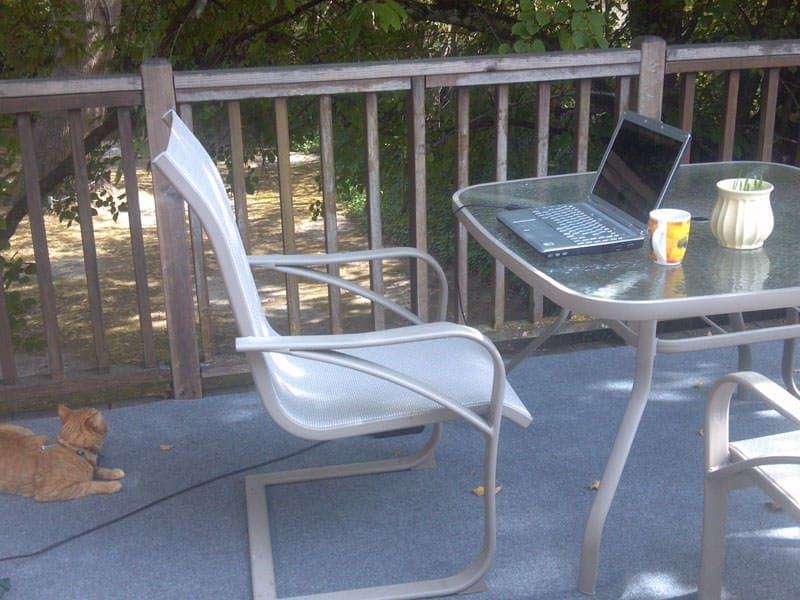
Limitations of Travel Routers
Most travel routers are not a mobile hotspot, so they cannot create an Internet connection if one does not already exist.
So if you are wanting to actually use the Internet in place where there is no or very poor WiFi internet, you’ll probably want to consider something like a mobile hotspot rather than a router or range extender product. However, some travel routers allow you to connect your smartphone via USB and share your mobile data over WiFi, which is a good option.
The Netgear Nighthawk M1 is a combo router and mobile hotspot, and so this could be an option as well if you need a hotspot.
For those wondering how to get online or how to find an Internet connection while traveling, see our travel guide to getting online when traveling . It also covers things like mobile hotspots, SIM cards, international data plans, VPNs, etc.
Sometimes despite the power of a travel router’s antenna, the signal will still be too weak to connect. In a few situations we have spent too much time trying to get a connection to work when the signal is simply just too weak. Some routers can also take a few minutes to connect to a network which can leave you wondering if it is just taking awhile or if it isn’t working.
Be sure to check before you buy to make sure the travel router is compatible with your devices! This should not be an issue for most newer devices but some may not work as well with older devices or those using older operating systems.
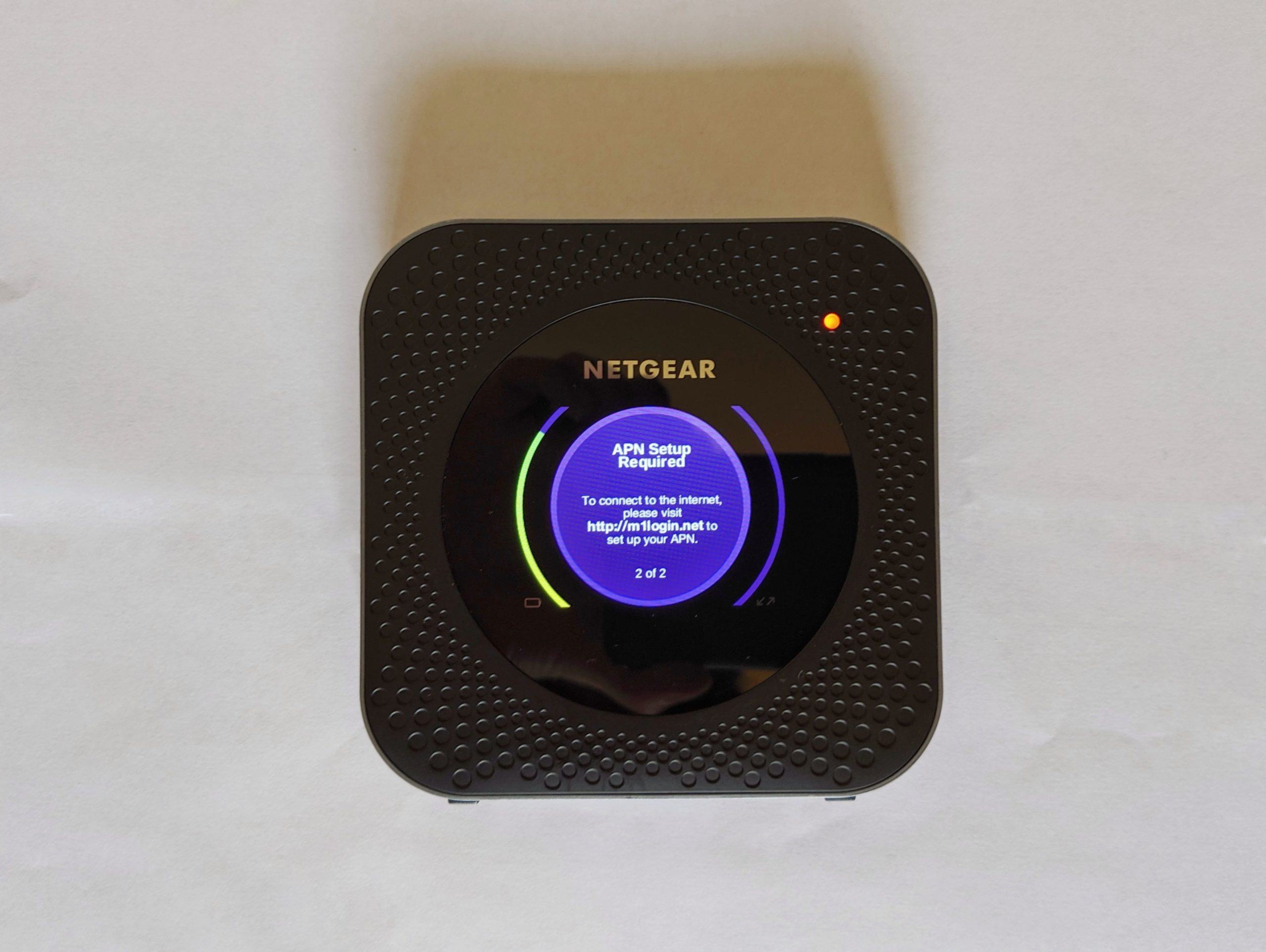
Do you Need a Travel Router?
Overall, we have found travel routers to be a benefit to our travels. They are generally easy to use once configured, and are compact and easy to travel with.
Given that many hotels only allow you to join a network using one device at a time (or charge extra for multiple devices), having a travel router makes it possible for us to use all our WiFi enabled devices at once without extra fees.
We currently use ours both at home to extend the range of our own home Internet and while traveling to extend wireless Internet connections, to login multiple devices using one password, and to add a little security while using public WiFi hotspots.

What issues do you have related to using the Internet while traveling? Have you used or would you consider using a travel router? As always, we’d love to hear any advice, tips, or questions you may have!
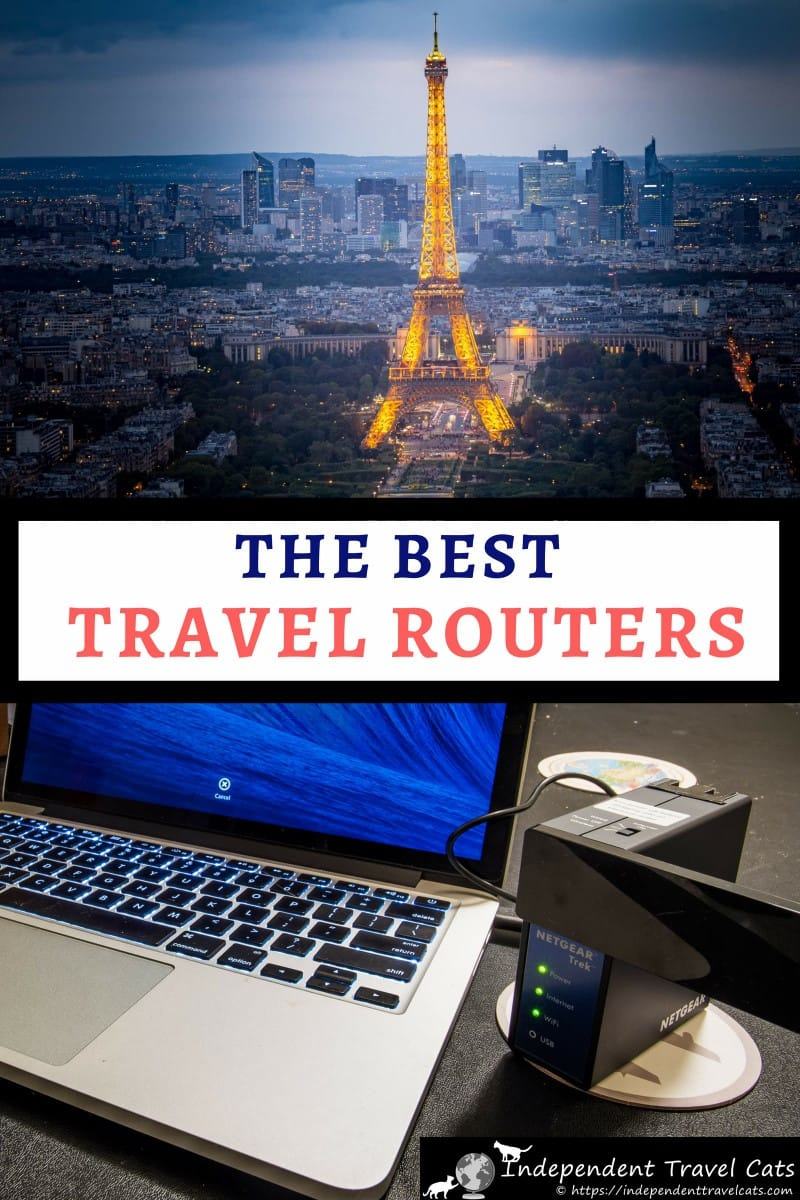
Share this Post!
There are 229 comments on this post.
Please scroll to the end to leave a comment
Andrew Scott Post author
April 13, 2024 at 6:37 am
I’m so overloaded with reviews and information that I decided I’m going to get something you use or recommend. Best review is one where someone recommends something they actually use. Now, you use the GL.iNet GL-MT1300 but Amazon says it’s no longer available. I think it said “try this instead” but I’m wondering if you’d recommend its apparent replace, whose model I can’t remember, or if you’d switch up/to one of the others you recommend/reviewed. Thanks in advance.
Jessica & Laurence Norah Post author
April 14, 2024 at 1:44 am
Yes, it looks like our Beryl router (MT1300) is showing as unavailable, so it looks like it is either out of stock or has been recently discontinued. GL.iNet has been updating and making new routers pretty regularly over the past several years. So based on that one, we would recommned the GL.iNet GL-A1300 (Slate Plus) router . It’s offers pretty much the same feature set as the MT1300, but with improved VPN support. It’s also at roughly the same price point as the one we bought.
If you want support for more recent network technology, then the MT3000 (Beryl AX) would be the option to go for. The Beryl AX (MT3000) is the same model as we have with more advanced technology but at a higher price point. For most travel needs though, the A1300 should work fine.
Either of the above models should work fine for you. We have had good luck with our GL.iNet travel routers and they offer free customer support as well as free returns on Amazon. I would say they are the most reliable brand out on the market right now for regular travel routers. You can, of course, also ask us any questions you may have about routers and we are happy to try to help.
Hope this helps and wishing you happy travels!
Best, Jessica
April 28, 2024 at 7:15 am
Thank you for the full and helpful reply!! Had missed your reply before now.
Regarding “This post may contain affiliate links. If you make a purchase using one of these links it means we may earn a small commission at no extra cost to you.” can you clarify if it’s any links you include in your webpages (e.g. the links in your blog text and those in comment replies)? I’m ready to purchase a router based on your blog and comment replies and I’d like you to profit from the help and guidance you provide so I want to follow the correct Amazon link. 🙂
Laurence Post author
May 2, 2024 at 4:56 am
You’re very welcome!
Most of our Amazon links included in our post are affiliate links. So if you click on one of those links and purchase the same day, then we get a small commission from that purchase as members of their affiliate program. I definitely appreciate you wanting to help support us!
Hope you enjoy your new travel router!
March 24, 2024 at 1:16 pm
This is a follow-up to my first comment but unable to reply to unapproved comments hence this one.
Just realised that since they are invariably powered via USB, rather than buying one with a built-in battery, you could just use a power bank to power them. The trick would be knowing what size of power bank you’d need for a given travel router.
March 25, 2024 at 4:25 am
Yes, Internet on cruises can be challenging. I think it will depend on the Wifi signal (if it is only available in the cruise cabins) if it will reach to other public areas or not.
The majority of the travel routers we recommend accept a USB input for power so many can be charged/powered by battery. The main thing is to check that the battery bank puts out an output that matches the input of the travel router. Most travel routers accept a 5V 2amp, 3amp or 4amp input, which should work with most battery banks. However, some higher powered routers require a higher voltage, so just check the specifications to be sure.
In terms of size, a 15,000 to 25,000 mah battery bank such as this one by INIU should provide many hours of operation.
Hope that helps and hope you have a wonderful cruise!
Best, Jessica & Laurence
May 5, 2024 at 8:50 am
Ended up purchasing the recommended one by INIU. Thought I’d come back to leave the comment that the GL.iNet Beryl AX router, which I also purchased, required 5V 3A power input. Looking at routers reviewed by Which? magazine, who also recommended the INIU router, it was the only that could provide the necessary power. “All” others were 2A and I didn’t want to risk wasting my time (sending it back) with an underpowered one. Anyway, sitting here quite happily connected to router powered by the powerbank. 😊
May 7, 2024 at 8:58 am
Great to hear your found a solution and that our advice was helpful. Just to clarify, I assume you mean that you got the GL.iNet Beryl AX travel router and a INJU powerbank (not a router from INIU?)? Glad to hear that the recommended INUI powerbank put out the correct amperage for the Gl.Inet travel router.
Yes, we have INIU powerbanks ourselves and have purchased them as gifts for friends so definitely recommend them!
May 7, 2024 at 11:17 am
Yes, gl.inet router and iniu powerbank.
March 24, 2024 at 1:06 pm
We’re looking at one for use on cruises since we learned we can’t hot-spot the WiFi each of phones will have access to. Thought we’d only be able to use it in our room until I read about the one that is battery powered. That would allow us to use it beside the pool or in some other public area. THAT would be extroflexible.
March 25, 2024 at 4:16 am
See our response to both of your comments above to your second comment.
Kelly Post author
December 28, 2023 at 9:24 am
Hi – we sure appreciate the great info!
I was hoping to learn if you thought a travel router would be a good choice to replace our router in Mexico so that we are able to access US streaming through our VPN? It would become our new permanent router there. And/or would we able to use 2 routers with the same VPN, one for other travel and one for our Mexico residence?
December 28, 2023 at 1:54 pm
Happy to try to help with your travel router and VPN questions. So it sounds like a permanent router would be best for your Mexico home and most home routers by GLiNet, Netgear, and many other brands will support a VPN. So for example, this one by GL.iNet should work find as a home router with a VPN service. A home router is going to be larger (so not ideal for travel) but is going to generally perform better overall than a small travel router and have more features, so best to stick to that for home use.
It sounds like you also want a more portable travel router for when you travel internationally to other locations outside of Mexico and the USA? And in that case, most of the midrange and above travel routers support VPN services. You just want to avoid the really cheap ones. Any of the GLiNet travel router options we recommend above such as the Slate or Beryl models should work fine with most VPN services and they are really good travel routers as well. Just see our recommended list above.
And yes, you should be able to use the same VPN service across your home and travel routers. If you stick to the same brand across your routers, it might be a bit easier with configuration but it probably doesn’t make too much difference.
It sounds like you probably already have a VPN service for traveling, but if not, Laurence made a guide and a list of VPNs for traveling here that might be useful.
Hope that helps but just let us know if you have any further questions!
December 28, 2023 at 4:49 pm
Big thanks, Jessica – all VERY helpful information to make my learning curve more bearable.
I will look further into supporting your sites.
Much appreciation,
December 29, 2023 at 6:32 pm
You’re very welcome, and just let us know if you have further questions as you do any further research on routers and VPNs!
Patricia Post author
September 18, 2023 at 9:00 am
Do I need any cabling to use these travel routers with an iPad Pro. Looking at the photos they seem to have Lan connectors and usb sockets , but at the moment at least iPads don’t have either of these. Please advise. I need the router to connect to Wi-Fi when the signal is weak but I would also like it to be as secure as possible thank you. Great reviews
September 18, 2023 at 9:55 pm
Hi Patricia,
No, you don’t need any cables to be able to use any of the recommended travel routers with your iPad Pro, they all can be used with WiFi with your devices. However, most also allow for LAN Ethernet connectivity if you need a wired connection and many also have USB ports. But most people just use their devices over WiFi so you would be fine with any travel router if you are just needing to mainly connect your devices for security, easier connectivity, and extending existing WiFi.
Bob Simmons Post author
July 2, 2023 at 10:05 am
Thanks for the great article. My issue is with WiFi that requires payment after entering password. Also each device requires payment. On a cell phone, after logging in, it pops up a window (browser?) where you enter the credit card info. Do any of these travel routers have that capability, to enter payment information? Reading the user manuals it appears the answer is no. In your travels maybe you have encountered this issue.
July 4, 2023 at 9:34 am
It’s our pleasure, and we will do our best to try to help you.
So the window that pops up to take payment is called a captive portal, and it’s the same thing you often encounter even with free Wifi where it might ask you to enter your name or e-mail address to access the internet. All the travel routers on our list support this, so you can log in and pay if necessary for internet access. A window will pop up on the first device you connect with where you can pay. A pop-up blocker or ad blocker might stop it from happening but in our experience a browser window normally just appears to log in with.
Let us know if you have any more questions!
Laurence & Jessica
Luke Post author
May 25, 2023 at 5:08 am
Just want to say thanks for the sharing informative article, very helpful in choosing the best travel router for our next trip!
June 2, 2023 at 4:39 am
You’re very welcome and glad to hear you found the best travel router for your upcoming travels! And thanks for taking the time to comment.
B.Balakrishnan Post author
May 19, 2023 at 4:04 am
This blog post on the best travel routers for the internet while traveling in 2023 is a lifesaver! Staying connected on the go is crucial, and these router recommendations are just what I needed. Thank you for the helpful insights!
May 21, 2023 at 9:50 am
Hi there, So glad you found our travel router review helpful. Just let us know if you have any questions!
Arnold Machel Post author
April 23, 2023 at 9:08 am
Thanks for the great article. I’ve used a travel router for years and found them super helpful, especially in situations where I want to use a portable Chromecast, but the hotel WiFi security settings won’t it allow to connect directly to the hotel WiFi.
I am now using a laptop that needs a high wattage charger (ideally 65 watts) and would love to finde a travel router with that kind of charging capability, but I can’t seem to find the technical stats on most of them. Any thoughts?
April 24, 2023 at 1:28 am
Glad to hear you have found a travel router useful on your travels. So it sounds like you are looking for a travel router that doubles up as a powerbank that you can use to charge your laptop? Unfortunately, we aren’t aware of any travel routers on the market which offer that level of output, most travel routers which have the facility to charge devices have fairly small batteries and don’t offer high wattage outputs. The ones that offer the ability to charge a device, are more designed to top up a smartphone rather than to power a laptop.
So if you want a portable device to help charge your laptop on the go, I would look at powerbanks like this one that are speciically designed to charge laptops.
Hope that helps! Jessica
April 24, 2023 at 6:34 am
Thanks Jessica. Too bad. Was just hoping to get one device to do both. Good luck with the blog.
April 26, 2023 at 2:19 am
You’re very welcome. Yes, unfortunately I don’t think there is a device that would be able to do both those things well. Feel free to come back and let us know what travel router and charging device you decide to use on your next trip as it may be helpul to furture readers wanting to do the same thing.
Sherry Duvall Post author
March 6, 2023 at 6:46 am
Thanks for this great article! I have just discovered travel routers and am intrigued as to whether this would be something that would work for my family. I would like to know if any of these would work on a cruise ship? We have to pay for each device, or log off and login on them which is such a pain. Cruise ships are huge so will it work when you are far away from your room, and if so, which one would you recommend? Thank you for any help!
March 6, 2023 at 8:44 am
Our pleasure! So to the first part of your question, yes, this should work to allow you to use multiple devices with a single login. The travel router will appear as one device to the cruise ship network, and then you would be able to connect your devices to the travel router’s network without needing to keep logging in and out.
For the second part of the question, travel routers have a variable range but it won’t cover a whole cruise ship unfortunately. It would work in your room and then nearby, but all the walls etc would reduce the range. So it wouldn’t cover the whole ship sadly. But any of the travel routers on the list work in a very similar way in terms of login and would cover your room.
Hope this helps!
March 6, 2023 at 9:41 am
Thank you very much…guess I will save my money!
QBM Post author
March 1, 2023 at 9:21 pm
This article from Independent Travel Cats’ blog is a comparison and review of the top portable WiFi routers for travellers. This post does a good job of researching and comparing the features, benefits, and cons of each router. Personal anecdotes and experiences from the bloggers’ travels are also included in the article. In sum, if you are a frequent traveller in need of a dependable and transportable router, you will find this article to be a gold mine of information.
March 2, 2023 at 4:14 am
Thanks so much for the very kind summary and recommendation of our travel router review article!! If you have any questions about portable routers, feel free to ask!
Daniel W Post author
February 24, 2023 at 8:33 pm
I appreciate what you did with this blog post, especially the way you keep it updated. It is the best online resource for people looking for information on travel routers, thanks!
February 27, 2023 at 7:12 am
Thanks for the kind words and glad you found our travel routers review article useful! If you have any questions about choosing the best travel router for you, just let us know. Happy to try to help!
Karen Arnauld-Bakelaar Post author
January 20, 2023 at 10:21 pm
This i8s so incredibly useful – thank you! Can you help me sort out which might be the best option for me? I mainly work in South Africa, which means we have long spells without power, so anything that runs on battery would be nice to have. I’m in a rural area, so even while working from home I often have trouble getting a wifi signal, especially in bad weather.
I need the signal to be strong enough for Zoom meetings, etc – and often it’s not.
I also need a portable option for when I travel, but I don’t know if I need something to boost a signal or to hotspot – can you help me with this?
All internet here is wifi – I have a home plug-in router with a SIM card in it, and a small portable router as well, but they don’t always do the job!
January 23, 2023 at 7:22 am
It’s our pleasure. So it sounds like you need a mobile hotspot rather than a travel router. A travel router can only extend an existing WiFi signal.
A mobile hotspot works over cellular networks (like a mobile phone). However this can be affected by bad weather, so would basically be the same situation as you are in as your plug-in router likely works the same way. The only difference is that a mobile hotspot has a built-in battery.
So in bad weather situations, there may not be anything more you can do as strong weather can affect the overall signal which could affect the signal for any kind of devices using WiFi or mobile signals. But you might try a hotspot to see if that helps as it works with a different type of signal (cellular signal versus WiFi).
Monte Post author
December 23, 2022 at 3:10 pm
Is there a travel router best suited for offline multiplayer gaming? My wife and I often wind up in areas with no internet. A normal home router constantly nags us with the “you aren’t connected” screen. We know! That’s why we’re playing Minecraft!
December 24, 2022 at 6:48 am
Happy to try to help. So I am guessing the home routers you are referring to are ones that are not your own but ones you stay in while traveling?
So none of the travel router models we recommend are specifically designed for offline gaming. However, we think any of the Gl.iNet routers on the list would work in this scenario, allowing you to create a local WiFi network that your devices can connect to without needing to connect to another WiFi network. However, we have not tried this specific scenario so it is hard to say if one or another router on this list would be better suited to the task. But the more advanced ones offer more features and more future proofing.
Another option to try might be to see if one of your computers (or smartphones if playing on them) allows you to set up a WiFi hotspot. Some Windows 10 and Windows 11 laptops for example have the option to allow you to set up a local WiFi network, which you could then connect your other device too. This may be another possible solutation you could check out.
Anyway, hope that helps and we’d love to know what solution you come up with that solves your issue as it may be useful to future readers.
Virag Post author
November 28, 2022 at 8:22 am
Hi, Thank you for this amazing article. I travel quite a lot and work at the same time and I would need something that I can use to boost the available public wifi (like in hotels or coffee shops). Which one would you recommend in this case?
Thank you in advance, Virag
November 28, 2022 at 9:38 am
Glad you found our travel routers guide useful. So any of the routers listed in our guide would work for that purpose but the GL.iNet routers with the antennas, such as the Slate, Beryl, or the Slate AX models, would have the best performance. We personally use the Beryl model . So I’d recommend any of those three models or a similar travel router to those.
I believe Amazon has been offering discounts on most of the routers for the past week so I would definitely compare prices as you can sometimes get one of the newer models for a good price when they are running discounts.
Hope that helps, and just let us know if you have further questions.
Steve Brown Post author
October 31, 2022 at 11:45 pm
Thank you for sharing the list. I really needed one. I have dead wifi zones with which the travel routers could help.
November 1, 2022 at 9:19 am
It’s our pleasure, glad you found our list useful. So whilst a travel router can work to resolve dead zones, you might prefer to purchase a WiFi extender instead, especially if you plan to use this at home. They tend to be a little bit cheaper because they don’t need as much functionality.
Another option to solve dead zones would be to upgrade to a mesh WiFi network – see our guide to the best home WiFi routers for ideas in that area. The mesh system can help make it so that the WiFi is able to extend throughout your home.
Hope that helps and just let us know if you have any questions!
AJ Post author
October 21, 2022 at 5:01 pm
I purchased two of these items ( #1 and #3) but since I am not tech savvy at all, they were impossible to use. I tried reading and rereading the instructions. I tried the company websites. I tried many youtube videos. I sat between Carls Jr and Walmart, who both have free wifi. I was able to scan each one with a success response. BUT NO WIFI.
This sucks. When someone in an actual store can hook me up and show me how to use it, and provide an actual phone number I can call when I am on the road (which I always am), then I’ll buy one. But reading reviews and going to amazon, and returning said items to amazon, is not my cup of tea.
October 21, 2022 at 5:09 pm
Sorry to hear that you are having issues with using your travel router while traveling. So most travel routers require a little bit of setup.
Have you tried using them inside where you know the WiFi was a good strength and working properly? If you were sitting outside the stores, the public signal might not have been strong enough for instance to really work.
If you have already gotten the manufacturer’s instructions (GL.iNet has some really detailed ones online you can get), you can also try contacting their customer support. If you want in-person support, you could also try going to a local tech store near you (or a chain like Best Buy) that sells travel routers and might be able to troubleshoot with you and help you.
Hope you are able to get it to work!
David Post author
October 1, 2022 at 10:31 pm
For travelers who need access to the internet while traveling, this device sounds very useful. In our everyday life we cannot think of going a day without internet. Thanks for sharing for your valueable information.
October 3, 2022 at 6:55 am
Yes, travel routers can be very useful for those who need to be connected while traveling. If you have any questions about travel routers, just ask!
Chris Post author
September 7, 2022 at 1:54 am
I’m having trouble backup my extender settings, it takes saying that backup is done but can’t find the file??!!
September 7, 2022 at 5:08 am
Many travel routers do allow you to back up their settings, and save the settings to a file. But you will want to check the manual for your specific travel router model to see if it has that functionality and how to do that.
When you backup something as you did, it should give you the option to choose the file location when you do so. So if you check your browser downloads folder it should be there where you set it to save. Or check your manual for the default location.
Hope that helps, Jessica
Jason Post author
August 1, 2022 at 7:32 pm
Hello. Thanks for all the great info. I have been researching travel router setup, but am not sure if it’s possible to do what I’m attempting. I hope you can help me out.
I have an “older” ASUS Dual-Band router that was replaced when we upgraded our home to Eero Mesh router. What I’d like to do is set up the old ASUS router with the same SSID & password as my current home router (the Eero), so that I can take the ASUS on family vacations, connect it to the hotel/condo/house/etc. WiFi, and then all of our devices will automatically connect to it (since they have the same SSID/pswd already saved from our Eero router), without having to sign in all of our devices to the hotel/condo/house/etc. WiFi.
I’ve found some articles that explain how to set up 2 routers with the same SSID & pswd, but they all require connecting the router to a laptop for the initial setup/configuration. So, the real question/problem is: I don’t want to take my laptop on vacation, just to connect my old ASUS router to the vacation home’s WiFi. So, is it possible to set up my old ASUS router at home, and then plug it directly into the vacation hotel/condo/home router via ethernet cable, or will I need to bring my laptop to open a web browser and complete the setup?
August 2, 2022 at 12:10 am
It’s hard to really give specifics without knowing the type of router and equipment. But if the main step that is required is to connect to the Asus router via a web browser over the WiFi connection, then you shouldn’t need a laptop specifically to do that as you can just use the web browser on your smartphone to achieve the same thing. So that part of it should work.
I would definitely test this setup at home first to see if you can extend your existing network with your old Asus router to see if it works as you intend. If you can’t get it to work at home, I would not recommend taking it on vacation. If you can’t get it to work, I would just recommend getting a new travel router that will do what you need it to do for your trip.
Best, Laurence
David Paker Post author
July 4, 2022 at 1:34 pm
Wow! You guys are doing an amazing job. Following your tutorials, I learned so much !!
July 5, 2022 at 2:38 am
So glad you found our articles helpful. If you have any questions about travel routers, just ask!
May 12, 2022 at 10:42 pm
Thanks for the review. I’ll definitely look into it. It really is frustrating if the signal is slow. . I’ll be willing to carry extra weight if it would boost connection,.
May 13, 2022 at 2:07 am
Yes, a travel router may definitely be able to help with that. It does require packing something extra but travel routers are designed for travel and many of the models are pretty small and lightweight these days so won’t add a lot of extra weight! But I would recommend keeping the dimensions and weights of each model in mind when choosing the best travel router for you.
Ryan J Post author
May 11, 2022 at 6:19 am
Thank you for such a thorough and informative writeup! I also read your Best Mobile Hotpots review and was inspired to purchase the Nighthawk M1100, especially considering it’s added ability to be a travel router and boost a current wifi signal. Will be travelling to Europe and staying at many AirBnb’s. Just in case any of them have a weak wifi signal, I’ll be prepared! Now that I have the device, I can’t seem to find instructions on how to use it as a travel router specifically. I’ve searched everywhere online, and there seems to be different wording out there “turn the m1100 into a modem, use it with a modem, etc. Saw one video on how to use the nighthawk with another router (boosting that router’s signal), but it requires connecting an ethernet cable from the router to the Nighthawk. Is that the process of using it as a travel router? Ideally, I’d like to be able to avoid using the ethernet cable, especially if on a public network (i.e. train) that I need to connect to but is weak. Or staying somwhere that I don’t have access to the broadcasting router. Any specific instructions on using the Nighthawk M1100 as a travel router without using an ethernet cable? Thanks in advance.
May 11, 2022 at 9:28 am
So yes, the Nighthawk M1100 is mainly used as a mobile hotspot, but it can also be used as a travel router. So it is definitely possible to set up the MR1100 as a travel router to share a WiFi network, but the manual is not super helpful. We remember this ourselves when we set it up.
The section you are looking for calls it called WiFi data offloading. If you load the MR1100 manual on this page ( https://www.downloads.netgear.com/files/GDC/MR1100/MR1100_UM_EN.pdf ) – you are looking for the instructions on page 30, titled “offload your mobile internet connection”. There are sections here on setting this up for either Wifi offloading or ethernet offloading. You are looking for the instructions on Wifi offloading.
Hope that helps, but just let us know if you have any further questions. We have used both the Nighthawk M1 and M2 and have set them up to work as a travel router ourselves so happy to help!
May 12, 2022 at 6:34 pm
Amazing. Would have never found that out on my own. Thank you! Will let you know how it goes. My wife and I are being “digital nomads” for the first time having worked remote in the States for the past 20 years. Will be travelling to Spain, Portugal, France, Italy, Croatia, Switzerland, Germany, UK, and Ireland over the course of 5 1/2 months. Leaving next week and super excited!
May 13, 2022 at 2:06 am
Glad that helped and you should be able to test it out before you leave. Having the ability to use it both as both a travel router and a mobile hotspot (when you don’t have WiFi) is nice for a long trip like that.
Enjoy your time working as digital nomads in Europe!
Paul Post author
April 30, 2022 at 2:16 pm
Hi, we’re staying at a place that requires us to re-log in every 24 hours. Are there travel routers that will automatically take care of that for you?
May 1, 2022 at 5:33 am
So we aren’t aware of any travel routers that would be able to automatically do this out of the box. With a travel router there is the advantage that you only have to do this once, rather than once for each device you connect to the travel router. So you should be able to just do the necessary daily login once and then all the devices connected to your router should not have to do the log-in.
Depending on how technically minded you are, it is worth pointing out that the GL.iNet routers are based on the OpenWRT software, which allows technically-savvy users to install extra packages if they want and run custom code. However, this is beyond the scope of most users (and not necessary or recommended in most cases). However, if that does describe you though, then that’s an option as you may be able to write code (or find code written by someone else) that would be able to do the auto log-in each day.
Pasu Post author
April 28, 2022 at 9:24 pm
“A travel router allows you to connect multiple devices to a network, even with a single login. The travel router is seen by networks as a single device, so if you are only given one login, you can still use multiple devices. You just login once from the travel router via a web browser (or in some cases a provided smartphone app), and then all your devices can be connected to the network created by the travel router.”.
That’s exactly what I need. Connecting to a WiFi and giving the signal to other devices.
But sorry, which if the mentioned models can do this?
Thank you for your help
April 29, 2022 at 3:51 am
All of the travel routers we mention in our article can do this as this is one of the main features of most travel routers. The one we are personally currently using is the GL.iNet Beryl model above, but as noted, any of the above models can do this.
For instance, we often use it with the WiFi in a hotel to connect all our devices at once without having to log in each one. It can also help get around device limits imposed by some hotels as you just need to connect the travel router.
Travel routers can also make your connection more private and secure, and you can also use most of them in conjunction with most VPNs.
Hope that helps and just let us know if you have any further questions.
April 20, 2022 at 8:43 am
Thanks for this article, but it wasn’t clear to me if any of these support what I want to do: I want to be able to connect a baby monitor to a hotel network (for instance, so a babysitter can keep an eye on the kids from a living room), but my baby cams don’t support connections to captive networks. I’ve gathered that this is where the travel router comes in, allowing me to create my own network after connecting to the hotel’s wifi. What I am hoping to find though, is a travel router that does NOT require an Ethernet connection to make that initial connection to the hotel’s wifi, as not all hotel rooms come with Ethernet ports. It looks like the HooToo TM-02 does this, but I also note that that model is getting a bit long in the tooth at this point. Do any of your recommendations support what I am trying to do? Thanks!
April 20, 2022 at 10:03 am
So none of the travel routers on our list require an ethernet connection to make the first connection, they all work over WiFi (although some can work via ethernet as some have ethernet ports as we note). The way it works is that you turn on the travel router and connect your phone or laptop to the travel router’s WiFi network. Then you use a web browser to configure the travel router to connect to the hotel WiFi network, and if necessary login through the captive portal.
In our experience, the GL.iNet products are the currently the more reliable and most regularly updated options. So those would be our top recommendations, but any of these should work. But newer models are more future proof.
Just a note that setting up cameras or using surveillance devices in hotel rooms is illegal in many countries if any person filmed is unaware of their presence (so if the babysitter or other hotel staff were filmed without their knowledge). So just something to be aware of.
Shannon Post author
February 1, 2022 at 12:02 pm
Hello, I’m currently at a campground with about 4mbps Wi-Fi. I need 200 mbps to do my job and i need help finding the right option. I need something that works with any internet provider and will give me a minimum of 200mbps. Can you help?
February 2, 2022 at 2:39 am
Hi Shannon,
So 200 mbps is very very high and you are unlikely to get that unless you are able to access a 5G mobile network AND a very good cellular signal. The average download speed for 4G is 8-10 mbps. Do you possibly mean 20 mbps that you need for work?
A travel router can help increase a connection but it is not going to make it much faster in most cases. The connection speed at the campsite may be 4mbps at its max and if so, there is nothing you can do to increase that. Especially not 5X or 50X!
If the campsite does have a very fast connection but you are too far from the signal then a travel router can help, but it will likely not make a very big difference, it will generally just make the connection more reliable and secure. But if you travel a lot for work then a travel router like the Beryl one we list above is probably one you would want to have. But you still need to be in places that have a decent connection.
So your best option would be to look into mobile hotspots. These connect over a mobile network and can give you either 4G or 5G speeds depending on the type, and you would need a SIM card to go in them as they are similar to phones in that regard. Of course, you still would need a good cellular network reception for them to work. You can see our guide to mobile hotspots here .
So the best advice is to make sure to do some research before you head to a new place to see what its WiFi connection speed and mobile signal is so that you can see if it a place that you would be able to work from or not. If so, then if you have a travel router and/or mobile hotspot, it should help you work remotely when needed.
Looking to the future, a better option might be something like the Starlink satellite internet which can provide fast internet via low orbit satellites anywhere in the world.
Sage Post author
June 19, 2022 at 11:36 am
Hello! To follow up on this reply (and I am not a techie 🙂 ) I was planning on working from France through a hotel’s WiFi but maybe I should use my cellphone, which is verizon 4G LTE and can be a hotspot? In general, are cellular networks faster than a hotel wifi? I guess it depend on their carrier?
Also, do you recommend a VPN whichever way we access the internet – via cellphone hotspot or hotel wifi?
June 20, 2022 at 4:07 am
So the answer as to whether the hotel WiFi is faster than your cellphone 4G is a difficult one to answer. WiFi is definitely capable of being faster than 4G, but this depends on a number of factors, including the speed of the internet connection the hotel has, how far from the router your device is, and how many other people are using it. 4G also has similar issues, depending on factors like how far away the nearest mast is, if your room is near to a window (walls can weaken a signal), and so on.
In most cases, I’d say that hotel wifi is likely to be faster, but this is definitely not always going to be the case. In general, in your situation, I’d probably say to go with the less expensive option. This is likely to be to get a travel router and use the hotel WiFi (the travel router can then be used on future trips as well). But it depends on the cost of your international data plan.
If you decide to get a travel router (and use hotel WiFi), just be sure to read the instructions and test it out locally before your trip so you know how to set it up and use it before you get to France. Any of the routers we list should work for your situation, our favorites are the ones by GL.iNet.
When it comes to a VPN, VPNs can definitely provide more protection. However, if you are going to use a travel router or cellphone hotspot to connect, it is probably not necessary. Cellphone hotspots or a travel router are going to be more secure because it’s just you connecting to your connection, and mobile networks are a lot harder to hack.
The security concerns over public WiFi networks are not as great as they used to be now that the majority of the web has moved to https. That means the data that is sent from your device to the web and back again is encrypted end to end, so it’s a lot harder for people to snoop on it. In the old days of unencrypted websites and public hotspots, it was fairly easy for someone to hack into someone’s connection, but this is much harder today, especially if you stick to secured websites.
There are still advantages to using a VPN though. Obviously, there is the additional peace of mind, but also some websites block users from specific countries and some countries may block access to certain websites. So a VPN can usually get around that for travelers who need to access websites from their home country. One of the advantages to surfing the web with a VPN in France we’ve found is that it keeps all the websites from constantly redirecting you to the French versions.
Note that some jobs require employees doing remote work to use a VPN or only sign into accounts using some sort of secure connection. This is especially the case if you deal with client data or other sensitive information. So be sure to check your job’s remote work policy regarding security.
We have a post that reviews VPNs for travel here , if you decide you want to use a VPN.
Hope that helps, and feel free to follow-up if you have further questions. Wishing you a great trip to France.
Will Pearce Post author
December 17, 2021 at 8:28 am
I’ve had a HooToo HT-TM05 for about 5 years, and was initially very happy with it. Increasingly, though, I’m encountering web logins on hotel wifi–a situation that I’ve not been able to handle with the HooToo.
I’m aware that some travel routers can be configured with the web login credentials so that they’re able to establish the wifi connection, but it’s not clear from your review which of your recommended devices can do that.
Could you clarify that, please. Also, if you know of some way to get the HooToo to handle this situation, I’d be glad to hear it.
December 17, 2021 at 1:15 pm
Sorry you are having issues with your travel router. Hotel log-ins can be tricky. So the HooToo HT-TM05 should be able to handle the situation you describe (and HooToo noted this in their old FAQ section), as that’s a common scenario for using a travel router. You would normally connect to the Hootoo network with your smartphone or laptop, login to the Hootoo and select the hotel network, and then open up a new browser page from your phone or laptop and try to use the web. This should launch the hotel login page.
Sometimes though this might not work, and it’s possibly because the Hootoo is an older device as that model is now several years old. There are various reasons that it could fail, including a custom DNS setup on your device, use of a VPN, or trying to navigate to some https pages. It’s hard to troubleshoot without seeing the error message you are getting. How far into the process are you getting? Are you getting any error messages?
If this occurs in more than one hotel, and you can’t get it working, I’d recommend contacting HooToo for support. They list the following info on their website: Tel: 1-888-456-8468 (Monday-Friday: 9:00 – 17:00 PST) and email [email protected]
It looks like the company has not updated information on HooToo HT-TMO5 for a couple of years now and it may be that the company is no longer supporting the device. We also just saw that it has been removed from Amazon.
If nothing is working, it is probably that you just need to upgrade the device. I’d recommend upgrading to one of the newer GL.inet, TP-Link, or Netgear travel router models. We’ve used both the GL.inet Beryl and Netgear M1 in hotels recently without incident.
Hope that helps and just let us know if you have any further questions!
Pipps Post author
November 18, 2021 at 2:45 am
Thanks for the great guide and clear recommendations👍
November 18, 2021 at 2:13 pm
Thanks Pipps for taking the time to leave a comment. Glad our travel router guide was helpful and just let us know if you have any questions!
November 19, 2021 at 2:18 am
My pleasure, you definitely got the Amazon referral 👍
Nikki Mag Post author
October 14, 2021 at 10:12 pm
Thank you for this wealth of information, greatly appreciate it. I am not tech savvy whatsoever and was hoping you had some information to share.
My employer requires an ethernet connection from a modem/router to the company laptop. We are unable to directly connect to wifi. As of today, is there a recommended travel router that I can connect via ethernet cable? I apologize if youve answered this already and I missed it.
October 15, 2021 at 6:35 am
No problem, and happy to try to help!
All the GL inet travel routers we recommend come with at least two ethernet ports. For instance, the Slate router has three Ethernet ports and a lot of other features. So you can connect to the router via an ethernet cable, and then configure the router to connect to either a WiFi network, or to another network with the other ethernet port on the router. This is fairly plug and play so shouldn’t be too tricky, and the instructions that come with the devices are quite easy to follow as well.
You may also want to talk to your company’s IT department as well about the issue since it sounds like they require a certain level of security to be in place for use. If you, for instance, need to use a VPN to connect to your work data, the Slate router is compatible with over 30+ VPNs but may not be compatible with all VPNs.
Hope that helps, and just let us know if you have any other questions!
jack Post author
October 9, 2021 at 7:48 pm
thanks for the awesome article I am looking for a mobile hotspot and a travel router, I need it very much. I found your article. Very beautiful and will come in handy for me.
October 10, 2021 at 4:53 am
Glad it was helpful and hope you found a travel router that works for you. If you are looking for a device that can be both a travel router or wireless hotspot, then the Netgear Nighthawk router is probably your best bet. If you are looking for two separate devices, then you can also check out this article about choosing a mobile hotspot .
But do let us know if you have any questions about travel routers or mobile hotspots.
Joao Post author
October 6, 2021 at 7:41 am
Thank you for this great article.
I’m looking for a travel router, just with the intention of better capturing public networks.
Which of these routers do you think provides a better increase in signal strength on public wireless networks?
October 7, 2021 at 1:31 am
So we’d recommend either the Gl.iNet AR750S ( https://amzn.to/2Quyhsb ) or the GL.iNet MT1300 would be our suggestions. These both have little external aerials which mean they are able to get improved range compared to other options in the round up.
October 7, 2021 at 3:10 am
Hi Jessica,
Thank you for the reply.
Do you think the gain in signal strength is worth it for the price difference for the GL.iNet GL-AR300M16 for example?
October 8, 2021 at 1:44 pm
The more powerful travel routers should be able to provide a stronger signal, but I think you would also be paying more for extra features (not just signal strength specs) as well on the more expensive routers. Whether it would improve the signal strength over some of the lower priced GL.iNet routers is probably going to depend on the particular situation and place in which you use it. You might consider buying the lower priced and test it out to see if it works as you need it to. If not, you could return it and purchase the more expensive router with the better signal strength.
For more technical questions about signal strength and the differences between models, you might want to reach out to the GL.iNet customer service and let them know how you specifically plan to use it and they can probably give you a more technical answer since we have not tested the two routers at the same time.
Alice Post author
August 9, 2021 at 7:50 am
Great information here on travel routers. Which of the Glinet routers would you recommend for a first time user? Interested in using it for working on laptop at coffee shops and for travel (domestic and international). Not super tech savvy so something that is pretty easy to use and will last.
August 9, 2021 at 8:35 am
Thanks very much! I appreciate we go into a bit of detail with the GL.iNet routers and their advanced features, but the good news is that you don’t need to be technical to use them, they work well out of the box with a simple web interface to set them up. Any of the ones listed should actually meet your needs.
So the MT300N-v2 (Mango) is a good option if size and budget are the key constraints. It is small, lightweight, and the least expensive. Its small size and weight make it perfect for travel.
For a more future-proof solution, then the two higher-priced GL.iNet models (Slate and Beryl) offer a faster WiFi network with support for the 5Ghz band, which tends to be less congested and therefore faster in public situations. The Beryl model (which we have), is the most powerful with the fastest processor inside, but it’s honestly not going to make a huge difference between that and the AR750 (Slate) unless you have a need for the USB 3 port or want to connect to very fast networks (which most public wifi networks in our experience are not!).
Hope that helps, and let us know if you have any further questions!
August 4, 2021 at 1:25 pm
First off, I say thank you for this information. I will say that I used to use the Netgear Trek N300 before I left it in a hotel (doh). So when I saw that you used to use it as well and saw the information on Juplink EC3-750, I was sold.
I haven’t been able to connect to hotels with it since most hotels have a login screen. I can’t seem to get the setup right on the Juplink to actually be able to pull up the screen to login. How do you set yours up to use in hotels so I can get my setup right. Thank you in advance.
August 5, 2021 at 4:59 am
Yes, the Netgear Treks were great and I wish they would have continued to make and update those. The Netgear Nighthawk M1 is good, but expensive if you are not using it for a mobile hotspot as well as a router.
So the interface for the Juplink can be a bit confusing as it has the different modes and functions. You should be able to get it set up as follows.
First, put the router in repeater mode, then plug it in (if you’ve set it up previously, hold down the reset button on the side for five seconds to start over).
Once the router is on, you should be able to connect your device to the Juplink WiFi network, which doesn’t have a password. You will then be able to login to the router via the url router.juplink.com, the default username and password is admin for both.
From the admin page, press the “repeater wizard” option. This should bring up a list of all the WiFi hotspots, and you would choose the hotel network option. Here you can also specify the network name, this will be your network name. If there is a security password on the network, the network you create will start off with the same password.
The router will restart, and when it comes back it should present you with the new wireless network to connect to. If you connect to this and then try to use the internet, you should be presented with the network login screen.
For added security, I’d recommend changing the password of the created network to a password of your own choosing. You can do this by going to router.juplink.com, logging in again with the username and password, and then going to the WiFi settings. Here you can change the name and password on the WiFi settings.
Hopefully that will work for you, but if not feel free to let us know!
August 6, 2021 at 3:15 pm
It doesn’t work. The hotel sign in page never comes up to sign in.
August 7, 2021 at 9:01 am
I am sorry to hear that isn’t working. I would reach out to Juplink’s customer service to see if they can help as that is the process that we have followed in the past.
If you can’t get it to work after reaching out to Juplink, I’d recommend returning it for one of the recommended GL.iNet or TP-Link travel routers. We have found that GL.inet keeps their software the most updated in recent years so can be the best for the kind of issues you are having.
Let us know what happens as it may be that it doesn’t work well (or is difficult to configure) at certain hotels and we will consider removing it from our list if that is the case.
August 9, 2021 at 6:37 am
We have done more testing with our Juplink and we were able to replicate the issue you are having with a network sign-in page. So for now, we are removing this router from our list and have reached out to Juplink’s customer service to see if Juplink has a solution to fix this issue. It is still working fine as an extender/router but it seems to have issues with log-in screens. Laurence is not sure if this is a hardware or software issue.
In the meantime, we would recommend returning the Juplink and getting a GL.iNET travel router or similar – we have not had the log-in page issues with the GL.iNet router (we have the Beryl one specifically) and are showing it able to load log-in pages when the Juplink one cannot when using them both at the same time. Sorry for the inconvenience as we have had the Juplink for over a year but our travels have been pretty limited due to Covid so we were not able to test it as much as we normally would and it worked fine in our initial uses.
Tiara Post author
May 3, 2021 at 6:42 am
Great, informative article! And it’s awesome that you guys are still making responses after two years.
I’m looking for a travel router that can help me for my remote contact center work. I’m interested in traveling to national parks or otherwise and am looking for routers to secure a good connection on the days I have to work. I know hotels and whatnot near parks can still be somewhat slow, and this is also for general travel. What would you recommend?
May 3, 2021 at 10:33 am
Yes, we aim to try to reply to all comments and email questions related to travel and photography – and have been trying to do so for 10 years now 😉
So a travel router can certainly help improve a connection by making it more consistent and secure. However, it can’t turn a really slow connection into a fast one. Any of the travel routers on this list can help with extending Wifi, making your connection more secure, and allowing you to use it with more devices more easily. So it just depends on if there are any features you’d need (e.g., Ethernet ports) and buying one that works with faster speeds will make it more future-proof.
However, the reality is that in and around many national parks and state parks, the WiFi speed is not great. This is especially the case in the Western and rural parts of the USA.
Now if you have a poor Wifi connection but good mobile phone signal strength, then a mobile hotspot will work. This will do the same things as the travel router but it will also help you extend the mobile signal to connect your other devices (e.g., laptop, tablet, etc.) that you need to use. So you might check out the Netgear Nighthawk M1 device we recommend above in the article which can act as both a travel router and a mobile hotspot – we have this one and have used it on places like boats and rural areas where we have phone signal but there was no Wifi access.
For those who work in remote areas with both poor Wifi access and poor mobile phone signals, they often need to rely on satellite access but these devices are not currently travel-friendly or budget-friendly. A mobile hotspot can only help where there is some mobile signal.
So I would investigate the places you are thinking of spending time and need a faster connection and see what the Wifi access and mobile signals (for your specific carrier) are in those areas. That can help you assess what type of device might be best for you and also if you should plan to work in certain places or just visit them when you don’t need to work.
Hope that helps, and let us know if you have any further questions! Jessica
Patti Hackney Post author
April 14, 2021 at 9:40 am
We are looking for a travel router that we can plug into a strong antenna that we wired outside our boat. Our paid for wifi is pretty far away, but the antenna works great to connect; however only on one device (our laptop) if the antenna is plugged into it. Do you know of any travel routers that have the ability to connect an external antenna to pick up the wifi signal? Thank you for any information you can give us. Patti
April 15, 2021 at 7:18 am
The Netgear M1 / M2 can support an external antenna but it’s only for improving a 4G LTE signal rather than a WiFi signal. So I don’t think that would work for you given your situation.
There are some travel routers that support external antennas. Some versions of the GL.iNET GL-AR300M , for example, have an external antenna which you can connect your own antenna to them. But you would want to check if it is the same connector type as your existing antenna so that they are compatible.
But a travel router may not be the best fit for you, given your situation, so you may want to ask a networking/router specialist at a Best Buy or similar to ask about options that would work with your boat Wifi signal/external antenna situation. An access point, standard router, or bridge may be a better option.
YL Hu Post author
March 30, 2021 at 10:14 am
Very practical and interesting topic. I am currently looking at a mobile router, Ryoko. Would hope to hear from anyone who has been using it. Thanks. YL
March 30, 2021 at 10:24 am
This more of a hotspot than an actual travel router which is what my post is about. The is a 4g router and requires a SIM card to use.
I have not heard of or used the Muama-Ryoko mobile routers before. They only have a 3.1/5.0 rating on TrustPilot and a lot of mixed and bad recent customer reviews. So I would really read the reviews there before making a decision.
If you are just looking for a travel router (not a mobile hotspot), I would consider one of the other ones we list above as they are actual travel routers. If you need something that also functions as a mobile hotspot, the Netgear Nighthawk M1 functions as a router and extender but you can also add a SIM card and use it as a mobile hotspot as well.
Jum Post author
April 8, 2021 at 5:37 am
It’s very difficult to find genuine reviews. Apart from Trust Pilot, the rest of the review websites on Google are extremely suspicious. They all 100% recommend and offer a link direct to Muama-Ryoko. The company seems to have a complete stranglehold on any info. I would avoid.
Melissa Post author
January 27, 2021 at 9:16 pm
I am not the most tech savvy person but I am looking for a way to use Chromecast in hotels when I travel overseas. The Wifi is usually horrible in these hotels so I’m not sure that Chromecast would work without some help. Can you recommend something easy to use that could help in this situation? Also, do I need a sim card or anything for these mobile routers or am I thinking of a hotspot?
Thanks so much!
January 30, 2021 at 5:13 am
Hi Melissa,
A travel router could definitely help in this situation, and it would also make setting it up each time easier. As you know the Chromecast needs a WiFi network to connect to, and if you use a travel router then you can setup the Chromecast to connect to the WiFi network that the travel router creates. This means you won’t need to reconfigure the Chromecast every time.
In addition, the travel router should be able to deal with spotty hotel wifi more reliably than the Chromecast. Being stuck behind the TV means it will get worse reception in general, whereas you can place the travel router in a better location.
You don’t need a sim card for these travel routers as they just extend an existing network – you are indeed thinking of a mobile hotspot. That is also an option, but for streaming it would work out quite expensive as streaming uses a lot of data. So a travel router that improves the WiFi reception is your best option. Any of the options we list should work well for your purposes.
Sparkles Post author
June 2, 2021 at 8:43 pm
The problem with chromecast on hotel wifi is the login access page since it doesn’t have a built in browser without a travel router logging in requires spoofing the mac address of a different device to match the mac address of the chromecast.
Pondorosa Post author
January 21, 2021 at 1:52 pm
Great insight on travel routers, VPN’s and other stuff I did not know of. Thank you!!!
January 23, 2021 at 8:34 am
You’re very welcome Pondorosa – if you have any further questions about travel routers just let us know!!
Thomas Bash Post author
December 21, 2020 at 3:46 am
Thanks for sharing this informative blog, I think the Tp-Link travel routers are best.
December 22, 2020 at 11:02 am
You’re very welcome, and thanks for taking the time to share your views on travel routers with us!
Julie Post author
December 3, 2020 at 11:21 am
Wow! This was exactly the article I needed. Thank you. I’m trying to convince my employer to let me take my remote, on-line job on the permanent road (RV). Their concern is that I occasionally need to take credit card information for orders. I also do video calls with customers, so speed is important. I go through a VPN at home with a wired, ethernet connection. I could easily create a mobile hotspot where needed with my phone, so is the GL-iNetGL-AR750S all I really need? Or is it necessary to go up to the NetGear Nighthawk?
December 4, 2020 at 4:56 am
Glad you found our article on travel routers helpful.
So if you are confident of phone reception, usually you would set up the VPN connection on your phone and then set it up as a mobile hotspot. The only reason you’d need a travel router in this case is to extend the range of the WiFi network that your phone creates. So a regular travel router (like the GL.iNet one ) is probably good to have for this purpose and it can also provide extra strength and extra security when you do use public WiFi networks. Since you need VPN, that is probably a good one for you.
Something like the NetGear Nighthawk (which is a router + mobile hotspot) is only necessary if you’re going to be connecting multiple devices at higher speeds than your phone can handle since you already are able to create a mobile hotspot with VPN on your phone. So you can test that out in advance to see if you would need a mobile hotspot or not, or if your phone connection is enough.
However, my main concern would be around cell reception, which will obviously depend on where you plan to be traveling. Remote and rural parts of the USA might not always have great cell reception and if you are an avid RV traveler, you’ll know there are some big dead zones for networks here and there. The only solution to this is to investigate satellite options – for example the Starlink system is coming online in the USA at the moment, which offers fast speeds at a reasonable price (compared the other offerings at least!). So it may take your subscribing to something like this to convince your boss if they are worried about you always being able to be online, or making sure you only travel to places with good phone signals. A mobile hotspot won’t work in places where there is no signal of some kind.
Anyway, hope that helps and just let us know if you have further questions!
Matt Post author
October 29, 2020 at 5:54 pm
Hi Jessica, your article was great. It was very helpful and much needed information. Your article was clear, consistent, and well-researched. Thanks.
October 30, 2020 at 5:01 am
Hi Matt, Glad you found it helpful. We have tried to keep it updated over the years as technology and manufacturers have changed for travel routers! Just let us know if you have any questions. Best, Jessica
Dwayne Post author
July 25, 2020 at 3:01 pm
I’m at a hotel and would like a secure connection the room does not have a ethernet port, I connect to the internet on a log in screen and most of the times the screen doesn’t come up and connects itself. I have theTP-LINK TL-WR902AC AC750 WI-FI TRAVEL ROUTER set at hotspot mode and plugged to my laptop. The power and wireless lights are lit, but the internet light blinks, the hardware is version 3. I have tried the range extender mode and could connect to internet at all. Is there something I’m not doing in the router setup page. I have not had any answers yet with the tplink support staff. This is a really good site. Thanks
July 26, 2020 at 4:05 am
Sorry to hear you are having issues logging into your router at the hotel.
So could you clarify, you are in a hotel and you are connecting to the TP-Link WiFi network, but the internet is not working? Normally what should happen is the first time you want to connect to a new network you have to visit http://tplinkwifi.net , login with the username and password (the default is admin for both), and then follow the quick setup instructions which will allow you to choose a network. Then, if you try to browser to another website, the hotel login page (if there is one) should come up.
The router should be in hotspot mode as you say, but it doesn’t need to be plugged into your laptop. Normally the internet light only blinks in access point or router mode so you might want to check the mode switch is in “share hotspot” mode.
Let us know if you were able to get it fixed or if not, happy to try to help further. But hopefully you got through to the Tp-Link staff as well.
July 27, 2020 at 12:43 pm
Hello Jessica, I got connected to internet with my router on saturday, I just kept playing around with the tplink setup page and got it work. I am also using the hotspot shield free vpn, I did a speed test my upload and download mbps is under 1 at 0.56mbps. and sometimes the download gets to 1.07 Is there something I can do to get the speed faster? Thanks
July 28, 2020 at 4:31 am
Glad you got connected. So if the Internet speed is just slow where you are, there is nothing really you can do to make it faster, unfortunately. But the travel router should not slow it down. Travel routers can help strengthen a signal but they don’t really affect speed.
However, VPNs can slow down speeds (particularly free services) so you might want to test the speed without the VPN to see if that is the case. If you do find it is the VPN, you might want to consider trying a different VPN or connecting without it. You can see our list of the recommended VPNs for travelers .
If you find that the Wifi speed where you are is just too slow to perform what you need, then your only other real choice might be to consider a mobile hotspot as these create an Internet connection. However, these are more expensive and rely on a mobile network, so best to see if you can get things to work with the travel router if you can since there is an existing connection where you are.
Evan Bell Post author
May 8, 2020 at 4:08 pm
I had a Netgear travel router but it recently broke and need a new one to connect to the internet when away. This is a great resource on travel routers, I appreciate!
May 8, 2020 at 4:28 pm
Great to hear you found our travel router review article helpful. We’ve had good experience with Netgear devices, it is too bad they never made an update to the Netgear Trek, but there are several good options out there by TP-Link, GL.iNet, and RavPower. Just let us know if you have any questions.
Tim Post author
April 27, 2020 at 7:45 am
Great info about the internet during travelling and using travel routers. Is there other things I should do to keep info and passwords secure while travelling and avoid hacking attacks? Thanks.
April 27, 2020 at 9:15 am
Yes, there are lots of other things you can do to further protect your data:
-Make sure all your devices (phones, tablets, laptops, etc.) are secure and protected with passwords and identify verification -Make sure your operating systems on your devices are updated with most recent updates and patches – you should also have firewall/virus protection -Use a VPN when traveling. For more info you can see our guide to choosing a VPN . You’ll want to make sure your travel router is compatible with a VPN -Avoid accessing sensitive accounts or data while on public Wifi – you should try to access important accounts (e.g., banking) as little as possible when traveling to avoid identify theft and people getting your password details. -Make sure you have backup copies of important data and info stored at home before your trip -Never give out your account passwords to anyone while traveling -Avoid providing any information on unsecured websites -Be cautious about downloading files, especially if you are not absolutely sure of their source
Hope that helps, and do let us know if you have any questions about choosing a travel router!
Sam Johnson Post author
March 24, 2020 at 6:16 am
I have Linksys WTR54GS Wireless-G Travel Router . This comes with a built-in access point and an Ethernet port used to connect to a wired network or to other computers. For a secured connection, this device has an encryption capability. This has its own power supply and an antenna. Included in the package is a case for easy safekeeping.
March 24, 2020 at 6:29 am
Thanks for sharing which travel router you use and glad that one has worked well for you. That is an older model which is why its not included on our list as it doesn’t support the latest WiFi standards, but should still work for most people!
Jeff Post author
February 12, 2020 at 6:15 pm
I have a tp-link nano travel router today. But the problem with it is that it does not play well with the captive portal system that hotels use. Every time I try to set up the router in a new hotel it takes multiple efforts to get the travel router to recognize the hotels wireless network. And then even after it does, it quite often will not show me the captive portal login page. It is very frustrating. What is your experience with these travel routers you recommend and their ability to play well with hotels captive portal?
February 13, 2020 at 6:50 am
Usually when we have this problem the issue is because the wifi network signal is so weak that even the travel router struggles to connect. However, normally we don’t have any problems with the captive portal – the routers are designed to be able to handle them, and should pass it through to your device so you can login. When you say it won’t show you the captive portal screen, do you mean after you have connected your travel router to the network, and connected your device to the travel router, that it’s just not loading the screen? Does it load anything at all?
If you are consistently having these problems, you might want to reach out to TP-Link for support as it’s possible the router has a fault, or it might need a firmware update.
Hope that helps! Laurence
February 13, 2020 at 10:12 am
>”When you say it won’t show you the captive portal screen, do you mean after you have connected your travel router to the network, and connected your device to the travel router, that it’s just not loading the screen?”
Correct. Most times (not always) the captive portal screen will never display. I repeat the setup process over and over to have the router scan for the hotel’s wifi signal and about half the time after several tries the captive portal login screen might appear.
>”Does it load anything at all?”
When it doesn’t show a screen, usually what happens is a message pops up stating something like “The network you are using may require you to visit it’s login page.” And that’s it. No login page appears.
I am done with this travel router. I’m tossing it. But I don’t want to purchase a different travel router only to have this same problem persist.
February 13, 2020 at 12:03 pm
It sounds like you know what you are doing and have tried a lot of things. Although it can take a little time to get to the captive login screen, you should be able to get there if the signal is strong enough and it is set up, so it is likely a hardware or firmware issue, so our only recommendation would be to ask TP-LInk about the issue and see if they have specific guidance on your model. We have not encountered this issue with the routers we have used.
Tlynnk Post author
July 15, 2020 at 11:06 am
I absolutely HATE my TP Link nano. Thank goodness it was cheap. It’s going straight to the trash. After two years of problems, I give up.
James Post author
January 8, 2020 at 2:45 am
I am using a travel router from one of the top-notch brands but its speed is far below the committed numbers. Which other routers do you suggest which can deliver at par speeds that we get at our homes/ offices? Thanks in advance.
January 8, 2020 at 10:13 am
So we usually find when we travel that the speed of the internet is often slower than at work or home (depending on your home connection speed). When I talk about the speed of the internet, I mean the connection speed that the hotel or guesthouse network offers. If there connection is slow, then the travel router won’t be able to improve upon that.
Most travel routers offer speeds in the region of 300Mbps, which is more than fast enough for streaming even very high definition content, and faster than most networks. So I think that no travel router will really improve that speed so any of them will pretty much give you the same speed. The only option would be to invest in a mobile hotspot, which bypasses the wifi entirely and connects over a 4G network which could deliver faster speeds. If these are available in the country you are traveling in, they can be faster than WiFi in some cases.
If you decide you’d prefer a mobile hotspot, you can read about them more in this article and it includes some of our suggestions if you decide you want to rent or buy a hotspot.
Tony Post author
January 16, 2020 at 11:18 am
My entire career has been designing digital networks all over the world, so I think I can help explain why what you’re asking for is currently impossible. First, don’t confuse network “speed” with network bandwidth. Public WiFi utilizes Broadband technology, which can be best visualized by comparing it to a regular pipe. No available technology can increase the size of a pipe in order to increase the rate of flow. Rather, a bigger pipe must be installed!
Likewise, no current technology can take a Public WiFi with a bandwidth (pipe) of 150mpbs and increase the bandwidth to 300mbps. What the best Travel Routers do is boost and extend a weak network signal into a much stronger network signal, which in turn decreases network latency, which improves the overall quality AND quantity of the flow of digital information to your laptop or tablet.
Steve Post author
January 5, 2020 at 11:37 pm
Everyone should choose a strong router at an affordable price especially while traveling. Many on this list of routers that will be a great choice. I use a TP-link router that is quite good while traveling.
January 6, 2020 at 1:16 pm
Hi Steve, Yes, the TP-Link ones are a great choice and well-priced. They also seem to keep updating the technology in them every couple of years which is good! Best, Jessica
O.G. Post author
September 23, 2019 at 2:33 pm
This was a great informative post about usig the internet during travelling and using travel routers. If you want to use the internet while travelling then you must buy a wireless mobile router because its signal range are large with the secure password nd also send a message to the user if someone try to hack a password, otherwise you feel trouble during travelling! I use them mostly because of the added security as I don’t feel safe using the internet in public places for private things and banking while traveling without having extra security. Thanks.
September 26, 2019 at 12:41 pm
Yes, travel routers are probably primarily used to increase signal strength, but yes, the extra level of security is definitely an additional featured added by travel routers. They can help make public WiFi networks a bit more secure.
Glad our article was helpful to you! Jessica
Brad Post author
September 16, 2019 at 2:34 am
Thanks for bringing our eye on this great device as we all know many hotels out their provides free internet service but the speed is ridiculously slow, show it could be of great use ( but the pricing can be a little lower in my opinion)
September 16, 2019 at 9:35 am
Hi Brad, Yes, a travel router can definitely help if you have a slow (or unsecured) connection at a hotel. If you are looking for the most budget-friendly option, the RAVPower Filehub Tripmate Nano is one to take a look at. Best, Jessica
Kimi Post author
September 11, 2019 at 1:34 am
Routers are great, as you can connect to the internet whenever you want. I mostly use it while I’m out on the beach, to listen to music or to watch some cool videos. But I’m still concerned about the safety and certain restrictions in certain countries, so I also use Nord VPN, so that my holiday would as comfortable as it can be. So, your own router and NordVPN are my best travel buds!
September 11, 2019 at 10:10 am
Hi Kimi, Yes, a VPN can be great, especially if you are traveling in lots of places with unsecure Internet (although a travel router can help secure your connection) and countries with lots of online restrictions. A VPN doesn’t work so great with some travel routers, but it sounds like you have found a good system for you! Best, Jessica
Sam Post author
August 27, 2019 at 9:03 pm
thanks @travelcats for the article. However, I am still a bit on the fence with these devices because I don’t find many hotels that use the Ethernet cable anymore in each room, so if I want to set up my own “room network”, I would need a device that acts as a Hotspot and the models mentioned in the article are Not that. Is this correct? If so, can you recommend some or have you already covered that subject in another article that you can post a link to?
August 28, 2019 at 7:25 am
Yes, so travel router devices can either extend an ethernet network into a WiFi network, or extend a weak WiFi signal into something your devices can connect to. Of course this only works if there is a wifi connection to extend.
If you want to connect when there is no WiFi connection, you would need a mobile hotspot, you can see some options here . Or you can get a device like this Netgear Nighthawk device that can function as both a travel router and mobile hotspot.
For more about mobile hotspots and getting online when traveling, this article may be useful: https://www.findingtheuniverse.com/how-to-get-online-when-travelling-away/
Hope that helps, and let us know if you have further questions!
Bob J Post author
July 8, 2019 at 8:17 pm
Can any of these routers act as a wireless Ethernet bridge? I want to connect net gear router to our resort WiFi and was wondering if a travel router would be reasonably priced way to do that
July 11, 2019 at 2:30 pm
That is a good question. Some of these routers may be able to do that but that is not really what they were designed to do. I would check the specs of the devices and contact the specific manufacturer of the one(s) you are interested in and ask them specifically if they can do this and how you would do this. If not, I would look for a device designed more to do this, I am sure Netgear could recommend one. Best, Jessica
Tex Post author
July 4, 2019 at 12:01 pm
It sounds like you can use either an app or a browser on a laptop to configure the Trek in case it needs a password to connect to the hotel’s wifi, am I understanding that correctly? Because if that is the case, then $35 for a way to boost the WiFi signal is a bargain. So many hotels advertise free WiFi but deliver very slow connections
July 6, 2019 at 2:30 pm
Hi Tex, Yes, that is correct, you can usually use them to get around hotel minimum device issues as well as to boost exisiting WiFi signals. They also add a bit more security. Netgear is not making the Trek any longer so they are hard to find, but you might be able to find one on Amazon or ebay or secondhand. But other routers work in a similar way and they pretty much all do the same thing so you can also check out the other devices. Best, Jessica
Jimmy Chang Post author
July 1, 2019 at 5:42 am
Ravpower Filehub Plus slow down internet speed more than 50% makes it unusable in most case. Although the device’s small size and has it’s own battery is a huge plus. I bought one, really like it, but I return the product due to the internet performance disappointment.
July 1, 2019 at 5:58 pm
Hi Jimmy, Yes there are pros and cons to all of the travel routers. Sorry to hear the Ravpower Filehub Plus was not a good fit for you, but there are several other options out there that you can try. Best, Jessica
Adam Post author
June 9, 2019 at 2:32 am
Alright so this list needs updated badly. No WiFi AC options = bad. Which there are enough of to warrant an update.
June 9, 2019 at 2:08 pm
Thanks for your input! We do keep this list as up to date as we can, and there are not that many travel routers on the market that support this speed.
Some of our recommendations support the 300Mbps speed, and AC is only 433Mps, so the difference is not that great. In addition, in our experience most networks when we travel don’t offer speeds anywhere near close to maxing out even a 150mbps travel router. So there are very few places where you would encounter public Wifi AC at this time, therefore, there is not much of a compelling reason for most people to need this feature.
However, we’ll certainly review the post and update this list to ensure the best options are still represented ????
Beri Post author
May 28, 2019 at 3:46 am
I found a list of some more routers suitable for a VPN setup, have you had any experience with setting it up? I’m subscribed to this VPN but I’m a little uneasy about the technical part of configuring a router.
May 28, 2019 at 11:50 am
Hi Beri, Yes, as you know, not all routers will work with a VPN. But if you have a travel router that does, you will just need to follow the directions of that router to use it. It should work the same as without a VPN unless otherwise indicated. Best, Jessica
Tobias Claren Post author
May 21, 2019 at 4:09 am
Is it possible to use such Wireless Travel Router with a Wifi with voucher code (entry in web browser)?
May 21, 2019 at 5:23 am
Hi Tobias, Yes, it is. Once you have connected the travel router to the network, you should be able to access the voucher page from your device as you normally would. Best, Laurence
John Stafford Post author
May 16, 2019 at 6:43 am
Could you advise how these travel routers deal with the invariable web page sign in that most Hotels require you to fill in before allowing you on their WiFi network?
May 16, 2019 at 7:01 am
Hello John,
All the routers we recommend support the sign-in page that some networks require – they usually just forward it to the device you first access the network from. So say you are using a smartphone, you first connect the travel router to the hotel network using the configuration tool on your smartphone, and then when you try to access the internet, you will be redirected to the web page to sign in.
The advantage of using a travel router is that you should only need to sign in once, then any other devices you connect to your travel router will not need to sign in again. It also carries the advantage that if the hotel restricts access to one device, you can circumvent that as the hotel sees the router as the one device, and you can connect as many of your devices to the router as it supports.
Hope that helps! Jessica & Laurence
Stanley Post author
May 17, 2019 at 8:59 am
I have purchased TP Link Nano and configured to hotel WiFi. Unfortunately, it is not opening up the sign in page automatically. Hence I am not able to use the internet for my devices. What could be the possible reason?
May 17, 2019 at 10:57 am
Hi Stanley,
This can happen sometimes if your device is configured in a certain way, for example if you have a VPN running. If you connect the same device to the hotel wifi directly (without the router), does the login page come up?
Do you have another device you can try? If so, I’d logout and disconnect and try a different device.
The TP Link definitely does support this when you connect a device to it, but specific configurations can cause issues with your client devices. It’s hard to troubleshoot though as there are different possible causes.
Mark Post author
May 12, 2019 at 10:38 pm
Thanks for writing a great article about travel routers! I wish more routers/extenders would include software to function in this way.
Question: I have a particular use-case and I was wondering if any router that you’ve come across has the necessary functionality. Do any of these or any >$100 devices save the credentials of the wireless networks that you have to before and auto connect when they are available?
My wife and I travel to the same places often for work. We used the Airport Express for this for a while but we’re looking for a new solution and Apple has sadly dropped the product(one of the best smart routers out there for a long time).
Also when the local WiFi is slow we use the hotspots on our iPhones/iPad. We even have different mobile providers for different areas so one of us always has signal.
If we always had a common WiFi for all our devices that used the best signal or just auto-joined the hotspot when it was turned on we would be ecstatic!
May 13, 2019 at 8:58 am
Thanks very much!
So in our experience the travel routers we have used for this purpose (originally the Netgear Trek, although this is sadly no longer on sale) did remember the networks it had previously connected to, and would automatically reconnect to these. So we would think this would be standard for most of these. However we aren’t 100% sure as we mostly use the Trek still – the best thing might be to either contact the manufacturer of the one that sounds the best. Or just try the router that has the features you need, and then see if it works. If not, you should be able to return it for a refund.
Sorry we couldn’t be of more help. If you find out more about this in researching these routers, please let us know and we can add that to our article.
Alan Smith Post author
May 9, 2019 at 2:19 am
Thanks for sharing.
May 12, 2019 at 11:44 am
Hi Alan, glad you enjoyed the post. Just let us know if you have any questions about travel routers. Best, Jessica
Emani Post author
April 23, 2019 at 7:07 pm
Since there is no “like” button, I just wanted to quickly leave a comment to say thank you for writing this article because it was extremely helpful to a computer layman like myself. I greatly appreciate it 🙂
April 24, 2019 at 6:55 am
Hi Emani, Glad you found our article helpful, and just let us know if you have any questions about travel routers or what they do. Best, Jessica
Jacqueline Post author
April 21, 2019 at 3:54 pm
Hello I have a quick question I’m just looking for something I can get for my teenaged girls to watch Netflix and play games while on the road we do a lot of traveling and they want to watch movies and play games on there tablet and laptops do u know which router fits my family best thanks for this article by the way
April 22, 2019 at 3:08 am
Hi Jacqueline,
So the main question would be whether or not you need internet access while out and about, or just looking to extend coverage and use multiple devices at hotels etc. A travel router like these in this post can only extend an existing wireless network, so won’t help if you are in a car for example that does not have WiFi access.
If the device is primarily for use in hotels or near existing wireless networks, then any of the devices on this list would be a good fit. I’d recommend looking at the TPlink N300 or the GL iNet AR300.
If you are also looking for WiFi, then in that sort of situation you would want a wireless hotspot type device like the TEP wireless or Glocalme hotspot . You can read more about Internet access solutions while traveling in this article .
Alternatively, if you are traveling domestically, your phone may also allow you to create a wireless hotspot and share the connection with the other devices around you.
The only thing about these options is that it will depend on your daughters usage – streaming movies for example uses quite a lot of data, and most wireless hotspot services tend to restrict speeds after around 1GB of data, which is less than your average film.
Hope that helps, but do let us know if you have further questions! Laurence
Todd Post author
March 23, 2019 at 9:13 am
I just returned my new TP-Link N300 Nano after a couple of very frustrating days trying to connect it to my iPhone 6. Their helpdesk agent was friendly but couldn’t find a solution. I found a resolution in their community forum and flashed new firmware onto the device to solve the issue. Sadly, the router would lock up after a few minutes of use. I let it hang twice before declaring it useless and boxed it back up to send to Amazon.
It’s such a shame because it probably could be a good router. But who can afford to be upgrading software while on the road 🙁
March 23, 2019 at 11:39 am
Hi Todd, Thanks for taking the time to comment. Sorry to hear that this did not work out well for you, although glad you had good customer service experience. I hope you are able to find something that works for you. Best, Jessica
March 2, 2019 at 7:39 pm
Thanks for a great article. I wish I could find a device that does everything the RAVPower FileHub does, along with VPN. I need a router that does wired, wireless bridge, USB port for external HDD, Video streaming, and hopefully VPN. Any suggestions?
March 3, 2019 at 5:37 am
Hi Chris – that would be a great device indeed! We’ve taken a look around though, and we can’t find one that does everything you need – either they have VPN and don’t have file sharing, or vice versa. The best solution we can offer is something like the RAVPower FileHub, with setting up a VPN on your laptop or mobile phone. We know this is an extra step for each device, but right now we don’t know of a product that has all 5 of those features. Hopefully one will be available soon! Best, Jessica
January 31, 2019 at 6:01 am
My company has production plants all over the world. As such, there has been and will continue to be the opportunity for me to spend extended time abroad. This past year alone, I spent four weeks in Italy which is the reason I’m now searching for some sort of wifi booster. The hotels in Italy had wifi that would operate a laptop, iPhone, et cetera, but the signal was not strong/reliable enough to use my Chromecast. This meant I spent a lot of evenings looking at my iPhone 7 to watch Netflix. Not optimal!
What I need to know is will a product like this allow me to stream Netflix, Hulu, Youtube, whatever, to my Chromecast in such an instance? There is a very good chance that I might be spending weeks-on-end abroad again very soon. I would like to be able to address this issue before I leave. Any thoughts on this?
January 31, 2019 at 10:32 am
So this is not a question we can 100% answer. A travel router can boost signal and provide more secure Internet browsing, but it depends ultimately on the speed of the hotel’s connection.
First, the Internet speed in general in the location you are visiting will need to be fast enough to support streaming. It sounds like this has generally been the case in hotels you’ve stayed in, as you were able to stream to your iPhone. In that case, if your iPhone is able to stream across the WiFi, then a travel router should strengthen the signal sufficiently for the Chromecast to also work. However, we can’t guarantee it will work in every instance, so this might not be a guaranteed fix.
If you are able to download any films or TV shows we’d recommend doing this. I know Netflix lets you download some shows to supported devices. You might then be able to stream these more easily.
Alternatively, with something like the RAVPower router we mention, that acts as a streaming hub that your Chromecast should be able to stream from, if you have a hard drive or memory card with some shows on.
We think a travel router should help, but we can’t guarantee it in every situation!
Sajjad Ahmad Post author
January 23, 2019 at 1:17 am
Thanks for sharing this is such a very nice post and review of available travel routers. thanks for spending time on it. i found it very useful.
January 23, 2019 at 2:46 am
Hi Sajjad, You are very welcome and just let us know if you have any questions as you check out the different travel routers. Best, Jessica
Business Traveler Post author
December 13, 2018 at 6:49 am
great article, very helpful as a business traveler!
December 13, 2018 at 7:34 am
Thanks, glad you found it helpful! Just let us know if you have any questions about choosing a travel router. Best, Jessica
Gary Post author
December 2, 2018 at 10:39 pm
This is a very good article and comparison of different travel routers, as so far I’ve read several articles. Thank you!
December 3, 2018 at 6:00 am
Hi Gary, Thanks for taking the time to comment and glad to hear you found our travel route article helpful. Do let us know if you have any questions. Best, Jessica
Shah Post author
September 28, 2018 at 2:03 pm
This was a great informative post you have shared on this page about the internet during travelling and using travel routers. If you want to use the internet while travelling then you must buy a wireless mobile router because its signal range are large with the secure password nd also send a message to the user if someone try to hack a password, otherwise you feel trouble during travelling! Thanks.
September 29, 2018 at 8:05 pm
Hi Shah, Thanks so much for taking the time to comment, and hope you choose the best travel router for you. Wireless routers can definitely help you get online while traveling and also help keep you more secure when away from home! Best, Jessica
Bella Johsan Post author
September 28, 2018 at 2:05 am
Many wireless routers available in the market which is helpful during the travel like np15 and so many. We always want a good speed router during our travels, regarding best router I found this post really helpful.
September 29, 2018 at 7:01 am
Hi Bella, Glad you found this helpful in choosing a travel router and wishing you the best on your future travels! Best, Jessica
Sam Billings Post author
September 6, 2018 at 12:00 am
Netgear Trek is a small router for those travel a lot or whose work is to travel. This device is easy to handle and it does not need a lot of space. I really like it!
September 6, 2018 at 12:13 pm
Hi Sam, Yes, we like the Netgear Trek as well and it is a great size for travel. It is just a shame that Netgear stopped making them now. I am hoping that will come out with an updated or new travel router product that is similar to that one. Best, Jessica
pamela Post author
September 4, 2018 at 10:02 pm
TP-Link Nano travel routers N150 and N300 are so aesthetically pleasing. I have N150 and don’t have anything bad to say about it, except the price could be lower. Btw, I use Nordvpn with it, and I’d say it’s a perfect match.
September 5, 2018 at 4:06 am
Hi Pamela, Thanks so much for taking the time to comment and for your experience with the N150 travel router. Glad that you have had a good experience with it. We recommend NordVPN as well for those that need a VPN service. Best, Jessica
Jean Post author
August 11, 2018 at 3:07 pm
Hi. I’m looking into purchasing the TP-Link N300 Nano Travel Router to use at a lakeside resort. The lodge at the resort has free wi-fi but the nearby cottages do not. They last time we were there, we were able to pick up in our cottage a weak signal from the lodge. Would the TP-Link N300 Nano server to strengthen that signal. We use Mac laptops, if that matters. Obviously, we don’t know much about travel routers. Any information you can provide will be very helpful. THANKS!
August 13, 2018 at 12:53 am
Hi Jean, Yes, that is the sort of situation that the router is designed for and it should strengthen your signal and make it stronger than what it would be with only your laptops. It may not be a “strong” connection, but it should certainly be stronger. As long as you have relatively recent model laptop (last several years) most routers will work fine with most modern laptops, tablets, and phones. Wishing you a wonderful vacation at the lake! Best, Jessica
Stive Smith Post author
July 27, 2018 at 4:42 am
What a helpful technical post on travel routers! I think Wireless Router is the best one to achieve uninterrupted WiFi while blogging. I had some issues with my router which I was unable to fix on my own. Then, I got Netgear Support which was truly helpful in fixing all my router issues.
July 27, 2018 at 4:44 am
Hi Stive, So glad you found our travel routers post helpful. And yes, if you need help with a Netgear product, Netgear Support is a great place to get help with your travel router! Best, Jessica
Christina Post author
January 19, 2017 at 11:13 am
It’s nice to have WiFI while traveling and I appreciate the design and functional features of the device. The Netgear Trek’s initial function, increasing the range of existing wireless networks, sounds great.
January 20, 2017 at 3:19 am
Hi Christina, Yes, we still take the Netgear Trek travel router with us on most of our travels as it often comes in handy when we need to connect while on the road. Just let us know if you have any specific questions about the device that are not answered in the review. Best, Jessica
January 13, 2017 at 9:47 am
It’s nice that the included antenna can amplify the weak signal. Many people would find this product useful.
Harry Post author
January 3, 2017 at 2:57 pm
Thanks for the response. I”m back at home now but will try this at the next hotel. Great review. If this pans out, this truly is something that has been needed for quite a while and it will become my “go-to” solution when traveling.
travelcats Post author
January 3, 2017 at 3:18 pm
Hi Harry, We find that sometimes it does take a bit of patience and fiddling but we have been successful in using it as we described. Best of luck and please let us know how it works on your next trip! Best, Jessica & Laurence
December 30, 2016 at 9:34 am
I was led to understand the netgear N300 would allow you to use the hotel “captive portal” wifi with multiple devices. It doesn’t look like that is the case as your commenter above states. I see no option in the http://www.routerlogin.net netgear page for this to happen. It requires you to put in an ssid for the hotel network and a password. The problem is, with “captive portal” pages, there is no “password”. They ask for your room number and you to accept the user agreement.
What is needed is to be able to sign in to the netgear n300 and then open a browser and try to get on the internet and then the hotel page pops up and you enter your room number and any other required info and you are on the web.
I don’t see that capability in the netgear N300
Also, I think you may need the ability to “clone” the mac address of your laptop so your mac address isn’t always telling the hotel that you are probably using a “router” type device to get around their “one or two device” rules. If the mac address says “I’m a netgear router”, it would be easy for the hotel to not allow such mac addresses.
December 31, 2016 at 3:07 am
Hi Harry, In our experience the N300 router has allowed us to do this. You can enter the hotel SSID without a password, and then the router will forward your browser to the hotel page to log in, after which point you can browse with multiple devices. We’ve definitely used it in this situation and not had any problems at several hotels.
For the MAC address spoofing, we’ve never encountered a hotel set up intelligent enough to do this, and we suspect we never will – the effort to do so isn’t really worth the rewards we suspect.
Hope this helps, and I would message or call Netgear Support if you are having further difficulties. Best, Jessica
John-Paul Post author
October 12, 2016 at 3:24 pm
NetGear has been horrible in trying to answer my question.
I was told that I can connect in places like Starbucks that require me to click on ACCEPT their terms or a location like a hotel that might require me to enter other information on a log in screen.
I have not been able to make that happen. I select the network (such as Starbucks) and the system spins for a couple minutes and then says it can’t connect. It doesn’t take me to the needed screen to accept terms.
Is the function I want available and, if so, how is it supposed to work.
October 12, 2016 at 5:46 pm
Hi John-Paul, I am sorry to hear you have not had a great response to your question from Netgear. Um, have you gotten the Netgear to first work at your home? We were normally able to connect in public places, and have used it in hotels and coffee shops. It should first connect to the Netgear and then you should be able to then sign into the store or public screen wi-fi. Are you able to sign into the public wifi screen once you turn of the Netgear Trek? ~ Jessica
October 12, 2016 at 8:10 pm
No trouble logging on to NetGear at home and retransmitting my home network.
I was at a hospital with a public network. I was able to log on to their network (after accepting their terms on a pop up page) on both my computer and my iphone. However, when I selected the hospital network in the NetGear menu it tried to connect a couple of times but said they could not connect. It never gave me the sign on screen from the hospital.
So. The normal process should be
1) Connect my laptop to the NetGear network created by my device. 2) Go through the netgear menu and select the desired network from the available list. 3) Hit the Go/Enter/Next button (don’t remember which it’s called) 4) Any signon screen from the network should automatically come up??
It’s step 4 that isn’t happening
October 12, 2016 at 8:45 pm
Hi John-Paul, Yes, it sounds like you are doing it correctly. I don’t know what may be happening – it could be something to do with the hospital network in combo with the Netgear. But if you have had this problem at other places, it is probably the Netgear. Have you had it working in any public places you have tried? If contacting Netgear support isn’t working the best, you might try contacting them via social media such as sending them a Tweet (@Netgear) and feel free to tag me on it (@TravelCatsBlog) and I can monitor to make sure you get a reply. Sorry I can’t be more helpful but I hope Netgear can help you out. Best, Jessica
October 13, 2016 at 12:11 pm
Good news. I finally got it to work.
I’m very happy as now that we are retired this is going to be extremely useful in all the timeshares we stay in.
October 13, 2016 at 1:25 pm
Great, glad you got the Netgear Trek working! ~ Jessica
Mary Tarris Post author
February 22, 2016 at 4:38 pm
I use it to bring wifi to my laptop in various parts of the house from my desk, where it sits cabled to a broadband modem that itself is cabled to the internet. The big problem is that very often it shows up as not connected to the internet, although I can usually get it to function OK after turning various bits of kit off and then on again. Has anyone else had this hassle?.
February 24, 2016 at 4:34 am
Hi Mary, We have generally not used the device on a daily basis, but we have had issues where it disconnects itself and we have to reconnect the connection to get it rebooted. Another issues may be that since you may be in areas of the desk where there is a weak connection, it may be losing the wifi signal at times. I am not sure if there is anything you can do other than what you are doing. Anyone else have advice? ~ Jessica
Gary Jackson Post author
February 4, 2016 at 3:24 am
I am also using NETGEAR TREK since December 14. It helps me to connect multiple devices and let me do my work on the fourth flour. Its an excellent device!
February 6, 2016 at 11:04 am
Thanks for sharing your thoughts on the Netgear Trek. I am glad that you have found it helpful!
Gil Hale Post author
October 21, 2015 at 1:02 am
We have begun to use a DropCam camera (now a Nest product) as in some hotels we have had some items taken from our room (not Marriott). But, I found the DropCam would not connect directly to the Marriott provided WiFi in our room. I tried to use our iPad as a hotspot, but the connection was not reliable. I ended up investing in a Netgear Trek N300 WiFi router and was able to log that unit onto the Marriott WiFi with no problems, then connect our devices to the N300. Perfect…
October 24, 2015 at 6:58 am
Hi Gil, Sorry to hear about the taken items, but I am glad that you have found the Netgear Wifi router helpful during your travels! We are actually using it right now in Rome!! ~Jessica
Tom Post author
August 8, 2015 at 12:30 pm
I’ve had spotty results with the Netgear Trek. The Internet connection is flaky and it resets itself a few times each day, even when it seems to pick up a strong signal from a hotel or RV park. Did you run into that problem, too?
August 11, 2015 at 11:59 am
Hi Tom, We have not experienced the flakiness so much but we have had it reset when we have it on for a long time, but not quite that often. Maybe contact Netgear and see if they have any tips? ~Jessica
July 13, 2015 at 2:08 pm
Great review! I, too, am in the market for a travel router. Thus, I have a question: Can this be powered via a USB-powered port on my laptop or by A/C only?
July 13, 2015 at 8:27 pm
Hi Todd, thanks! Yes, you can power this via a plugged in USB cable or via the AC cord. If you use the Netgear Trek, please feel free to share your experience!
Adelina Post author
February 26, 2015 at 12:08 pm
Interesting. I’ve thought of maybe getting one of these for my own home! There are corners that just have such weak connections. It does seem a bit bulky though to be carrying it when traveling. How heavy is it?
March 4, 2015 at 3:23 pm
Hi Adelina, yes we use it both at home to extend our wifi to our patio and also sometimes while traveling. Here are the size and weight specs from the Netgear website:
Dimensions: 3.39 in x 3.31 in x 1.30 in (86.5 mm x 86.2 mm x 32 mm) Net Weight: 0.355 lb (161 g).
So it is fairly compact and not that heavy but if you are like me, every little bit can matter when trying to squeeze more things into one’s luggage so we generally just travel with it when we know we’ll be experiencing bad wi-fi. Hope that helps and feel free to ask more questions if you are deciding to buy.
Marisol@TravelingSolemates Post author
February 23, 2015 at 1:35 pm
Thanks for the review. I’ll definitely look into it. It really is frustrating if the signal is slow. . I’ll be willing to carry extra weight if it would boost connection,.
March 9, 2015 at 12:29 pm
Yes, just let me know if you have any questions about the Netgear trek Marisol!
Em... Post author
February 23, 2015 at 11:35 am
Gone are the days of combing an area for a dodgy internet cafe in order to e-mail friends and family about travels. Now you can use gadgets like this and blog away… Big innovations in just even a decade!
March 9, 2015 at 12:25 pm
Isn’t it amazing how fast Internet availability and speeds have changed in just the past 5-7 years!
Jess Post author
February 22, 2015 at 5:52 pm
My greatest frustration when traveling is places that advertise wifi when it’s too slow or unreliable to be usable – I’m fine when they just don’t have it, but I hate spending so much time trying to make it work. I think I could use one of these.
March 9, 2015 at 12:21 pm
Hi Jess, yes I agree. Better to not advertise Internet than to have Internet that is impossible to use:) This can help when there are weak signals.
Corinne Post author
February 22, 2015 at 3:38 am
Great review…as we all know living without good Internet is a killer!
March 9, 2015 at 12:13 pm
Indeed Corinne:)
Lyn (aka) The Travelling Lindfields Post author
February 22, 2015 at 1:47 am
This sounds like a very useful device for people who need the internet when they travel.
March 9, 2015 at 12:12 pm
Indeed, we find it both useful for home and for traveling!
Paula McInerney Post author
February 22, 2015 at 1:21 am
Interesting, We use netgear at home and love it. Gordon will look into this.
March 9, 2015 at 12:10 pm
Great, and just let me know if you or Gordon have any questions!
Leah | KidBucketList Post author
February 21, 2015 at 11:32 pm
I love the idea of SECURE access to public hotspots when travelling. My only concern is it’s size. It seems so big!
March 9, 2015 at 12:06 pm
Yes, it is also a pro and con when adding something extra to one’s luggage. Here are the size and weight specs from the Netgear website:
AwesomelyOZ Post author
February 19, 2015 at 9:11 pm
That’s very cool – I haven’t used this but it’s good to know it’s a reliable product. My mobile phone is a hotspot so if anything, we can connect multiple devices to it as well. It’s REALLY handy to have that functionality because it also doesn’t require any extra gear, just my phone. 🙂 Have a great one Jessica! -Iva 🙂
February 20, 2015 at 8:44 am
That sounds great and I wish I could use my cell phone as a hotspot, but it is quite expensive. Mobile hotspots are definitely very cool. The great thing about the Trek is that it is a very low cost option ($35 one time cost) for locations that have WiFi (or Ethernet) and you’d just like to make a stronger, safer, and more reliable connection.
Anda Post author
February 19, 2015 at 2:03 pm
Looks like an excellent device, I’ll be glad to look into it. The only downside is that you still need to carry a router from what I understand, which is an extra weight in the luggage…
February 20, 2015 at 8:42 am
Hi Anda, yes the Netgear Trek is a very neat device. It is pretty compact, but you do need to have the device with you to connect and increase the wifi range so it is going to take up some precious luggage space unfortunately.
SUZAN FAWCETT Post author
February 19, 2015 at 5:39 am
i was very interested in your take on this product. However I use an android tab when i travel and there was no mention made of that possibility in the specs. I research further and found that is does work with android and ios operating systems too. I am seriously looking at purchase. Thanks for bringing this device to our attention!
February 19, 2015 at 9:14 am
Yes, for some reason Netgear does not list it under the written system requirements, but the Netgear Trek works well with our Android phones and devices. Let us know if you have any other questions! ~ Jessica
February 18, 2015 at 7:52 pm
It sounds like you can use either an app or a browser on a laptop to configure the Trek in case it needs a password to connect to the hotel’s wifi, am I understanding that correctly? Because if that is the case, then $35 for a way to boost the WiFi signal is a bargain. So many hotels advertise free WiFi but deliver very slow connections.
Thanks for a great review!
February 19, 2015 at 9:09 am
Yes, that is correct. Similar to going to a coffee shop, it will bring up the Netgear page and you will choose the network you want and then connect to it as needed (if there is a password or something to click). Yes, we think the $35 is a very good value which is why Laurence bought his own so we now own two of the devices:)
Leave a Reply Cancel reply
Your email address will not be published. Required fields are marked *
Notify me of replies to my comment (just replies to your comment, no other e-mails, we promise!)
Subscribe to our monthly Newsletter where we share our latest travel news and tips
We only ask for your e-mail so we can verify you are human and if requested notify you of a reply. To do this, we store the data as outlined in our privacy policy . Your e-mail will not be published or used for any other reason other than those outlined above.
Best Travel Router in 2023 (Portable WiFi On The Go)
Travel routers are designed to be light and portable and convert a Wifi or ethernet connection into your own Wifi. You’ll be able to connect all your devices and your friends and families too, to a private and secure connection no matter what is available in the airport or hotel.
In this review, we have chosen some of the best travel routers around, and there are a lot to choose from. We compared these portable wifi routers against each other and have highlighted their features, pros, and cons so you can make an informed decision and find the best travel router for you.
At A Glance: Our Top Travel Routers
- The Best Overall NETGEAR Nighthawk M1 Jump To Review
- Lightest GL.iNet GL-MT300N-V2 (Mango) Portable Travel Router Jump To Review
- Best Travel Router for Hotels TP Link AC750 Travel Wifi Router Jump To Review
- Best On A Budget GL.iNET GL-AR150 Mini Travel Wireless Router Jump To Review
Top Product Overview
Best travel router, netgear nighthawk m1.

If you’re into Wifi then you’ll have heard of Netgear. They make some of the best wireless travel routers on the market and have added a load of features to the NETGEAR Nighthawk M1 travel router. It is the largest and most expensive router in the review but it does do everything.
The M1 will turn an ethernet connection, modem, wireless network, and your SIM card into a super-fast personal Wifi network anywhere in the world. This is the first router in the review that can create a Wifi internet connection from a 3G or 4G SIM Card.
This means that no matter where in the world you are, you can slot in a local SIM card have Wifi where ever you are. From the beach to the jungle, if there is a 3/4G network available, you’ll be online.
The speed this travel router can deliver is also impressive and it will compete with your home broadband. They have put a four-band Carrier Aggregation and LTE in this router which is what helps it get speeds of up to 1Gbps.
Built into this travel router is a battery that holds up to 20 devices for 24 hours before you need to charge it.
That’s some incredible battery life and it does make the M1 very portable. There is a handy LCD display that shows you the number of devices connected, and internet connection strength, and keeps you up to date with how much data you’re using.
It’s not just a router, however, and it shouldn’t be at $690. It’s also a power bank, provides data sharing and media streaming. It’s also highly configurable to give you exactly the Wifi set up you want where ever you are in the world.
Overall it’s an amazing portable router, it just very expensive and a little bigger than most, but well worth it if it’s in your budget.
- Provides power
- Fast connection
- Data sharing
- Media streaming
- Dual-Band Wi-Fi
- Highly configurable
- Color display
- Long battery life
- Connect through a SIM card
- Very expensive
Product Information
- Size: 4.15 x 4.15 x 0.8"
- Weight: 8.5 oz
- Devices: Up to 20
GlocalMe G4 Pro 4G LTE Travel Router
The GlocalMe G4 is a different type of travel router. It’s an international 4G LTE mobile hotspot that works in 144 countries . You don’t even need a SIM card for this travel router. It does support SIM cards and you can insert one if you want, but the device doesn’t need one to work.
The best thing about this travel router is that the WiFi plans are flexible . You can choose from different international and local data plans, and pay as you go. Also, when you first start using the GlocalMe G4 mobile hotspot, you get 1GB of global data and 8GB of US data for free.
This travel router lets you share your wireless connection with up to 10 devices, so not only can you connect all your devices to the Internet, but you can also share it with your friends and family without needing to disconnect anything.
This mobile hotspot boasts a touchscreen that’s easy to use, as well as an intuitive user interface. It also doubles as a power bank (3,900 mAh), so you can use it to power other devices. The battery has enough power for some 12 hours of continuous use, but it won’t do much to charge your smartphone.
- SIM card supported but not required
- Works in 140+ countries
- Free global and US data included
- Touchscreen interface
- Battery capacity is quite small
- Customer support is not very helpful
- Big and heavy
- Size: 6.69“ x 4.37“ x 1.73“
- Weight: 13.7 ounces
- Devices: Up to 10
GL.iNet GL-MT300N-V2 (Mango) Portable Travel Router

The GL.iNet GL-MT300N is one of the lightest devices you can get your hands on. At 1.41 ounces, this is the lightest travel router available at the moment, so it’s certainly the best option if you need something ultra-portable. Also, it’s so small that you can easily carry it in your pocket.
The Mango router supports both WiFi and Ethernet, with two dedicated ethernet ports. It also has a USB 2.0 port for tethering and compatible 3G and 4G modems, as well as a micro USB port for charging. You can use any adapter to charge the Mango, and you can charge it with your laptop for ultimate convenience.
Additionally, this travel router boasts download speeds of up to 300 Mbp s! It also allows for advanced security encryption, and it comes with a pre-installed OpenVPN client. Don’t worry if that’s not your preferred virtual private network service because this little router is compatible with 30+ other VPN services.
Finally, you can use this portable router in four different ways. It can work as a standard network router if you plug it into an existing Ethernet network, and it also functions as a WiFi repeater when you connect it to an existing WiFi network.
The other two modes are hotspot and AP – the former requires you to connect the Mango to an existing access point in order to create a private hotspot, and the AP mode transforms a wired into a wireless signal, which is perfect for devices that only support wireless connections.
- Most compact device
- Extremely affordable
- Supports download speeds up to 300Mbps
- Works as a WiFi repeater, router, and hotspot
- Can transform the wired signal into a wireless one
- Two Ethernet ports (WAN and LAN)
- It does not detect 5Ghz networks
- No internal battery
- Size: 2.28” x 2.28” x 0.98”
- Weight: 1.41 ounces
- Devices: Not specified
TP Link AC750 Travel Wifi Router

The TP Link AC750 Wireless Travel Router gives you the highest speed for your money out of any of the travel routers in the review. It can give up to 733Mbps depending on the wired network and it does it for $40.
This TP-Link wireless router is not only fast but it’s also very versatile in terms of Wifi connectivity. It does everything you’d expect like creating a secure Wifi network from a direct ethernet connection, Wifi connection, modem connection, and a WISP hotspot.
The special bit is that it also works as a range extender and you can connect a device to the router using a wired connection. So if your TV, for example, needs a hardline ethernet cable to connect to the internet, you can run one from the Ac750 directly to it.
As well as being great at Wifi, you can also use it as a power bank and for file sharing. It’s pretty light and compact too making it a great all-rounder. The only downside is that the port layouts are quite annoying and the instructions aren’t clear and could get frustrating.
Overall, this is a fast, versatile travel router from TP Link that’s not going to break the bank. Plus it comes with a 2-year warranty. And given its versatility, it would make the perfect wifi travel router for hotels or cruiseships.
- Fast, light & compact
- File sharing
- 2-year warranty
- Bad instructions
- Annoying port layout
- Size: 2.64 x 2.91 x 0.87"
- Weight: 8 oz
- Devices: Quite a few (number not specified)
TP-Link N300 Wireless Travel Router
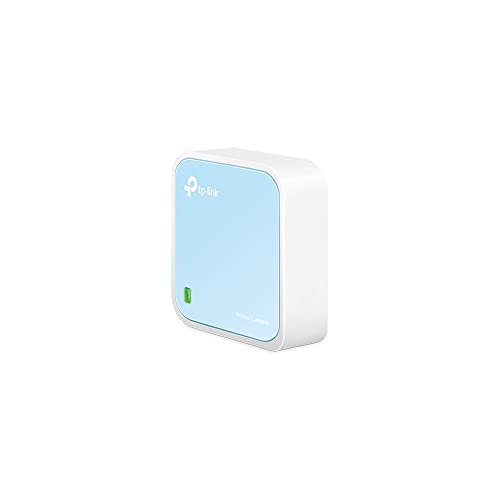
The TP-Link N300 Wireless Travel Router is the simplest travel router in the review. Simply put, it is just a travel router and doesn’t have any extra’s like file-sharing or being able to be used as a power bank.
Removing the extras makes it light, portable, and capable of getting a speed of up to 300Mbps .
The band connection also provides lag-free streaming. The travel router can be connected to a cable to create a wireless network, to a modem as an AP, used as a repeater, a booster, and as a hotspot.
It’s also compatible with Chromecast or Amazon FireStick so you can watch all your favorite movies on the go too. Being so light, it doesn’t have an inbuilt battery and you’ll need to connect it to a power source through the micro USB port.
This means you can charge it from the wall, your lightweight laptop , or a power bank, giving you Wifi internet connection where ever you are.
The setup for this travel router is incredibly easy and takes under a minute. Once set up it can be connected to by as many devices as you like but its performance does decrease noticeably with multiple devices.
Overall a simple, fast, portable, and easy-to-use router that also comes with 24/7 support and a 2-year warranty.
- A few wireless modes
- Simple to use
- No USB ports
- Struggles with multiple devices
- Size: 2.2 x 2.2 x 0.7"
- Weight: 7.2oz
- Devices: As many as you like
GL.iNET GL-AR150 Mini Travel Wireless Router

The GL.iNET GL-AR150 Travel Router is a great choice for anyone who wants a router that’s super-portable, simple, and just a router.
This little guy weighs just over 1 oz and is compact enough to slip into your pocket or purse with ease. It can create a Wifi network from just about anything except a SIM card. You can connect it to a modem, ethernet cable, or existing Wifi internet connection, or tether it to your phone or dongle via USB.
One of the best features of this travel router is its security. Traveling around the world means unsecured networks, but once you plug this baby in, you’re getting a Wifi network with a firewall, instantly.
It comes with Open VPN pre-installed and is compatible with over 20 providers, so where ever you connect, you’ll know you’re secure.
It comes without an internal battery but you can charge it from your laptop’s USB or from a wall socket. It comes with 2 ethernet ports, 64MB of RAM, and 16MB of flash. You can also increase this via USB. It’s also Open Source and programmable so you can have full control over everything.
This is an awesome travel router and for just $27, you can’t go wrong.
- 2x Ethernet port
- Tethers to your mobile phone
- Programmable
- Light & compact
- Tricky to set up
- Only supports 2.4GHz
- Size: 2.28 x 2.28 x 0.98"
- Weight: 1.59 oz
Huawei E5576-320 4G LTE Travel Router

The Huawei E5576-320 Travel Router is a good option if you need a compact but reliable device. It needs a SIM card to work, and then it turns into a mobile hotspot that can be used by up to 16 devices at the same time. With a battery of 1500 mAh, you can use this device for up to six hours at a time, before it needs to be recharged.
The battery life could certainly be improved, but at least you can use this device while it’s charging, so you can just keep it plugged into a power bank. Also, the Huawei router boasts a removable battery. Carrying an additional battery is always an option since it means you can just replace the original one when it runs out of juice, without needing to disconnect from the WiFi.
This travel router supports 3G and 4G mobile bands – it’s compatible with 4G LTE in Europe, Asia, and Africa, but only the 3G will work in the USA, Mexico, and Canada. You get download speeds up to 150Mbps on 4G, and up to 43.2Mbps on the 3G networks. Upload speeds are not that bad either – it’s up to 40Mbps on the 4G network, and up to 5.76Mbps on 3G.
In case you need something for travel in North and South America, you should check out Huawei E5576-508 mobile hotspot, which was made specifically for that market and has better compatibility with mobile phone carriers in the Americas.
- Compact and lightweight
- Great upload and download speeds on 4G LTE
- Not expensive
- Works while charging
- Supports connections to up to 16 devices simultaneously
- Small battery capacity
- Only 3G LTE works in the USA, Mexico, and Canada
- Does not double as a power bank
- Size: 3.94“ x 0.28“ x 2.28“
- Weight: 3.53 ounces
- Devices: Up to 16
GL.iNet GL-AR750S-Ext Gigabit Travel AC Router

If you’re a technical wiz and looking for a travel router that’s versatile and offers you a lot of programmabilities, then the GL.iNet GL-AR750S-Ext Gigabit Travel AC Router is a great choice.
This wireless router will create a highly secure Wifi network from a modem, ethernet connection, wifi connection, dongle, and from your phone. It works over a dual-band and it’s pretty fast offering speeds up to 733Mbps.
It comes with 3 ethernet ports to give wired devices internet access. It has a USB port to open up local fire sharing. There is also an SD card slot to provide you with built-in storage space.
It’s programmable and comes pre-installed with OpenVPN and WireGuard to act as a VPN client and server out of the box.
This means your connection will be very secure no matter where you are. It also arrives configured to use Cloudflare’s encrypted DNS servers for additional security. You will have to update it to the latest firmware when you get it though.
Overall a fast, secure, and technical, wireless travel router that’s got a lot of bang for its buck.
- 3 Gigabit Ethernet Ports
- Great VPN support
- Awesome security
- Programable
- SD card slot
- Can be tricky to set up
- Size: 3.90 x 2.70 x 0.90"
- Weight: 3.03 oz
What To Look For In A Travel Router
Here are some key factors to consider when buying a great travel router.
Size & Weight
When it comes to portability both the size and weight of a router are important considerations. You’ll want it to slip easily into your carry-on luggage and not take any valuable weight or space. All the travel routers in this review are light and portable but some are much lighter and compact than others.
Another thing to consider is your travel router power source. Some travel routers come without an inbuilt battery making them very light but they will need to be plugged in to use them.
This means having a power bank ready or plugging them into your laptop’s USB port. Wifi travel routers with an inbuilt battery will be easy to carry around but you’ll need to make sure to pack the right charging cables and plug for your trip.
Travel Router Connection Options
Every router in the review will turn an ethernet, modem, or Wifi connection into your own Wifi connection but not all of them connect to a dongle, phone, or SIM card. There are a few in the review that do connect to all of these, like the ETGEAR Nighthawk M1 or the GL.iNET GL-AR150 Mini Travel Router , so if you’re wanting to use your phone or a Sim card to give you Wifi anywhere, be sure to pick s router that can do it.
Security and Encryption
In order to keep your connection secure, you want a wireless router that offers WPA2 encryption or has a built-in VPN. All the portable routers in the review provide some security but if you want the maximum, go for one of the ones with a built-in VPN.
Overall Speed & Range
Faster portable routers usually mean spending a little more. Think about the speed and the range you’re likely to need on your travels. If you’re going to need to stream HD across 5 devices or have multiple conference calls across multiple devices, you’ll need a wireless router with some solid bandwidth.
If it’s just for you to do some work on, watch a movie, and call home, then you’ll be fine with a lower speed.
Consider Extra’s
Some of the routers in the review are plain routers while others are more multi-tools. Some can also be used as a power source, for file sharing, can have in-built storage, and connect to media streaming. If you want these added benefits, be sure to choose one with them.
Our Favourite Wifi Travel Routers
Here are our top choices from the review.
The lightest travel router of them all is the GL.iNet Mango at just 1.4 ounces. It’s so small and compact that you can carry it in your pocket, but it still does everything a good router should. With download speeds of up to 300Mbps and a price of just some $30, it’s hard to find flaws in this travel router!
- 【WIRELESS MOBILE MINI TRAVEL ROUTER】 Convert a public network (wired or wireless) to a private Wi-Fi for secure surfing. Tethering. Powered by any laptop USB, power banks or 5V/2A DC adapters (sold separately). 39g (1.41 Oz) only, portable and pocket friendly. 2.4GHz ONLY
- 【OPEN SOURCE & PROGRAMMABLE】 OpenWrt pre-installed, USB disk extendable.
The best travel router is the NETGEAR Nighthawk M1 . This is one of the fastest and best multi-use travel routers on the market. It can turn anything into a fast, secure network, even a SIM card. It’s also a power bank, data sharer, and media streamer. You can have up to 20 devices all working from the same router, sharing data, anywhere, even at the beach.
- Share WiFi internet access with up to 20 devices
- Connect to your existing home router using the Gigabit Ethernet port for fast, reliable primary or backup Internet connection. Ideal for homes with poor internet service or coverage
The best travel router on a budget is the GL.iNET GL-AR150 Travel Router . This router is tiny, light, compact, and very secure. It can turn anything into a secured VPN, even your phone’s 4G signal and it’s just $27.
- 【WIRELESS MOBILE MINI TRAVEL ROUTER】 Convert a public network(wired/wireless) to a private Wi-Fi for secure surfing. Create a secure Wi-Fi hotspot quickly. Tethering, 3G/4G USB Modem Compatible. Powered by any laptop USB, power banks or 5V DC adapters (sold separately). 39g (1.41 Oz) only, portable and pocket friendly.
- 【OPEN SOURCE & PROGRAMMABLE】 OpenWrt/LEDE pre-installed, backed by software repository. DDWrt supported. USB disk extendable.
- Overview Guide
- 1 Week Itinerary
- Train Journeys
- Epic Drives
- Stunning Lakes
- Historic Castles
- Lauterbrunnen
- Grindelwald
- Chocolate Tours
- Swiss National Park
- Majestic Mountains
- Spectacular Waterfalls
- Famous Things
- Tasty Fondue
- 10 Day Itinerary
- Cherry Blossoms
- Tokyo Shrines
- Dos and Don’ts
- Osaka Guide
- Osaka Itinerary
- Osaka or Kyoto
- Kyoto Day Trips
- Matsumoto Castle
- Tokyo Luxury Hotels
- Island Hopping
- Best Campsites
- Driving Tips
- Beaune, France
- Barcelona Itinerary
- Spain Itinerary
- Greece Itinerary
- Italy Road Trips
- Berlin Day Trips
- Norway Northern Lights
- Netherlands National Parks
- Mostar, Bosnia
- Best Airlines
- Midwest Ski Resorts
- Florida RV Parks
- Washington RV Parks
- Oregon RV Parks
- Utah Camping
- Texas Camping
- Chicago National Parks
- East Coast National Parks
- Colorado National Parks
- Joshua Tree
- Yellowstone
- Alberta Hikes
- Flashlights
- Water Filters
- Sleeping Pads
- Solar Lanterns
- Tent Brands
- 4-Person Tents
- 4 Seasons Tents
- Backpacking Tents
- Beach Tents
- Cabin Tents
- Multi-room Tents
- Pop-up Tents
- Truck Bed Tents
- Underwear (Men)
- Backpacks Under $100
- Microspikes
- Boonie Hats
- In The World
- New Zealand
- Hardisde Luggage
- Lightweight Luggage
- Luggage Sets
- Spinner Luggage
- Durable Suitcases
- Duffel Bags
- Kids Luggage
- Teen Luggage
- Space Saving Luggage
- Business Carry-Ons
- Garment Carry-Ons
- Suitcases Under $50
- Travel Briefcase
- Zipperless Suitcases
- Rolling Briefcase
- Luggage Straps
- Luxury Brands
- American Tourister
- AmazonBasics
- Delsey Chatelet
- Anti-Theft Backpacks
- Backpacks Under $50
- Baby Carrier Backpacks
- Cooler Backpacks
- Backpacking Backpacks
- Climbing Backpacks
- Backpacks for Back Pain
- Beach Backpacks
- Hiking Backpacks
- Business Travel Backpacks
- Laptop Backpacks
- Backpacks for Tablets
- Commuter Backpacks
- Travel Backpacks (Men)
- Travel Backpacks (Women)
- Waterproof Backpacks
- Wheeled Backpacks
- Down Jackets
- Down Parkas
- Fleece Jackets
- Hardshell Jackets
- Rain Jackets
- Softshell Jackets
- Eco Friendly Jackets
- Gore Tex Alternatives
- Heated Jackets
- Lightweight Jackets
- 3-in-1 Waterproof Jackets
- Parajumper Jackets
- Rain Poncho
- Ski Jackets
- Travel Hoodies
- Travel Jackets
- Winter Coats
- Helly Hansen
- Mammut Jackets
- Patagonia Nanopuff
- Survival Jackets
- Flower Captions
- Waterfall Captions
- Tree Captions
- Sunset Captions
- Sunflower Captions
- Rainbow Captions
- Paddle Boarding Captions
- Hot Air Balloon Captions
- Kayaking Captions
- Airplane Captions For Instagram
- Forest Captions

The Best Wifi Hotspot For Travel | 2024 Portable Wifi Travel Review
Posted on Last updated: May 21, 2024
Looking to find the best WiFi for travelers? In this portable WiFi box travel review, I’ve found the best WIFI hotspots to accompany you on your next trip .
If you are a regular reader of my blog, you will already know that my number one requirement for traveling anywhere is strong WiFi.
As a Digital Nomad , having weak-ass WiFi is a dealbreaker for me. Unless of course, I’m on a planned adventure like disappearing into the jungle for four days in search of a lost city in Colombia or going off the grid in Cuba for nine days.
So I decided it was time to test out some of the best WiFi hotspots for international travel.
Quick Overview of best WiFi Hotspots for travel
Best Overall: Skyroam Solis
Best Budget Option : KeepGo
Best for Versatility: GlocalMe G4
Best for Security: We.Stream
What is a mobile WiFi hotspot?
A mobile hotspot for international travel is a battery-powered wireless router that travels with you. These portable WiFi hotspots are designed to be lightweight and compact enough to slip into your pocket or backpack .
With the ability to connect to multiple smart WiFi devices, these WiFi hotspots bring the internet to your mobile phone , laptop , and tablet, no matter where in the world you are.
How Mobile WiFi hotspots work?
A mobile hotspot for international travel works in a way that they have tie-ups with 4G wireless carriers across the globe.
This allows for easy transition from one carrier network to another as travel the world. Meaning you don’t have to buy a new local sim card to use in the country you are in as these mobile WiFi hotspot companies let you update your network as you change countries.
Some services require you to pay a flat fee for internet connectivity. In other cases, you pay for what you use. That means you can get internet connectivity for a day, a week, or even a month based on your requirements.
Mobile WiFi hotspots can be a bit of an investment if you want to buy one. But there is an alternative, you can rent one for your trip. which can save you a lot of money if you are planning a short trip and don’t want to invest in a traveling WiFi hotspot yet. Several of the hotspots mentioned in this review have rental options where you can rent out a mobile hotspot data plans for international travel for a small fee.

Why do you need a mobile hotspot when traveling?
A portable WiFi travel hotspot is a big bonus for those looking for a secure connection while traveling or those traveling away from public WiFi.
Similar to a cellular device, portable WiFi devices for travel give you access to uninterrupted internet connectivity, enabling you to live your nomadic lifestyle , upload pics, send documents, receive emails, and more on the move.
They can also give you peace of mind when traveling to a new place where you may not have mobile phone coverage. I can’t even tell you the number of stressful situations in airports I could have avoided if I’d had a mobile WiFi device with me so I could get an Uber, pull up a map, or contact my hotel to ask for directions.
Design and Build Quality
When looking for the best international wifi hotspot, design and build quality are the two most important factors to consider.
As you are already traveling, you do not need anything bulky or fragile. WiFi hotspots for travel are designed to be carried anywhere with you so you really do need to make sure they are robust, lightweight, and that they don’t take up too much precious space in your backpack .
So, choose one that suits your traveling needs and pay close attention to size and weight.
Portable Wifi Travel Reviews
#1 skyroam solis.
With a powerful 4700 mAh battery and a patented vSIM Technology, Skyroam Solis proves to be the best WiFi hotspot for international travel.
Skyroam lets you stay connected wherever you are in the world, on any smart device.
My favorite feature of Skyroam though is that it’s a lot more than just a travel hotspot WiFi. It has multiple functionalities, including doubling up as a power bank and a camera. This in itself is a space saver which as a backpacker is always a bonus.
Skyroam Solis is a personal wifi hotspot with superfast 4G LTE embedded. Plus as I already mentioned with this device you also get a power bank and a 720p remote camera built-in. This is not your regular WiFi hotspot for travel.
As well as being the perfect travel companion the Skyroam portable wifi hotspot is ideal for home use too. You can actually see through its remote camera, which could come in handy for checking in on pets of teenagers!
Skyroam Solis offers the best of both worlds. You get a high-performance portable wifi hotspot and a quality camera/ video recorder, plus a power bank at the same time. So if you are wanting to save space in your backpack this could be your best option.
Features & Benefits
- It comes with an 8MP, wide-angle camera for live stream and recording
- Can connect up to 10 devices
- The 4700 mAh power bank keeps your devices charged throughout the day
- 4G LTE wifi offers blazing fast speeds
- SignalScan feature allows you to reset your signal anytime
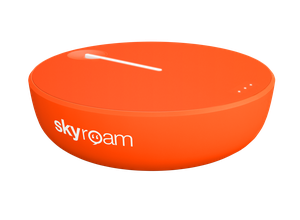
How to use this device?
Download the Skyroam mobile app on your iOS or Android device, choose your WiFi plan, and connect with your devices. It’s that easy.
You can manage your data directly in the Skyroam app.
Cost/ plans
You have a few different options here. If you don’t think you will need to use it much and prefer to pay as you go then you can do this for $12 per GB. The bonus of this is no throttling! You always get fast WiFi. The downside is $12 per GB is pretty expensive.
At the other end of the spectrum, you can get unlimited WiFi for $99 per month. This will give you high-speed WiFi for up to 20GB for 30 days. After that, it will be much slower. You can get this cheaper by pre-paying for 3 months or 6 months. So this is perfect if you are planning on traveling long term.
Another option is to pay per day. For $9 USD per day, you can get high-speed internet for 24 hours. You will need to pre-pay for so many days upfront. When you want to use a day pass then you can activate it in the app. There is throttling but this changes depending on the country.
Then the final option is to pre-pay for 1Gb per month for 3 months at a cost of $9 USD for 1GB. So you basically pay $27 USD for 3 months. This is a good option if you are just planning on using this mobile WiFi device as a backup for when you can’t find local WiFi.
You can use this mobile hotspots for international travel across 135 countries.
Speed Throttles
On the monthly unlimited plan, you can get high-speed data up to 20 GB for 30 days, slower after that.
On the day pass, you will need to check the limits on the country that you are in as each country has a different limit.
- Includes a speaker and microphone
- Secure connection
- Works well with local and international plans
- Has a number of different plans depending on your budget
- You can rent or buy a device
- Has network issues when used in very remote areas
- Available in only a single color
- The unlimited plan is expensive unless you book a few months to get the discount
- Unclear what the speed throttles are on the day passes.
Want 15% off Skyroam?
Use code: clairesitchyfeet.
The next on my list is the KeepGo hotspot that connects up to 15 smart devices in one go. This is one of my favorite portable hotspots (and the one I am personally using when I travel right now) as it gives unlimited access to internet connectivity on the go. You just top up when you run out of data.
It’s an ideal portable WiFi for road trips. If you are carrying multiple smart devices with you you can connect your laptop , tablets , and mobile phones to the internet all at the same time. It’s also incredibly easy to use. Just turn it on by pushing a button and enter the password printed on the inside cover and you are good to go.
KeepGo is one of the smallest global wifi hotspots in the world that easily fits in your pocket. It’s very lightweight and the slimline design makes it easily transportable. All you have to do is buy prepaid data and enjoy uninterrupted internet.
The KeepGo offers a high-speed 4G internet connection in over 100 countries with no throttle. You can travel the world without inducing expensive data roaming charges.
Each lifetime line comes with 1 GB of unlimited data with a 2 GB bonus data coupon.
- Lifetime pay as you go plan Access to global 4G LTE data without any filtering or throttling
- Purchased data never expires – just refill at least once a year
- One push of a button gives you access to the internet
- Comes with network and information security features

To use your KeepGo WiFi hotspot all you need to do is visit the KeepGo website and activate it. Then open your wifi settings and scan to detect KeepGo. No need to download any apps. Just activate and go.
The plan starts from $3 for 100 MB and goes up to $24 for 1 GB.
When you buy the device for $99 you get 1GB of data included.
I’ve got to be honest. If you are looking for a WiFi device to use worldwide KeepGo is probably the most expensive as to buy just 1GB is $24 USD! That’s more than double Skyroam. But if you can afford to top-up 25GB at a time at a cost of $250 USD that price per GB comes down to a more affordable $10 USD per GB.
So you may be wondering why this is my budget pick, right? Well, that’s because if you don’t need worldwide coverage, just USA and Europe you can get 1GB for \$8 USD… Making it the cheapest pay-as-you-go mobile WiFi option.
There is no contract or extra fees, but you will need to set up an automatic top-up of $8 USD per month for this plan. If/ when you run out of data you can manually top up for $8 USD, or you can set up auto top-up so you never run out of data.
This makes KeepGo the best budget option for traveling in the USA and Europe.
You can use this mobile hotspot for international travel across 100 countries.
No throttles ever!
- Supports up to 15 devices/users
- 1800 mAh removable battery
- Data you buy does not expire
- Pay as you go
- Alerts you when you run low on data
- Can set up automatic top-ups
- the smallest and most lightweight device on the market
- The cheapest option if you are traveling in the USA or Europe
- No speed throttles
- Expensive to top-up if on the worldwide plan
- Sometimes it’s difficult to turn it off and I’ve had to resort to removing the battery.
- Battery lasts for 7 hours use
- It’s so lightweight it almost feels a little flimsy. Especially compared to Skyroam and Travel Wifi which feel much more robust.
Want 10% off your KeepGo?
Use code: clsitchyfeet .
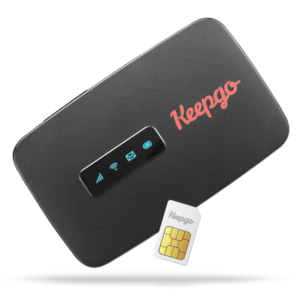
#3 GlocalMe Tri Force
Although I’ve put this as my 5th choice. I actually think that the GlocalMe Tri Force would be the travel WiFi device I would choose if I was traveling long term right now.
So what makes this mobile WiFi hotspot so special? Well, it has a drop-resistant/ anti-slip design, perfect if you are clumsy like me. It’s also a battery pack so you can charge your mobile easily while on the move. And it gets better, it will give you up to 28 hours of service. Which is impressive by any standards. I really like this device.
GlocalMe actually has several great devices to choose from including the G4 Pro , which is a SIM-free touch screen device that comes with a selection of pre-installed apps like google maps. Of the budget-friendly First G which you will need a SIM to use but at less than $70 it’s the cheapest device on the market… and it looks mightily similar to the TravelWifi device (but half the price).
What I really like about GlocalMe is the flexible plans it offers. Each device (apart from the First G ) comes with 1 GB of global data and 8 GB US data. This is enough to get you started and far more than other products on this list. Although they have a lot of different plans, they are easy to navigate and choose from, unlike other providers.
Also, if you use my discount code, you can get a 20% discount!: GMKOL20
- Very robust and has an anti-slip design
- Can connect up to 10 devices and enjoy 4G network speed
- No SIM card needed as it uses CloudSIM technology
- Can be used as a portable batteries pack to charge your other devices
- Epic battery life – 28 hours
- Comes with 1GB of worldwide data and 8GB of US data
- Comes with the GlocalMe app for easy tracking

Download the GlocalMe app on your Android or iOS device, activate your plan, open wifi settings on your mobile phone, and sync with GlocalMe wifi and you are good to go.
There are a lot of different plans available. So it’s really going to depend on where you are traveling to and for how long.
Use my discount code for a 20% discount!: GMKOL20
To give you some examples:
You can get 36 GB of data to use in North America (Canada, USA, and Mexico) for less than $200 (sometimes it’s on sale for $159).
Right now you can get 20GB of data for Europe for just over $100 USD! This is on sale as the normal price is $183 USD.
My advice is to check out their current deals here , and if you don’t see anything that works for you, sign up for their mailing list to be emailed when they have new discounts.
If you are doing a world tour this will offer you coverage in over 140 countries. Impressive.
No speed throttles! It’s pay as you go so you just top up when you run out.
- Traffic protection and blacklist management
- Flexible plans and preferential price
- Lots of amazing deals and offers to save money
- Several different devices to choose from
- Ideal for traveling , working , studying, etc
- Particularly good for travel in North America or Europe
- Multi-functional devices
- Excellent battery life
- Although you can rent a device, it’s not cost-effective
- Lesser known brand
- Can get pricy if you don’t find a good deal

#4 We.Stream
Last, but by no means least is the We.Stream . It’s a premium mobile wifi hotspot for international travelers offering a choice of multiple networks per country. In fact, it actually has the best coverage of all of the devices on this list.
What I will say though is that in all honestly, this isn’t going to be the best value travel companion for international trips. However, if you are looking for a WiFi solution for a road trip or for Van Life then this is the one I would recommend.
Why? Because if you buy your We.Stream on Amazon here , you can get 50GB of US data to be used in 3 months, plus 1GB of international data. This is a pretty decent deal. Not so great if you are planning a trip to backpack in Europe though…
I also love the fact that you can directly buy data through the touchscreen. It’s the only device on the list that this is possible. Small details!
Some other key selling points are that the We.Stream uses Cloud SIM technology that doesn’t require you to have a SIM card. It is a touchscreen model that has multiple features, such as a USB power bank, two SIM card slots for your local SIMs, and more. So if you run out of data and it’s cheaper to use a local SIM you can, or if they don’t offer coverage in the country you are visiting you can tether using a local SIM.
You can also connect up to 5 devices, not as many as other mobile WiFi hotspots. But if it’s just you and a partner 5 should be fine.
Oh, and it also has a built-in VPN.
- Comes with multiple 4G networks per country you visit
- Buy data upfront for a month, week, or even day
- Cloud SIM technology saves the hassle of setting up SIM cards
- Two additional SIM card slots for your local SIMs
- VPN for secure browsing included
- Long battery life
- Comes with 50GB of US data and 1GB of worldwide data
- Can top up directly on the device
- Doubles as a power bank
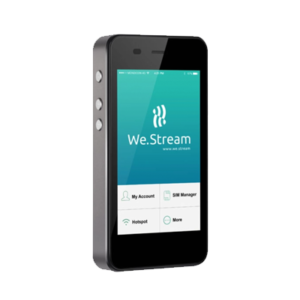
We.Stream lets you buy data through the device itself. So you just have to set up your account on the We.Stream travel internet hotspot, browse through the plans, and choose the one that suits your needs.
When you buy the device you get 50 GB US data valid for 3 months. Plus 1GB of international data.
You can check out all of the data plans for when that runs out here.
I’m not going to lie, although it’s not the most expensive, it’s also not the cheapest option if you are going to be using a lot of data. If you think you can survive on 2 GB per month for a year $250 USD isn’t a bad price to pay. But if you are going to need closer to 20GB per month then you are probably better off with Google Fi.
This is the best premium wifi hotspot for world travelers because it provides coverage in over 150 countries. That’s more than any other company.
There are speed throttles on all of their unlimited plans. So it’s important to buy enough data so you don’t get capped.
- 15 hours battery life
- No SIM card needed
- Set up a corporate VPN for added security
- Touchscreen design with 2 GB memory storage capacity
- On the expensive side
- Setting up the hotspot on the device can be tricky
other Alternative to Consider - E-SIM
If you’re an avid traveler, you know how important it is to stay connected while on the go. And while mobile hotspots have been a popular solution for a while now, e-sims are quickly gaining ground as the better option.
With e-sims, you can easily access the internet on your device without having to rely on a Wi-Fi hotspot or tethering from another device. This means you can browse, stream, and work while on the go, no matter where you are in the world.
I would recommend using Airhub or Alosim . They’re available in 100+ countries, making them an ideal option for those who frequently travel to different destinations.
There are several factors to consider when buying a portable wifi travel hotspot. From wifi support to battery life, size and weight, display, and more depending on the purpose of your travel and the need for internet connection, the hotspot for international travel should be picked.
These are my best picks but I encourage you to do your own research. My advice would be to shop around until you find the best deal. I know it can be a little overwhelming when looking for such devices.
But I am here to help. If you have any questions or concerns regarding the products discussed or anything else regarding travel, feel free to ask.
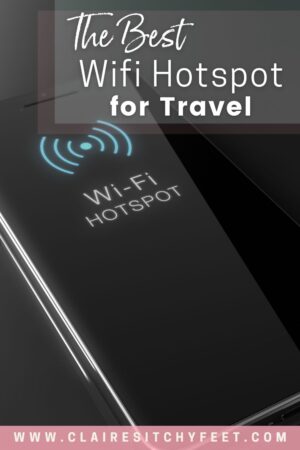
Sunday 24th of March 2024
Claire, I've been doing research on wifi hotspots today and had just about settled on the Solis unit, and your article clinched it for me. Plus you just saved me about $25 on the price, and you don't even know me. :) Well done!
Wednesday 26th of October 2022
Excellent article! I found it to be very useful, and I'm buying "Best Overall: Skyroam Solis".
Kira Mautone
Thursday 27th of January 2022
I just read through this article. This was so incredibly helpful thank you for this! I am looking into getting a travel WiFi device because I work fully remote, and was hoping to use a mobile hotspot such as this to keep me connected with high-speed, reliable WiFi anywhere so I could work effectively and travel at the same time! I am looking at traveling to Costa Rica in the near future and was wondering if you had any advice on which of these might provide the strongest connection in Costa Rica if you have experience there with one of these? I was leaning towards the TravelWiFi hotspot but would love to get your input! Thanks so much.
Claire Summers
Thursday 1st of December 2022
Hi Kira! To be honest with you, I didn't have one when I was in Costa Rica. So I don't have any personal experience with it. But I'd say Skyroam and Travel Wifi are the biggest companies so would likely have the better coverage. Hope this helps. Have an amazing time in Costa Rica!
© 2023 Claire’s Itchy Feet
Suggested companies

Travelwifi Reviews
In the Electronics & Technology category
Visit this website
Company activity See all

Write a review
Reviews 1.6.
Most relevant
BEWARE! THIS IS A FRAUDULENT COMPANY!
I rented the Sapphire Travel Wifi for my recent trip to London and Paris. Upon arriving, it worked for maybe 2 hours, then stopped working. I figured the battery might be dead, so I charged it for a few hours, but it still didn't work. I spoke to someone at their customer service, who said I should try to charge it overnight. So I did, but it still didn't work and they had no other solutions for me. For the rest of my trip, I had to pay my cell phone service a daily charge to use roaming, which was very expensive. Travelwifi told me to ship it back and they'll refund me once they receive it. I returned their device over a month ago, and I still have not received my refund even after multiple attempts to contact them. DO NOT DO BUSINESS WITH THIS FRAUDULENT COMPANY!
Date of experience : October 04, 2022
The worst service and product ever!!!!
The worst service and product ever!!!!! Do not bother! Overpriced (£105 for 14 days!!) for an ancient 200 kbps connection. I call them, they blame I used the data I bought but when I do not use it all day then try to log onto my laptop in the evening for 2 minutes the connection is equally bad. Sometimes does not connect at all. I am doing everything on 4G instead. Customer service simply ignore mails. Just shockingly bad. Never again!!!
Date of experience : August 15, 2022
DO NOT PURCHASE
I hoped there was a zero rating for this service but clearly not! I’ve been in France for 10 days and paid 170 euros for a travel wifi device from the local tourism centre. I’ve spent more than that on my 7/8 calls a day to the support team to check why the device isn’t working. It’s utterly useless. Don’t bother buying or renting. Pay fir your mobile phone provider to give you unlimited data and 4g. I have no wifi no tv and can’t work on my month long trip to France. Worst service ever
Date of experience : August 07, 2022
Don't buy wifi units from TravelWifi.
I rented wifi devices from Tep Wireless (now called TravelWifi) for my trips to England, France, Germany, Netherlands and Belgium since 2014 before free public wifi was everywhere. The service was always prompt and the data transfer rates were always enough to find directions or make calls on the fly. Since I never had a problem, I bought a unit in January 2020 for some big trips planned that year. Unfortunately things didn't go as planned due to COVID, so I didn't have a chance to use the Wifi unit until June 2023 in Puerto Vallarta, Mexico. Sadly, the unit didn't work even after many hours on the phone with TravelWifi customer service. Even though I already bought a data package, the unit kept giving me the following error, "Hi, it's AT&T. It looks like you want to use data but have none available. You may need to change to a plan that supports data for your device. To check your plan and manage your account, go to att (dot) com/myprepaid." My issue was escalated several times but no one could resolve this issue. Finally, they settled on telling me I was out of any serviceable area in Huanacaxtle, just outside of Puerto Vallarta and gave me a credit for my data to use elsewhere. My trust in this company was crushed. Then, I tried updating the firmware this year on my Sapphire 2 wifi unit (per their email notification) but had to contact customer service to verify the unit was updated. Without any purchased data packages, you can't even check the unit on your own apparently. I finally decided that I couldn't trust my TravelWifi Sapphire 2 unit to work in South Korea later this year and asked for a return/refund. I was outside of the return window even though COVID prevented travel, so I had my account deleted. My cellphone company has international data options at similar or better prices to TravelWifi, so I'm going with them or just buying a prepaid SIM in the country I'm visiting. TravelWifi was a good company as Tep Wireless but ever since the name change everything has gone downhill. Do not buy wifi units from TravelWifi.
Date of experience : February 26, 2024
Stealing from customers! Scammer!
I have been using the Wifi from them for a year to be honest the speed is really slow but acceptable. Now since half a month I do not have signal at all and they took like 10 days to find out that they cut my internet due to mistake. I asked for 50% monthly fee refund for this month but they declined. Guys, I paid the whole month but I can’t use the service for half a month. They are scammers! Please do not sign up for this company!
Date of experience : March 13, 2023
Terrible service
Terrible service We have paid €50 for five days and after we bought it, they told us we have 5 GB a day when we said we don’t want it, they said they can’t do nothing about it So 5 GB give you not even hour do 3 devices So it’s absolutely rubbish, don’t even think about getting one
Date of experience : March 20, 2023
It is soooo slow
It is soooo slow. Even in big cities and major train stations. Basically useless. The pick up and drop off also not that simple
Date of experience : September 08, 2022
- Buy or Rent Hotspots
- Trips and Tours
- Redeem Voucher
- Enterprise Solutions
- Partner Solutions
- Paris Store
- Spain Store
- Vending Machines
- PickUp & Dropoff
- $ US Dollars
- $ Chilean Peso
- S$ Singapore Dollar
- CHECK OUT LOCAL DEALS IN YOUR AREA
Select the TravelWifi site you want
Can't find your location? See all TravelWifi sites
STEP 1 2 3 4
Sign In with TravelWifi
Existing or new customers, sign up and receive 10% deal for completing registration!
Secure. Flexible. Dependable WiFi.
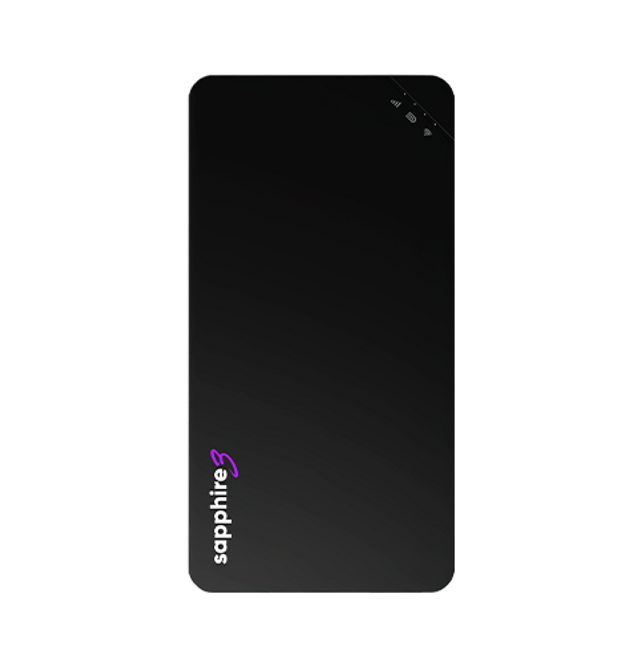
Sapphire 3 Portable Wifi Hotspot

Sapphire Power Portable Wifi Hotspot

Portable WiFi Hotspot Rental

eSIM by TravelWifi
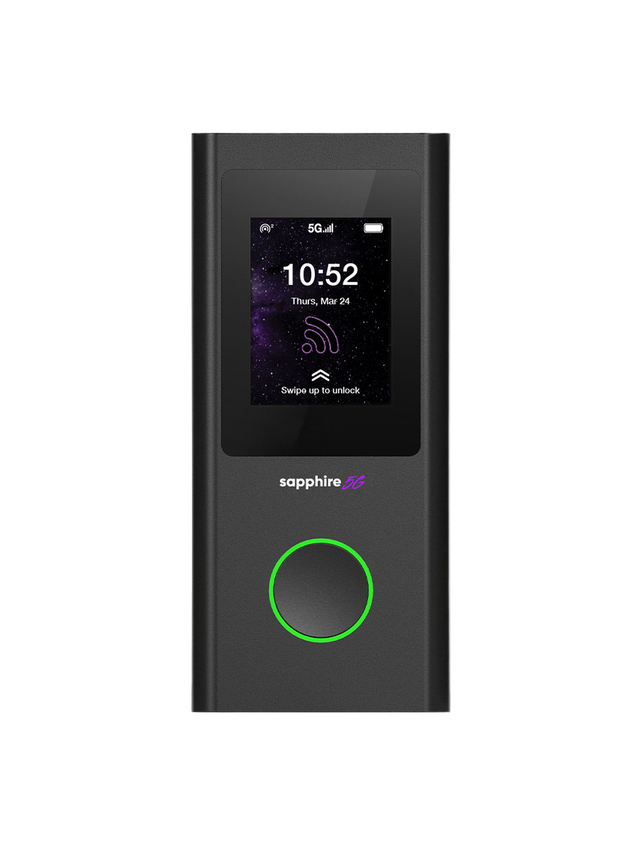
Sapphire 5G Portable Wifi Hotspot
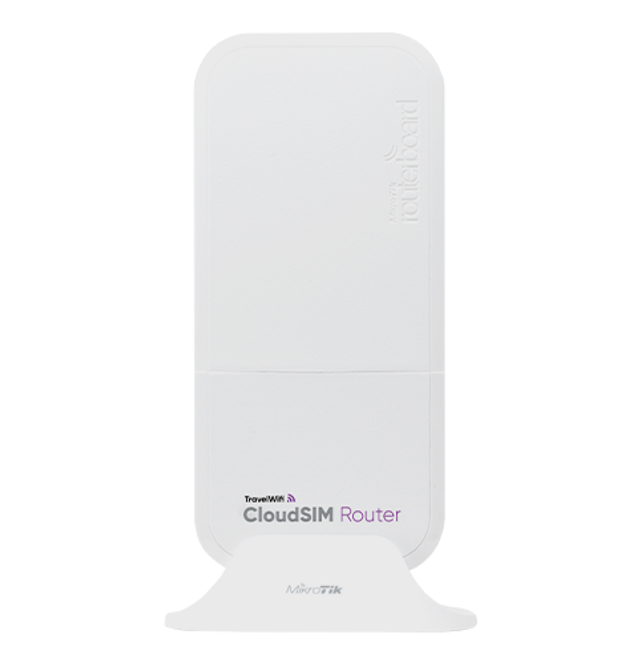
CloudSIM Router
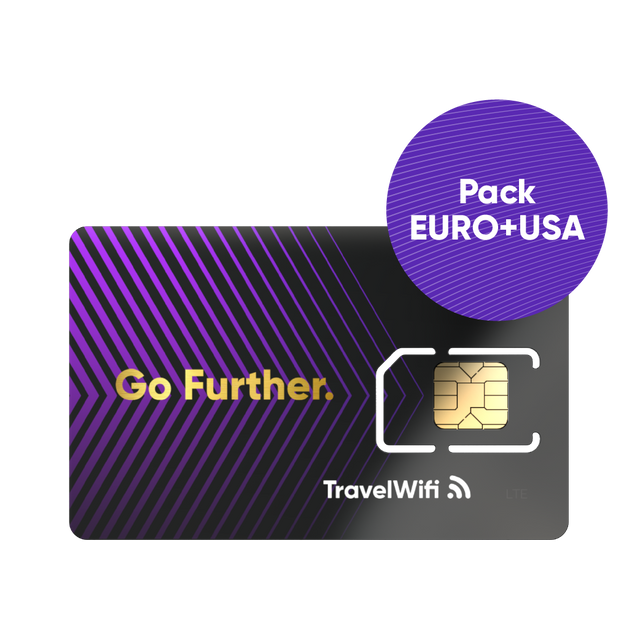
Euro+USA SIM
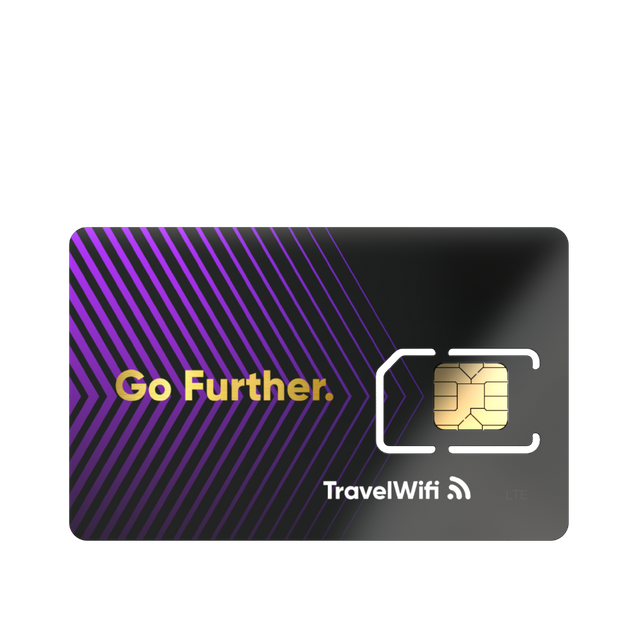
Sapphire Tablet

Global 75+ SIM
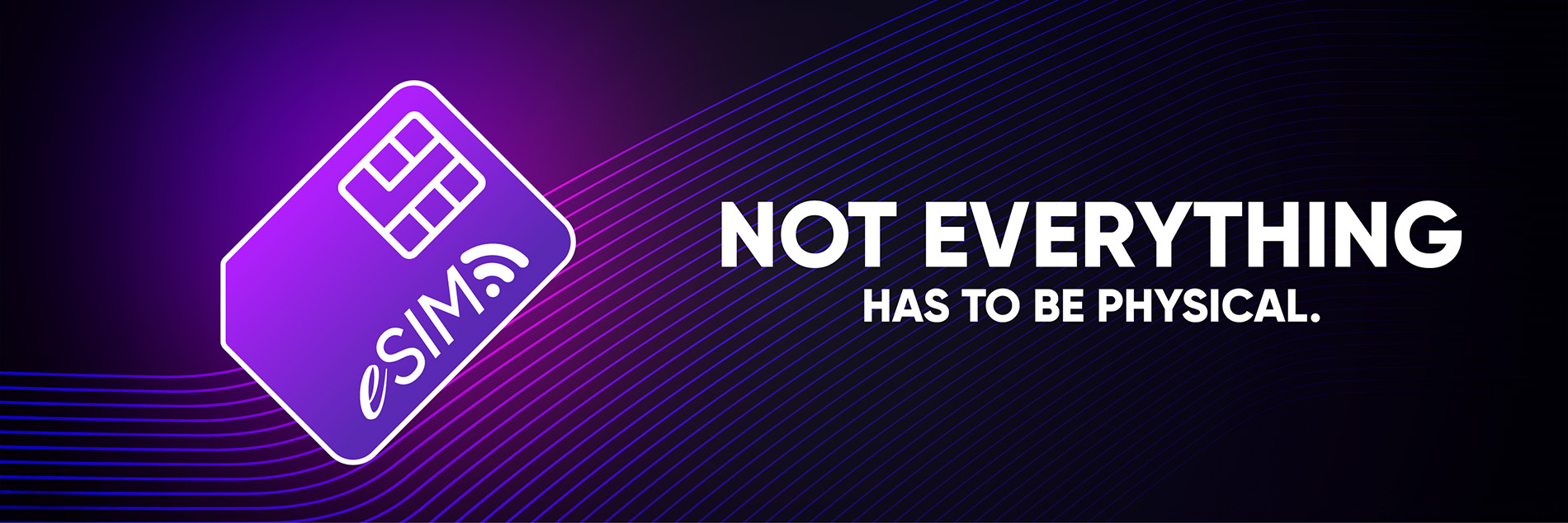
Our TravelWifi Travel Accessories
Discover our exclusive Hotels, Flights, and Car Rental deals
Sign in or Sign Up with one easy step to unlock exclusive TravelWifi Membership deals and up to 60% savings.
- car CAR RENTALS
- plane FLIGHTS
Thousands of Deals made everyday
Save more on your next hotel
Existing TravelWifi Customer Benefits:

Auto enrollment using your current TravelWifi login credentials
All tour & trips membership benefits applied instantly, new travelwifi member benefits:, deeply discounted rates with savings up to 60%, 1m+ properties in 155,000 destinations in 200+ countries and territories, major rental car brands from over 21,000 locations worldwide, connect to over 300 airlines, 2000 airports in 200+ countries and territories, flexible cancellation policies available.
DEALS FOR EVERY BUDGET
Incredible Prices on Hotels, flights, cars, and packages worldwide
BILLIONS SAVED
We've already saved travelers billions of dollars!
HOTEL & FLIGHT PACKAGES
Book together and save a bundle.
We're always here for you - reach us 24 hours a day, 7 days a week.
The Power of Possibility
For the freedom seekers. The explorers. The driven and determined. The ones who won’t let anything stand in their way. Discover what’s possible with TravelWifi’s full range of products and services.

Discover our exclusive trips and tour deals
Connecting the travelers to the world. Whether you are planning a perfect get away vacation with family & friends, or booking for your next business trip, TravelWifi can help you easily plan and book your entire trip with the widest selection of deals that offer huge savings on hotels, flights, and car rentals.

Top Destination Deals
South Africa

Explore 130+ destinations.
Taking on the World. Made Easy.
The Best Data Plan for You
TravelWifi data plans are flexible. Choose from prepaid or pay as you go options, by day, month, or data usage. We offer specific country coverage and multi-country hotspot plans, giving you internet access throughout Africa, Asia, Europe, North and South America, and Oceania. Stay connected, no matter where you go next.
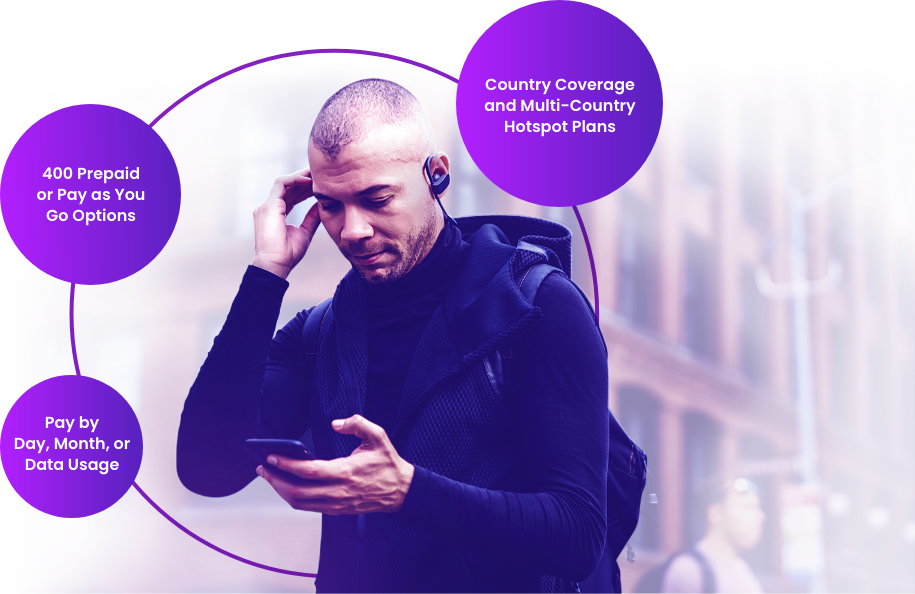
As Seen On:

See What People Are Saying

Frequently Asked Questions
We’re here to help you take advantage of every possibility. If you can’t find what you’re looking for, reach out to our customer support team anytime day or night.
We earn a commission for products purchased through some links in this article.
Best mesh wifi systems for your home in 2024
Wave goodbye to a poor network connection.

Are you struggling to get a consistent wifi signal? Or are you losing connection if you move between certain rooms?
Best mesh wifi systems

Best mesh wifi system overall
Google wifi pro.
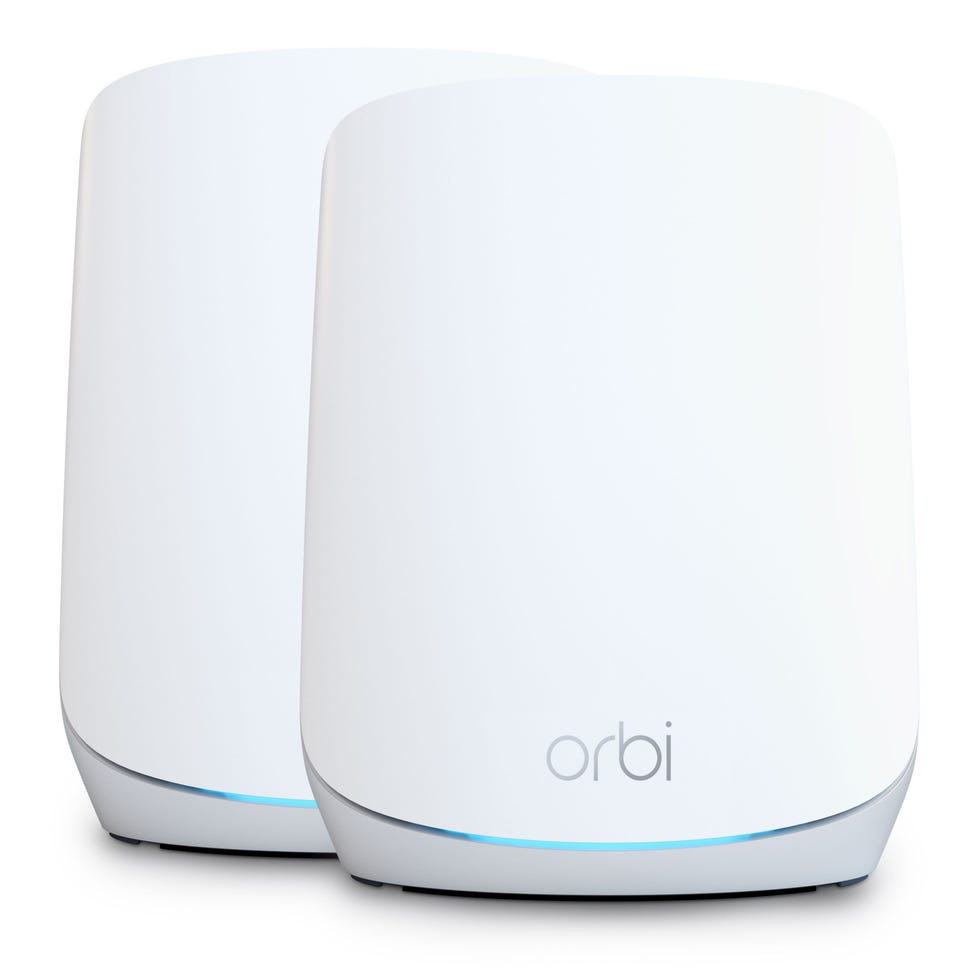
Best mesh wifi system for coverage on a budget
Netgear orbi.
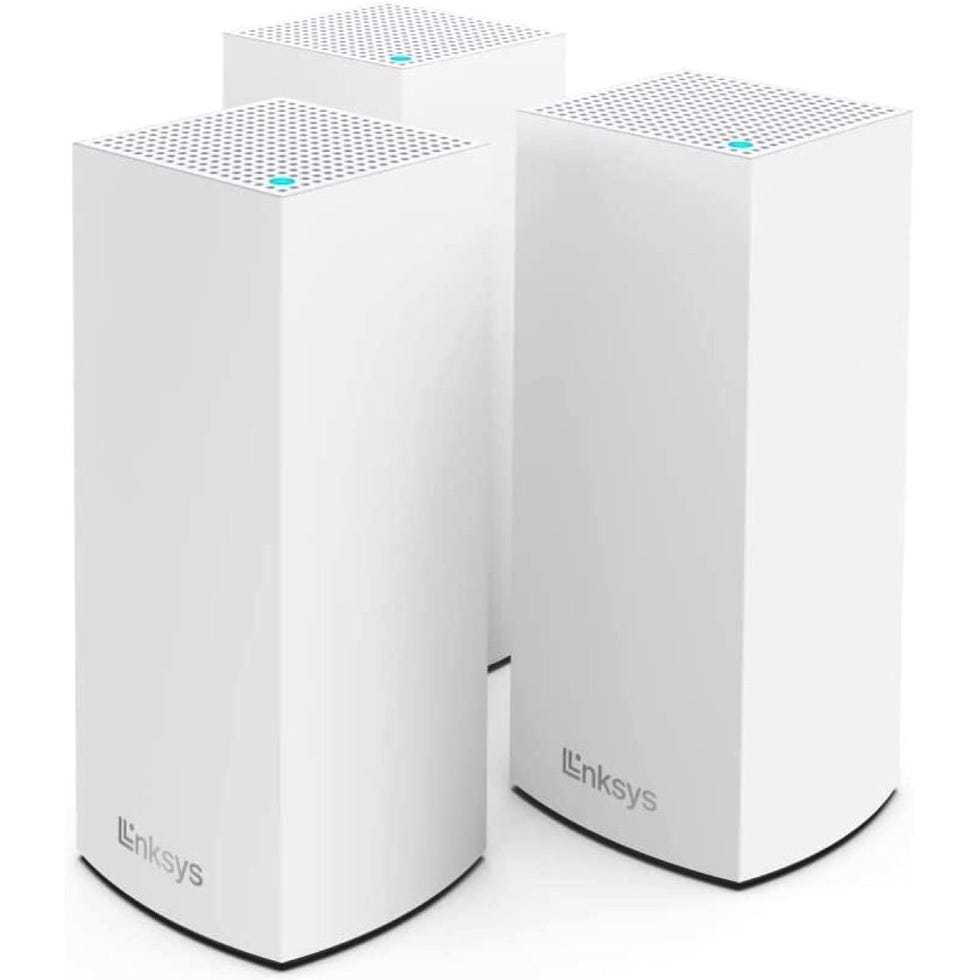
Best dual-band mesh wifi system for performance
Linksys atlas 6.
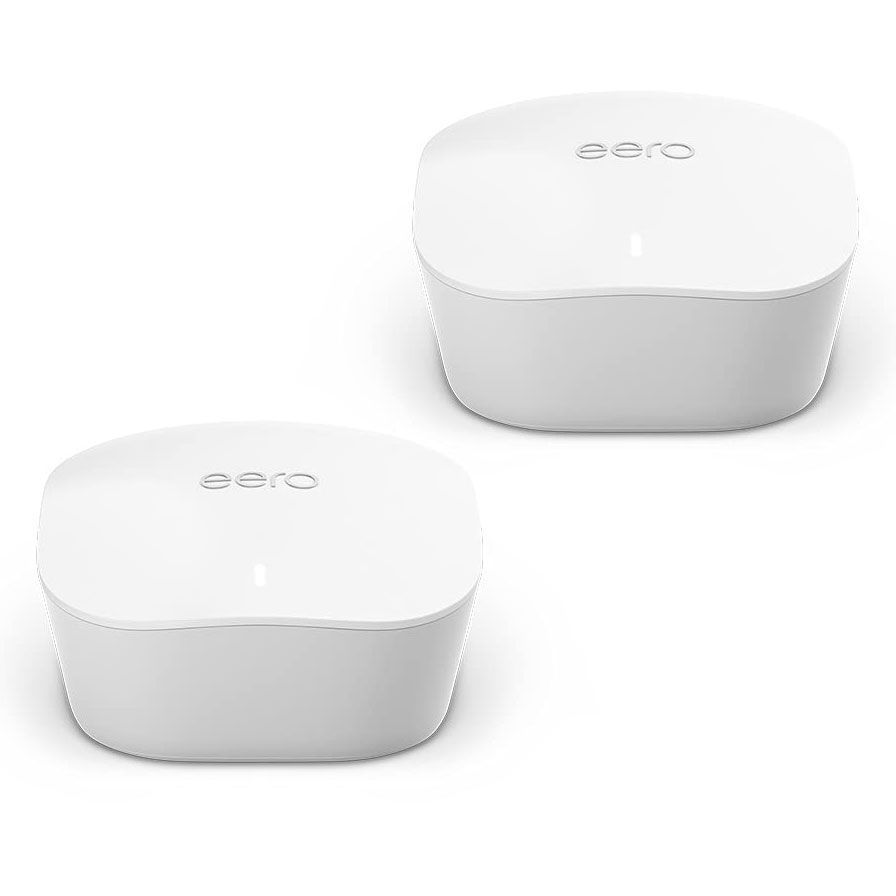
Best affordable mesh wifi system
Amazon eero 5.
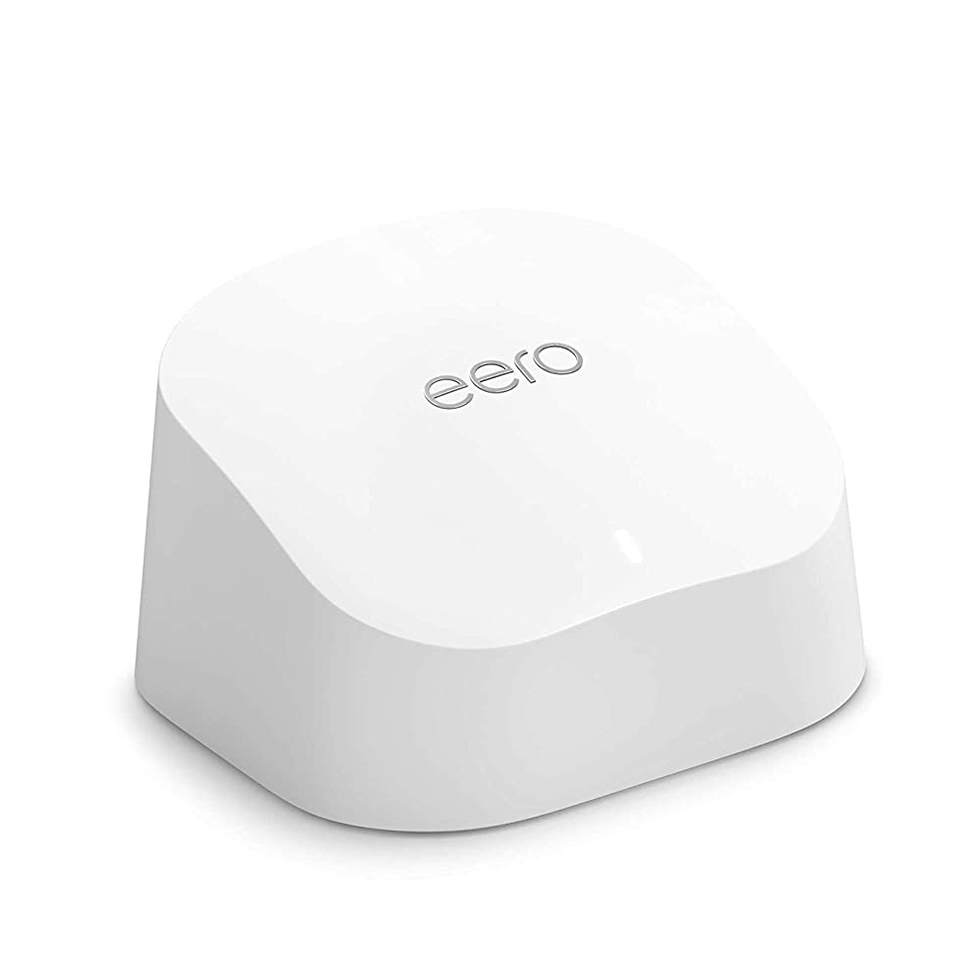
Best affordable mesh wifi 6 system
Amazon eero 6.
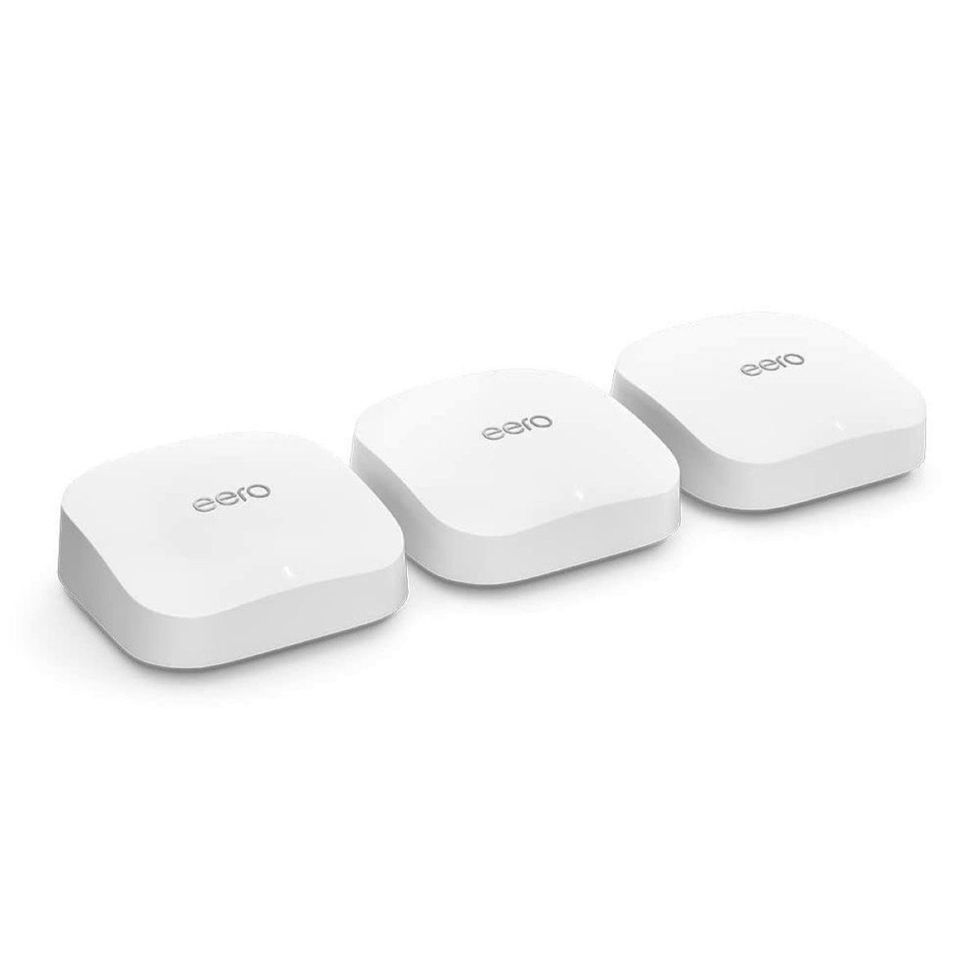
Best premium mesh wifi 6E system
Amazon eero pro 6e.
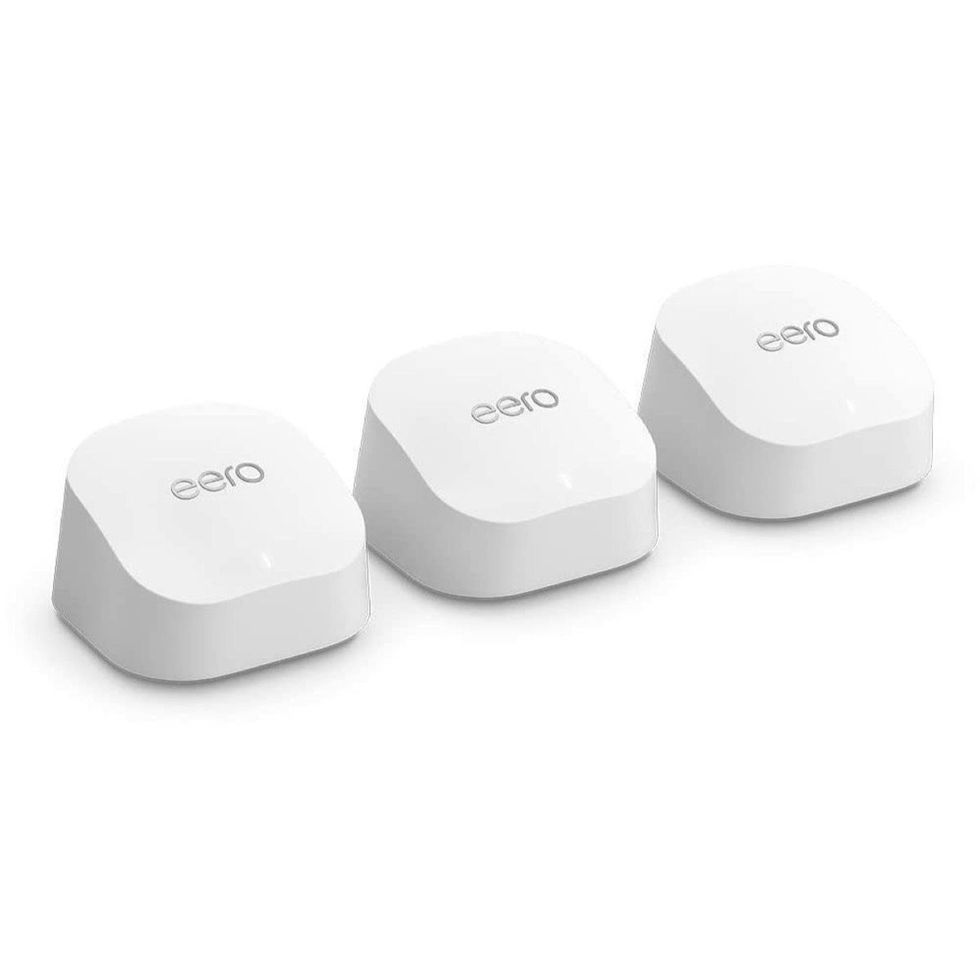
Best budget mesh wifi system for smaller homes
Amazon eero 6+.

Best budget mesh wifi system
D-link m15-3 eagle pro.

Best mesh wifi for thicker walls
Tp-link deco p9.

Best mesh system for easy setup
Tp-link deco x50 ax3000, what is a mesh wifi system.
To get a stronger connection across multiple rooms, mesh wifi uses more than one access point or node (much like your main central router) to extend the range of your wifi, syncing up to give you "bubbles" of internet around your home.
And if you’re building a smart home with multiple smart speakers , smart alarms , plugs , lights , video doorbells , and wifi security cameras , it's a great way to keep them all connected.
Love Good Housekeeping and want more of our Triple-Tested recipes, home tips, fashion inspiration, essential consumer advice and so much more delivered to your inbox? Sign up to our FREE weekly newsletters, sit back and enjoy!

How the GH Tech Team tests mesh wifi systems
Our team of testers chose the latest and best offerings from some of the biggest household name brands offering the best mesh wifi systems in the UK, including Google Nest , Amazon Eero and Netgear .
The systems were set up in a three-bed Victorian terrace house, which offers a good testing yardstick combination of size, older, thicker walls, and awkward spaces that suffer badly from poor wifi reception with the type of router you would get from the likes of Virgin Media , Sky or TalkTalk .
We used mobile apps – if available – to ease the setup process, and then tested the resulting network for speed with real-world tasks, such as streaming video , internet browsing , and light gaming .
Although home network security is a key consideration, the team didn’t specifically test security beyond noting whether controls were available. Some manufacturers offer bundled security products and packages under a separate subscription, and we've included the details in the roundup.
As you might expect from Google’s latest mesh wifi system, the understated Nest Pro packs quite the technical punch in a glossy, pebble-like shape that won’t be an eyesore once installed around the home. The units are the size of a large cup, which makes them easy to place where needed, and they won’t stand out any more than a typical smart speaker.
The Nest Pro’s radios support tri-band frequencies including the newest wifi 6E - which is, in theory, blazingly fast, but does require 6E compatible devices and high speeds from your internet service provider (ISP). This offers a strong element of future-proofing though, just as with the eero Pro 6E, but it’s worth bearing in mind that the Nest Pros are £189.99 a unit, or £379.99 for a three-pack, which is substantially cheaper than the eero. The only slight snag in this is that Google Nest Pro coverage is quoted relatively low at 120 square metres per router, so you’ll probably need that three-pack for it to work effectively. This said, during testing in a three-bed Victorian terrace we saw one unit cover most of the bedrooms and the rear of the property, and adding one more worked well for the interior, so three units should scale up to decent coverage of a four-bed house and garden.
The Nest Pro system has parental controls available through the Google Home app so you can manage devices at a granular level by creating groups. Rules can then be applied to the groups, such as scheduled downtime, website blocking, and pausing access - all of which are ideal for family homes. In addition, it’s great to have Matter support baked in. This is a new protocol that helps smart products like light bulbs, speakers and mesh wifi systems chat with each other without the need for any dedicated hubs, and having Matter built-in will help when adding new gadgets to your home in the future. We’re rating the Nest Pro the best overall, due to a combination of technical futureproofing, easy operation, relatively low price, and a lack of costly subscription to parental controls.
Key specifications
The Orbi 7 Series offers an old school ‘tri-band’ experience, in this case being one 2.4GHz band and two 5GHz bands, unlike the newer models on our list that have 6GHz band coverage too. The system consists of a router (that replaces your existing wifi router), and satellite units – and those can be increased in number as needed.
Setup is relatively easy with the Orbi app. After creating an account, you scan a QR code that is on the router and follow the instructions . The control settings are relatively basic, but this is sensible when it comes to simplifying setup, rather than providing a confusing barrage of options. The parental controls are good, but split into premium and non-premium features. With the non-premium, you get to control access, create profiles and ‘pause’ the kids' internet, which is a great start. The more sophisticated monitoring such as device usage, website history, screen time and content filtering requires a £6.99/month or £49.99/year subscription.
Performance-wise, though, the Orbi 7 Series RBK760 combination of a router unit and two satellite units delivered an excellent experience, no doubt due to the dedicated backhaul working away in the background. The units (it comes as a two-pack and three-pack ) are easy to put wherever you need them, and the 520 square metre coverage is more than good enough for most homes in the UK. You’ll need a larger house and garden to outstrip these.
A neat and rectangular mini-monolith, the Atlas 6 has a pleasing heft to it, with the weight towards the base to ensure that it remains sturdy when sitting upright. The system with three units is priced at £249.99 (the second cheapest on test) and is dual-band only, so you won’t get access to the latest wifi 6E. However, we’re glad to say that didn’t impact performance too much during our hands-on testing.
Setup with the Android Linksys app is straightforward, and it lets you manage software updates, parental controls and guest networks, and while the customisation is also accessible via a browser interface we found it to be a little on the clunky side. We appreciate that you don’t have to pay extra for the parental settings but they are basic. You can also access schedules for specific devices, and compile a URL blacklist if you want to manually block websites from children.
The light on top of the unit glows a lovely blue when all is well, purple when setup is required, and red when there’s a problem, which is a nice visual system. This comes as a single-pack , two-pack and three-pack .
Once installed, performance around our home was excellent, offering a strong connection and good speeds – more than enough for streaming – in all rooms, despite the seemingly poorer dual-band radios. At this price, the Atlas 6 offers an excellent hardware experience, only let down by the limited software features and poor web interface when compared to some of its rivals.
The Amazon Eero Mesh Wi-Fi 5 is getting on in years, a fact that is evident from the pricing, it's £190 for two units. At 9.8 x 60 cm they’re compact little devices, and they offer dual-band 2.4GHz and 5GHz connectivity. They’re not wifi 6 compatible, which restricts potential data speeds, and that’s part of the reason Amazon recommends them for speeds up to 550 Mbps. That’s relatively modest by today’s demanding standards, but might be all you need.
Coverage isn’t too shabby at 140 square metres per unit (20 square metres more than the very latest Google Mesh offering), and setup is handled via the Eero app, which is an excellent experience as we found when using Amazon’s other systems. An additional benefit is that the full Eero Plus subscription can also be applied to the Eero Mesh Wi-Fi 5, giving you powerful parental controls and a wide-ranging online security bundle – for the monthly fee.
While it’s harder to recommend this Eero model over the D-Link M15 (which is faster and has more satellite units for better coverage) this deserves a place due to the low price and is well-suited for anyone who wants to save money and doesn’t mind compromising on speed. It's available as a single-pack and three-pack .
If you want an affordable mesh wifi system to extend your connectivity, Amazon's Eero 6 is worth investigating at under £100, or just under £200 if you need two units. With this installed you can connect up to 75 devices at once (though we doubt you'll need that many), and get fast and stable internet throughout your home.
This can't cover as much of an area as some rivals in our list so this is best suited to bargain hunters who need better coverage in just one or two additional rooms or at the bottom of the garden. You can increase its coverage with extra extenders, and it’s also sold as a three-pack with one router and two extenders .
As it's Amazon-made, it's compatible with Alexa voice control, or you can navigate the controls and set parameters like switching off times, or dedicated passwords through the Eero app. It comes as a single-pack , two-pack and three-pack . But as always with the brand’s products, getting the most from it will require signing up for a paid subscription. In this case, doing so gives you extra family protections like content filters and ad-blocking, plus security apps.
Amazon’s Eero range continues to expand with this new addition, the Pro 6E. The slick trio of base stations are easy to set up via the Eero app, although as ever your mileage will vary based on your internet provider (Sky can be particularly troublesome). The Eero is fully Alexa-compatible, and we like that the overall system is modular - you can add more devices to extend coverage if you move house or decide to work from a hammock in the garden.
The big news here is that the Pro 6E supports not only 2.4GHz and 5GHz wireless bands but also the all-new 6GHz band, in theory, future-proofing the setup. We’re impressed by the coverage and speed throughout our Victorian terrace, and the additional wired sockets (two on each unit) help connect extra devices that don’t need to move regularly, such as TVs or set-top boxes .
Apart from the relatively hefty cost per unit (one Eero Pro 6E is £249, while the triple version is £549), the real disadvantage here is the monthly subscription fee, which locks down advanced parental controls, content filters, website blocking and network insights into Eero Plus, which is priced at £9.99 per month or £99.99 per year. This considerable cost does include a bunch of anti-malware and password manager tools, but you may already have these covered separately.
Amazon’s Eero 6+ is very much the little brother to the Eero Pro 6E, offering a dual-band option that’s more affordable and physically a third of the size of the bigger unit. It comes as a single-pack , two-pack and three-pack , and the overall design is updated and identical, even down to the two ethernet ports on the back, and the weight is almost halved too. Setup is straightforward using the Eero app, which is genuinely easy to use and great for monitoring your network and setting parental controls.
Although we had the benefit of testing this back-to-back with the more powerful tri-band option, the little Eero 6+ delivered, and you’re unlikely to notice the difference in general use. As with the Eero Pro 6E, setup with Sky (and several other internet service providers, or ISPs, including TalkTalk) involves an extra step where you need to deactivate your internet router’s wifi after setting up the Eero to avoid interference issues.
A much lower price point (£139 each, £319 for three) and a more compact form factor offsets the slower speed and lack of a 6GHz band, but the same subscription model as the more expensive model applies, and £9.99 per month or £99.99 per year is quite a commitment after the 30-day trial runs out.
The first thing to be clear about is that the D-Link M15 is one of the most affordable systems on test. Indeed, the trio of units tested here costs less than a single Nest Pro . There is a reason for this, as the M15 is an older model, dual-band, and uses the wifi 6 standard. The units themselves are barely larger than a coffee mug, and extremely lightweight too.
Setup is straightforward via the Eagle Pro AI mobile app, which lets you manage your wifi connections and check connection statuses. Parental controls are included, such as time limits for kids (pause and bedtime modes) and guest network control, although website filtering is only available using a manual blacklist. This comes as a two-pack and three-pack .
Performance is solid compared to the other mesh wifi systems on our list, with good coverage from the three units and reasonable speeds, but nothing stellar. However, at the price point that’s an impressive feat, and the performance is good enough for both streaming and gaming. We also like that there are no extra subscription costs, unlike the Amazon models. Overall, the M15 is ideal if you need a no-frills home mesh system – just don’t expect the latest speeds.
If you have a home with thick walls, the TP-Link Deco P9 combines a mesh network with powerline adapters, which use your home’s electrical wiring to transmit the internet signal.
In our tests, we found this mesh system (consisting of three units) matched the performance of some of the best mesh networks, and there was very little degradation in wifi speed in all rooms inside the property. It wasn’t as successful when it came to extending this strong signal to the end of a 50-foot garden, however, and in our tests we saw the speed decrease to around 10Mbps.
The units (which come as a two-pack and three-pack ) are tall and don’t look as attractive or discrete as some of the other models on our list, but it does a good job of removing wifi dead spots. Like the other TP-Link models on our list, you can use the Deco mobile app to help with the initial installation and access parental controls, create user profiles, check connection speeds and set website filters. And like the Amazon models, it’s fully compatible with the Alexa voice assistant, so you can control the mesh wifi system using voice commands.
The TP-Link Deco X50 is available individually and in packs of three, and integrates with a wide range of TP-Link Deco routers. The design is quite stylish, and on test we liked that the units are weighted so that connecting cables is an easier process than on some featherlight units.
A set of two Deco X50 units (£109.99 each, or two for £209.99) create a standard dual-band mesh structure and are set up via the TP-Link Deco app (a web browser option is available, but not for actual setup). The X50 home unit connects to a standard broadband router via an ethernet cable and supports up to 150 devices.
The setup process has been deliberately simplified by TP-Link to smooth the journey, and we found it to be quick overall. The performance is decent, and the coverage is good considering there were just two units in our test setup, although peak speeds drop quite quickly as you move away from the unit. This is available as a single-pack , two-pack and three-pack .
TP-Link’s security and parental controls are wrapped into a package dubbed Homeshield, which has free and premium versions. The premium is £5.99 a month, or £53.99 for the year, and adds more sophisticated functionality to both security and parental controls, the latter being quite basic and mainly manual without spending extra. Overall, the Deco X50 system is reasonably priced and delivers an easy-to-use experience, as well as a lot of flexibility when combined with the wider Deco ecosystem, which includes mobile-broadband-only routers.

Where do I put mesh wifi?
Mesh wifi unit positioning can be something of an art, depending on the property that is being ‘meshed’. The obvious aim is to eliminate dead spots in your home’s wifi network, which you’ll already be very familiar with. These may be whole floors, the garden, or segments of the property thanks to an inconveniently placed supporting wall or two.
Having a rough idea of these problem areas before beginning your mesh journey is wise, as is having a rough idea of the total square meterage you’re looking to cover. Most systems state a coverage area, which will provide a rough rule of thumb and will highlight if there will be challenges. Very long gardens can be an issue, for example, even with optimal placement of units.
That said, the first node normally will need to be relatively near your ISP’s router, and the one or two satellites in a standard two or three-pack would be best placed on different floors to offer maximum coverage. Bear in mind that units would theoretically be best placed in the middle of a floor to give maximum connectivity inside the building.
But to get coverage outside – in the garden for those summer WFH meetings – a unit near a window or edge of the building will be required (and may need a bit of planning).
Indeed, every property will have slightly different characteristics, so be prepared to shuffle the satellite units around a little to smooth out any flat spots - especially with cheaper dual-band systems.
Can mesh wifi improve speed?
The short answer to this is yes… and no. Mesh wifi systems will (or should) ensure that the internet speed your router can deliver is the one that arrives at your laptop, phone or other devices around the home. Usually, this isn’t the case, as the wifi signal will degrade the further from your router you go, and other factors like walls and floors get in the way. This loss of signal will reduce speeds.
However, if your ISP is providing a poor connection (or you’re on a cheaper, restricted package), then the mesh system won’t cover this up and increase your connection speed by magic.
What’s the difference between a mesh wifi network and a wifi extender?
You might have also heard of wifi range extenders (also known as wifi repeaters) which plug into a power socket and extend the distance your main router can offer internet. The biggest difference between a mesh wifi network and a wifi extender is usability.
A mesh wifi system is designed to be easy to set up and will replace your existing wifi network with a ‘bubble’ of wifi that should eliminate dead zones and flat spots throughout your house and garden.
An extender will just relay your existing network connectivity into a single area, and will by default be a different wifi network, forcing your devices to switch between the two.
It is possible to configure an extender to mirror your existing network, but this will require some fiddling to get right and may need tweaking in the event of a power cut, or similar.
In short, if you’re looking for an overall solution to variable wifi quality in a larger home or have lots of devices around the house, a mesh wifi system will solve your issues without extended faff and hassle.
How do I choose the best mesh wifi system?
Before you buy, it's worth knowing that a mesh wifi system is a bit more intimidating than the traditional wifi routers you'll be used to. And they're more complex, requiring you to spend a bit more time on setup and in an app tinkering with settings.
However, it can feel like a substantial upgrade too, so it's worth paying attention to the following key factors to find the best mesh wifi system for your needs:
A mesh wifi system should cover an area of at least 2,000 square feet but some cover more. You’ll need to figure out how much space you’ll need to be covered including any outdoor areas you want to connect in like balconies or gardens.
The number of node units
You can get anywhere between one and three nodes for most models. How many you need will depend on several things, including where in your home your wifi hub is situated.
Coverage areas are a useful indicator of potential performance, but the variations in different buildings will have a vast impact on these. Overall you’ll want two units for larger flats and apartments, and three for smaller houses. Most systems allow you to connect more units if necessary, so if your mansion proves particularly wi-fi-resilient, adding more units will solve the problem.
As explained above, the speed delivered by your mesh wifi system is theoretical and will be split across the bands. The maximum speed the best mesh wifi systems can achieve currently usually ranges between 1,000Mbps and 3,000Mbps, but some go to as much as a blazing-fast speed of up to 5.4Gbps. For most of us, the maximum speed offered on your line won’t reach anywhere close to this, but a higher total speed device is better for faster speeds overall.
Dual or tri-band
Modern routers broadcast wifi networks on at least two different bands: 2.4GHz, which is good for long distances but can be slower, and 5GHz, which offers faster speeds but only covers shorter distances.
All mesh wifi networks come with both 2.4GHz and 5GHz (called dual-band), but some have two 5GHz bands and a 2.4GHz band (known as tri-band). This means the access points can exchange information about the wifi network between each other using one band, freeing up the other two to keep your internet consistent.
Confusingly, newer mesh systems with wifi 6E (more on that below) offer 6GHz band coverage as well, in some cases also calling this ‘tri-band’. It’s worth checking exactly which of these options you’re dealing with.
Wifi 6 support
What is wifi 6? This new internet connection standard uses different tech to ensure it’s as fast and efficient as possible. Only newer devices support this standard (while older devices use wifi 5) but if you’re looking to future-proof your wifi network and plan to upgrade your laptops and smartphones soon, it may be worth getting a mesh wifi system that supports wifi 6.
We’d suggest getting at least a wifi 6-compliant network (although we still recommend some more affordable wifi 5 models), and the very latest releases have upgraded this to wifi 6E, which can deliver speeds up to 2x faster than wifi 6.
Wifi 6E support
Intrigued by wifi 6E? This is the latest wireless standard and can boost speeds by opening up a 6GHz channel (cutting out interference from devices connected to 5GHz and 2.4GHz channels) but the downside is that not many devices (like your iPhone 14 , PlayStation 5 or even your internet router) support it at this stage. Those that do are still expensive but are likely to become more affordable over time.
Subscriptions
A key element when choosing the best mesh wifi system is whether there are any ongoing costs, which many manufacturers have incorporated, especially for arguably essential functions like parental controls.
We’ve highlighted these in particular, especially as some of the more expensive subscriptions bundle in other online security tools as well, which you may already be paying for through other providers.
Parental controls
As mentioned above, most mesh wifi systems have tools to manage the network built into smartphone apps so you can adjust the settings. This includes parental controls that let you pause the internet. That's ideal if you don’t want family time to be interrupted by phones. Mesh systems also offer the option to set up guest networks, so you don’t have to give visitors your main password.
Voice integration
The majority of mesh wifi networks work with Google Assistant or Amazon’s Alexa and allow you to turn on guest networks or pause the internet simply by asking your smart speaker. Some mesh systems have the voice assistant built into their access points too, so you don’t need a separate smart speaker.
Make sure you choose a mesh network that’s compatible with the current voice assistant you use. You also can find mesh systems that work with HomeKit – like this Linksys model – but there are fewer of these .

@media(max-width: 64rem){.css-o9j0dn:before{margin-bottom:0.5rem;margin-right:0.625rem;color:#ffffff;width:1.25rem;bottom:-0.2rem;height:1.25rem;content:'_';display:inline-block;position:relative;line-height:1;background-repeat:no-repeat;}.loaded .css-o9j0dn:before{background-image:url(/_assets/design-tokens/goodhousekeeping/static/images/Clover.5c7a1a0.svg);}}@media(min-width: 48rem){.loaded .css-o9j0dn:before{background-image:url(/_assets/design-tokens/goodhousekeeping/static/images/Clover.5c7a1a0.svg);}} Gadget Reviews
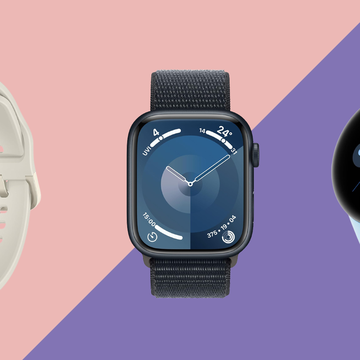
Best video doorbells 2024
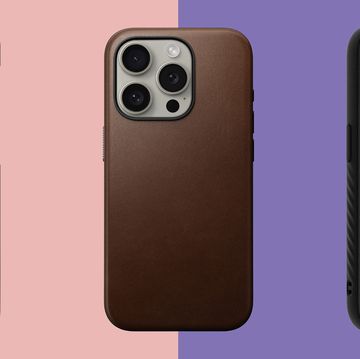
Best iPhone cases for the 14 and 15

Best Kindles for 2024

The best printers of 2024

Best tablets to buy in 2024

Best iPads in 2024

Best budget phones for 2024

Best wireless over-ear headphones

Sonos Ace headphones review

Review: Sonos Era 100 smart speaker
Review: Google Pixel 8a smartphone
The Caledonian Edinburgh

View prices for your travel dates
The Caledonian is one of Edinburgh’s most significant landmarks. Standing proudly at the West End of Princes Street, this former Victorian railway building hotel nestles in the shadow of the imposing Edinburgh Castle. Its reputation for style and excellence has attracted international visitors and notable personalities for over one hundred years.
Admire some of the best views in Edinburgh from our 231 guest rooms and suites and dine at award-winning restaurants, Grazing by Mark Greenaway and Dean Banks at The Pompadour.
At The Caledonian Edinburgh, experience the grandeur of The Lounge, formerly the station concourse and ticket office, now a haven for afternoon tea and elegant evening drinks. Treat yourself to some of the finest Scottish whiskies and signature cocktails at The Caley Bar, or indulge at the Spa at The Caledonian, a sanctuary of luxury and relaxation, home to a luxurious swimming pool, sauna, steam room, whirlpool, and two gyms.
- Excellent 3,768
- Very Good 1,167
- Average 633
- Terrible 175
- All languages ( 6,033 )
- English ( 5,639 )
- Chinese (Sim.) ( 95 )
- Chinese (Trad.) ( 94 )

Own or manage this property? Claim your listing for free to respond to reviews, update your profile and much more.
The Caledonian Edinburgh - Updated 2024

Language Translator Device No WiFi Needed, Two-Way AI Voice Translator... › Customer reviews
Customer reviews.

Language Translator Device No WiFi Needed, Two-Way AI Voice Translator for All Languages, 139+ Language Online Translation, Newest 4" HD Offline/Photo Translation for Travel/Business/Study
Customer Reviews, including Product Star Ratings help customers to learn more about the product and decide whether it is the right product for them.
To calculate the overall star rating and percentage breakdown by star, we don’t use a simple average. Instead, our system considers things like how recent a review is and if the reviewer bought the item on Amazon. It also analyzed reviews to verify trustworthiness.
There was a problem filtering reviews right now. Please try again later.
From the united states.
There was a problem loading comments right now. Please try again later.
- ← Previous page
- Next page →
Questions? Get fast answers from reviewers
- Amazon Newsletter
- About Amazon
- Accessibility
- Sustainability
- Press Center
- Investor Relations
- Amazon Devices
- Amazon Science
- Sell on Amazon
- Sell apps on Amazon
- Supply to Amazon
- Protect & Build Your Brand
- Become an Affiliate
- Become a Delivery Driver
- Start a Package Delivery Business
- Advertise Your Products
- Self-Publish with Us
- Become an Amazon Hub Partner
- › See More Ways to Make Money
- Amazon Visa
- Amazon Store Card
- Amazon Secured Card
- Amazon Business Card
- Shop with Points
- Credit Card Marketplace
- Reload Your Balance
- Amazon Currency Converter
- Your Account
- Your Orders
- Shipping Rates & Policies
- Amazon Prime
- Returns & Replacements
- Manage Your Content and Devices
- Recalls and Product Safety Alerts
- Conditions of Use
- Privacy Notice
- Consumer Health Data Privacy Disclosure
- Your Ads Privacy Choices
Satechi 3-in-1 Foldable Qi2 Wireless Charging Stand review: The perfect MagSafe charger for home and travel
I'm keeping Satechi's new wireless charging stand on my desk, and it's coming with me on every trip.
Quick Links
Pricing and availability, what i like, what i don't like, should you buy the satechi wireless charging stand.
Satechi makes some of the best third-party accessories for Apple accessories you can find, and the company released a collection of new multi-device wireless chargers this year. I've spent a few weeks with the Satechi 3-in-1 foldable wireless charger, and it's a device that aims to charge all your mobile Apple products at home and on the go. Usually, devices like these are either great for travel or great on your desk, but very few are good at both. Before trying out this new charging stand, the wireless charger on my desk was an older 2-in-1 charging stand from Satechi, and I bought that one with my own cash. After testing a few wireless chargers from competitors like Casetify and ESR, I've yet to find one that can unseat my trusty Satechi stand.
Sure enough, Satechi's new foldable 3-in-1 wireless charger makes me want to toss my old 2-in-1 stand and never look back. It's stylish, featuring a space gray aluminum build with hints of black vegan leather and plastic. This charger has perhaps the cleanest 3-in-1 implementation I've seen yet, because the Apple Watch charger is hidden behind your phone, and it can be folded away when not in use. That also means your iPhone can use StandBy Mode . It supports Qi2, so it'll work with more devices than just iPhones in the future. Of course, we can't forget this charger's namesake, which allows it to fold completely flat for easy transporting. Satechi really thought of everything, and the only downsides that come with this stand are the fault of Apple and Android OEMs.
About this review: Satechi provided a 3-in-1 wireless charging stand for review. The company had no input in this article, and did not see its contents before publishing.

Satechi 3-in-1 Foldable Qi2 Wireless Charging Stand
It's my favorite wireless charger ever
Satechi's new 3-in-1 wireless charging stand is designed like an Apple product. In fact, it looks a whole lot like Apple's own Pro Display XDR stand, and feels just as premium. The entire thing folds flat to easily fit in a bag for travel, and comes with power and travel adapters included. When you're at home, the aluminum and vegan leather materials fit into any desk setup. Since it supports Qi2, future-proofing is covered, too.
- The aluminum build and vegan leather base looks stunning
- Apple Watch charger is there when you need it, hidden when you don't
- Conveniently folds down flat for travel, includes 45W power adapter and EU/UK prongs
- Lack of Qi2 support at present means Android users will have to wait
- It may be more expensive than some are willing to pay for a wireless charger
Satechi previewed the 3-in-1 wireless charging stand at CES 2024, and it released a few months later. It's now widely available from Satechi's website and third-party retailers, like Best Buy, for a price of $130. At the time of writing, this particular model isn't available on Amazon. However, Satechi sells many of its products on Amazon, so we wouldn't be surprised if the 3-in-1 wireless charging stand showed up later. It comes in one colorway, sporting Space Gray aluminum and black vegan leather. It'll work with MagSafe devices, AirPods, and Apple Watches for now. Since it supports Qi2, it'll work with future Qi2 devices.
A travel-friendly design without the compromises
There are a number of wireless chargers out there that can charge an iPhone, AirPods, and an Apple Watch at the same time. So, what makes the Satechi 3-in-1 foldable charger stand out is its design. To me, this stand takes design cues from Apple's Pro Display XDR stand. It's made out of aluminum, with versatile hinges at the base of the stand and connected to the MagSafe puck. It looks just as good as a charger that doesn't fold, and that's why I like using the Satechi 3-in-1 foldable charger.
The base of the stand, covering the AirPods wireless charging spot, features black vegan leather. It looks and feels premium, and it's a big upgrade from most wireless chargers that use hard plastic or silicone. The Apple Watch charging puck is cleverly hidden in the back of the stand until it is pulled down. This is great, because I can keep it stowed away during the day and pull it down at night when it's time to charge. I'm usually not a fan of 3-in-1 chargers on my desk, since they just take up too much valuable desk space. This Satechi charger is sleek and compact enough to change that.
It looks just as good as a charger that doesn't fold, and that's why I like using the Satechi 3-in-1 foldable charger.
Of course, the charger's flagship feature is that it can fold flat and is travel-friendly. To be clear, this setup is still thicker and clunkier than a stack of cables and compact power adapters. But if you need a charging stand that can fit into a backpack, this is it. It's also nice that Satechi includes a 45W power adapter with US, UK, and EU plugs right in the box.
Somehow, even though the 3-in-1 foldable charger should look worse than a fixed charger, it doesn't. I prefer the look of the new 3-in-1 charging stand to the older 2-in-1 version, and the black colorway will probably look better over time. After more than a year of use, my white-and-silver Satechi charging stand has a few scuffs and shows dust easily.
ESR 3-in-1 MagSafe Stand review: An unoriginal stand with one neat trick
It's great for standby mode and content consumption.
The pressure is on new wireless charging stands to support StandBy Mode, a feature that Apple added with iOS 17. When you place your iPhone on a MagSafe charger and turn it horizontally, a new widget-based view will appear. It's quite useful, especially when music or media is playing. However, the feature won't work on all 3-in-1 wireless chargers. Some that place the Apple Watch puck right beside the MagSafe puck make it impossible to rotate your iPhone for use with StandBy. Luckily, this isn't a problem with Satechi's 3-in-1 wireless charger.
Even if you don't use StandBy Mode, you'll appreciate the range of motion of the charging stand's MagSafe puck.
Even if you don't use StandBy Mode, you'll appreciate the range of motion of the charging stand's MagSafe puck. It can tilt all the way up until it is nearly completely flat, and all the way down until it is completely flat. Since it's connected to the main stand, you can also adjust viewing angles by titling the stand between zero and 90 degrees. This helps you find the perfect viewing angle while watching videos, whether you're using the phone in vertical or horizontal orientations. This is somewhere most charging stands fall short, but this one excels.
How to set up and use StandBy mode on iOS 17
There isn't much not to love about this charging stand.
I'm usually able to find a few things wrong with products — even the great ones. But the Satechi 3-in-1 wireless charging stand is really only held back by Apple and Android OEMs. This charger can power up an iPhone at 15W, AirPods at 5W, and supported Apple Watch models at 5W. That isn't anything special, and wired charging will be considerably faster. However, these are the maximum wireless charging speeds supported by each product, so there isn't anything more Satechi can do. Additionally, since Android phone manufacturers have been moving slowly toward Qi2 adoption, this stand will only work with iPhones for now.
The Satechi 3-in-1 wireless charging stand is really only held back by Apple and Android OEMs.
It's also worth noting that the Satechi 3-in-1 foldable charging stand offers less flexibility than some alternatives. This charger works great with an iPhone, Apple Watch, and AirPods, but only works best with those accessories. Something like the Belkin BoostCharge Pro 2-in-1 will be better for people who need to occasionally use that AirPods charger for other devices, like another great smartphone .
Belkin BoostCharge Pro 2-in-1 wireless charging pad review: The definitive nightstand MagSafe charger
You should buy the Satechi 3-in-1 foldable wireless charger if:
- You have an iPhone, AirPods, and an Apple Watch and want to charge them all in one place
- You travel often and want a foldable wireless charger with EU and UK plugs included
- You want a premium wireless charger that looks great, whether you're charging one device or three
You should NOT buy the Satechi 3-in-1 foldable wireless charger if:
- You have an Android phone
- You'd be fine with a cheaper charger that isn't travel-friendly
- You don't have the need for a 3-in-1 charger
Finding a great charging stand that can power up all your devices and look good while doing it is tougher than it sounds. If you want a travel-friendly charger, the search becomes even more difficult. However, Satechi made all the right design choices here, and the 3-in-1 foldable charging stand is an easy recommendation as a result. It's just as good of a product for people who don't travel with it at all as it is for people who travel often. There are no compromises made to make this charger travel-friendly, which is rare to see. I'm keeping this wireless charger on my desk, and that's the highest praise I can give.
If you're looking for a new MagSafe charger that can tackle your mobile Apple ecosystem, look no further than the Satechi 3-in-1 foldable charger. It's the only wireless charger I've tested that manages to offer a compact, travel-friendly form factor without compromising the overall experience.

IMAGES
VIDEO
COMMENTS
The service covers most global countries, with Central America and some African countries left off the list. Travel Wifi's global plan costs $11.57 per day for 500MB, and $15.26 for 1GB. That's a ...
Travelwifi (formerly Tep Wireless) is a pocket-sized WiFi device that works in many countries and lets you avoid roaming charges and slow internet. Read our honest review of Travelwifi features, speed, price, and plans.
This 4G LTE mobile hotspot router delivers a surprising amount of power and flexibility inside an affordable package. The device itself is priced under $200, and a variety of data plans are ...
My Travelwifi review covers all the places I used this device and what my experience was like! I started using the Travelwifi (formerly Tep Wireless) device back in France (in July 2019). Soon after, I used this international portable wifi device again in: Vietnam (August 2019), Canada (October 2019), Aruba (November 2019),
TravelWifi Review: Is it the Best Wi-Fi Hotspot for Travelers? TravelWifi - Usability Overview. ... The Best Wi-Fi Hotspot for International Travel" Michael J Lee. October 11, 2022 at 11:40 am. ABSOLUTELY DO NOT RENT FROM TRAVELWIFI. SHORT VERSION: Rented a unit in March 2022. Returned the unit after a week stay to the same location I ...
Shop on Amazon. The GL iNet Slate AX (GL_AXT1800) is one of the best travel routers, as it is one of the few in the market that offers Wi-Fi 6. Equipped with a 1.2GHz quad-core processor, as well as all the latest compatible WiFi 6 technologies, the GL iNet Slate tops our list of the best travel routers currently on the market.
The only real downside is that the port layout can be awkward since the USB and micro USB power ports are on the opposite side of the Ethernet port. Wireless Spec: 802.11ac | Security: WPA2 | Standard/Speed: AC750 | Bands: Dual-band | MU-MIMO: No | Beamforming: No | Wired Ports: 1. TP-Link TL-WR902AC AC750 Travel Router Review.
Huawei E5576-320 4G LTE Mobile Wi-Fi Router. This high-speed mobile router and multi-mode wireless terminal is for use in Europe, Asia, the Middle East, and Africa. The hotspot offers 16 Wi-Fi connections at a time, and the unlocked carrier connection means you can use 3G signals from any provider.
Check out the new Travel Wifi device here > About the wifi devices. The Travelwifi pocket wifi devices are small, portable devices. The standard Portable Hotspot Rental and the Sapphire 2 (for purchase) have one button and one mini-USB charging port.. The Sapphire T2, another option for purchase, has its own 5-inch touchscreen and built-in apps, like Google Maps.
Customer service was very fast but couldn't come up with a solution - so I had to book a room in a coworking place for a lot of money, because travelerswifi didn't work. There was no offer for any kind of concession by travelers wifi for the fuss (so far) Date of experience: April 15, 2023. Useful.
Becki Enright, a travel writer and blogger, shares her experience with TravelWifi, a device that provides 3G wireless internet in various countries. She explains the benefits, costs, and options of using TravelWifi for travel, and gives her recommendation.
Find helpful customer reviews and review ratings for TravelWifi Sapphire 3 Mobile Hotspot, Portable WiFi Hotspot for Travel in 130+ Countries, Supports 300 Mobile Networks, Preloaded 4GB Free Global Data and 12-Hour Battery Life at Amazon.com. Read honest and unbiased product reviews from our users.
#2) TEP Wireless / Travel Wifi / Sapphire Review 2020. TEP Wireless is a pioneer in the worldwide Internet industry and has been recommended by top travel bloggers around the world since they launched in 2011. They have proven to be one of the most popular choices amongst my readers. Recently they merged with Travel Wifi (who were formerly #4 on this list) and Sapphire — and are now all ...
A travel router is a compact little device that solves common Internet issues while traveling and offers a number of features to the on-the-go traveler who wants to stay connected. It can act as a wireless range extender, WiFi access point, and help provide extra security to your Internet connections when traveling. We review the best travel routers to help you decide which is for you!
The Best Overall. NETGEAR Nighthawk M1 Jump To Review. Lightest. GL.iNet GL-MT300N-V2 (Mango) Portable Travel Router Jump To Review. Best Travel Router for Hotels. TP Link AC750 Travel Wifi Router Jump To Review. Best On A Budget. GL.iNET GL-AR150 Mini Travel Wireless Router Jump To Review.
Partner with us to power your business. Enterprise Solutions. Connectivity solutions for your team and your bottomline. Partner Solutions. Connectivity solutions for your clients and your customers. Stores & Coverage. Stores and Coverage. Explore our worldwide locations and coverage. Paris Store.
Best Travel Routers by Category. Best Travel Router for Frequent Travelers. 1. Best Overall: TP-Link AC750 Wireless Portable Nano Travel Router. 2. RAVPower FileHub (RP-WD009) AC750 Wireless Travel Router. Best Wireless Travel Routers. 3. Best Wireless Travel Router: HooToo Tripmate Titan.
Skyroam Solis is a personal wifi hotspot with superfast 4G LTE embedded. Plus as I already mentioned with this device you also get a power bank and a 720p remote camera built-in. This is not your regular WiFi hotspot for travel. As well as being the perfect travel companion the Skyroam portable wifi hotspot is ideal for home use too.
Find helpful customer reviews and review ratings for TravlFi Journey1 LTE Wi-Fi Hotspot, RV Internet, Multiple Networks, ... If you are looking for a super simple Wi-Fi travel setup, this is it for sure! We had absolutely no issues with it what-so-ever. 12 people found this helpful. Helpful. Report
Don't buy wifi units from TravelWifi. I rented wifi devices from Tep Wireless (now called TravelWifi) for my trips to England, France, Germany, Netherlands and Belgium since 2014 before free public wifi was everywhere. The service was always prompt and the data transfer rates were always enough to find directions or make calls on the fly.
Find helpful customer reviews and review ratings for TravelWifi Sapphire 5G Mobile Hotspot, Portable WiFi Hotspot for Travel, CloudSIM Technology, Large Touch Screen, Network Congestion Monitoring, Preloaded 5GB Free Global Data, Optional Sim Card Slot at Amazon.com. Read honest and unbiased product reviews from our users.
Discover our exclusive trips and tour deals. Connecting the travelers to the world. Whether you are planning a perfect get away vacation with family & friends, or booking for your next business trip, TravelWifi can help you easily plan and book your entire trip with the widest selection of deals that offer huge savings on hotels, flights, and car rentals.
Wi-Fi extender. If you want to take a chance with the public Wi-Fi offered at some campgrounds, purchasing an extender is a way to "extend" that wireless internet signal to your RV. (Some RVs even have them built in.) But be warned, a Wi-Fi extender won't work well if the public Wi-Fi at the campground is weak to begin with.
Our team of testers chose the latest and best offerings from some of the biggest household name brands offering the best mesh wifi systems in the UK, including Google Nest, Amazon Eero and Netgear ...
The latest travel news, deals, guides and tips from the travel experts at USA TODAY. All the travel insights you need to plan your dream vacation.
The Caledonian Edinburgh. 6,029 reviews. NEW AI Review Summary. #26 of 161 hotels in Edinburgh. Princes Street, Edinburgh EH1 2AB Scotland. Visit hotel website. 1 (888) 446-6677. Write a review. Check availability.
TravelSafe Basic plan: This travel insurance plan has trip cancellation up to $10,000, and coverage for missed connections of $500, travel delay of $500, accident and sickness medical expense of ...
Find helpful customer reviews and review ratings for Language Translator Device No WiFi Needed, Two-Way AI Voice Translator for All Languages, 139+ Language Online Translation, Newest 4" HD Offline/Photo Translation for Travel/Business/Study at Amazon.com. Read honest and unbiased product reviews from our users.
Satechi's new 3-in-1 wireless charging stand is designed like an Apple product. In fact, it looks a whole lot like Apple's own Pro Display XDR stand, and feels just as premium.